A Personal Database of Academic Papers
VerifiedAdded on 2023/04/21
|66
|11290
|62
AI Summary
This project aims to develop a database management system for tracking research papers, journals, and documents read by students. It includes a GUI for easy retrieval and storage location tracking. The system will also allow students to leave comments and opinions on specific papers.
Contribute Materials
Your contribution can guide someone’s learning journey. Share your
documents today.

Running head: A PERSONAL DATABASE OF ACADEMIC PAPER
A Personal Database of Academic Papers
Name of the Student
Name of the University
A Personal Database of Academic Papers
Name of the Student
Name of the University
Secure Best Marks with AI Grader
Need help grading? Try our AI Grader for instant feedback on your assignments.
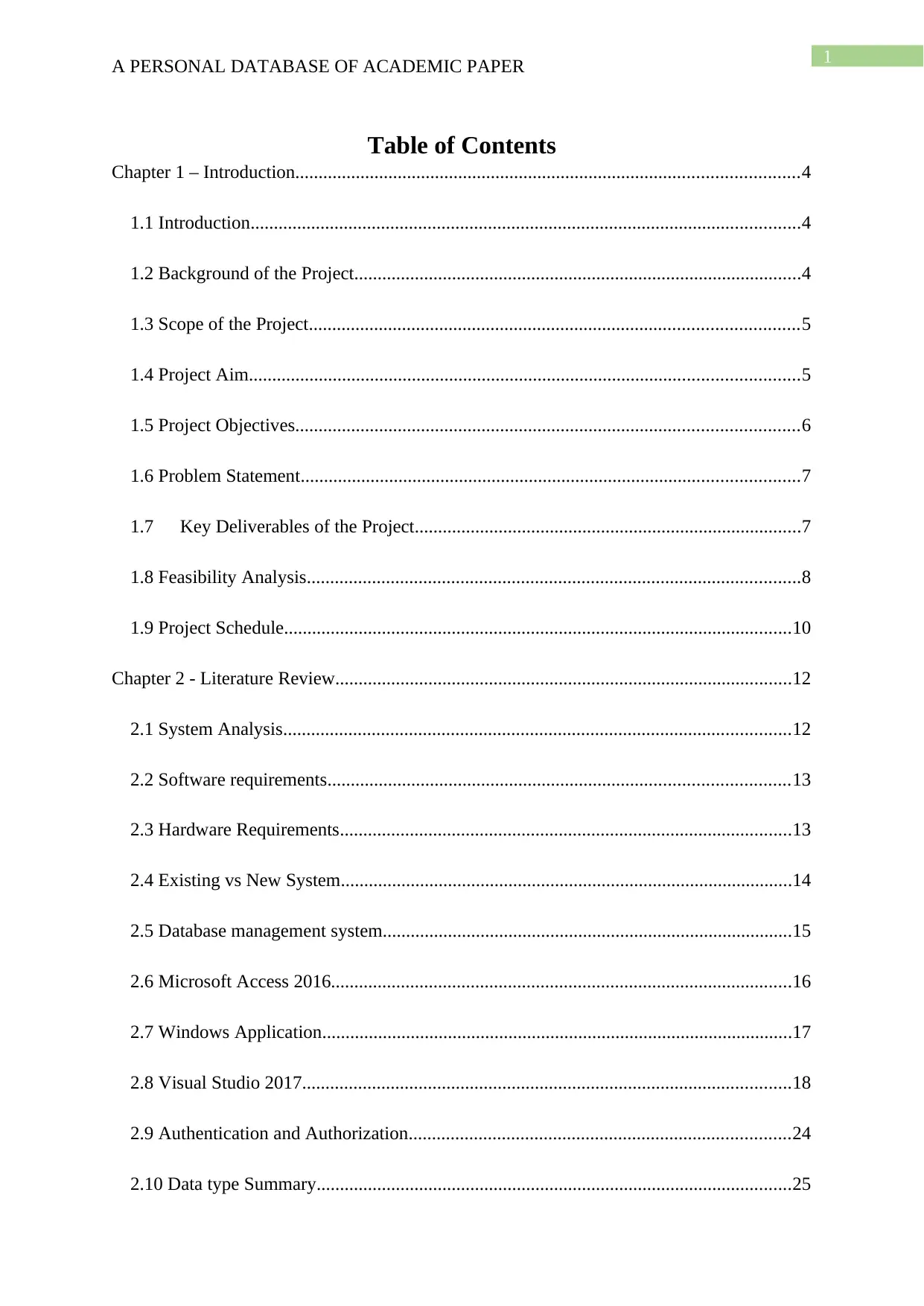
1
A PERSONAL DATABASE OF ACADEMIC PAPER
Table of Contents
Chapter 1 – Introduction............................................................................................................4
1.1 Introduction......................................................................................................................4
1.2 Background of the Project................................................................................................4
1.3 Scope of the Project.........................................................................................................5
1.4 Project Aim......................................................................................................................5
1.5 Project Objectives............................................................................................................6
1.6 Problem Statement...........................................................................................................7
1.7 Key Deliverables of the Project...................................................................................7
1.8 Feasibility Analysis..........................................................................................................8
1.9 Project Schedule.............................................................................................................10
Chapter 2 - Literature Review..................................................................................................12
2.1 System Analysis.............................................................................................................12
2.2 Software requirements...................................................................................................13
2.3 Hardware Requirements.................................................................................................13
2.4 Existing vs New System.................................................................................................14
2.5 Database management system........................................................................................15
2.6 Microsoft Access 2016...................................................................................................16
2.7 Windows Application.....................................................................................................17
2.8 Visual Studio 2017.........................................................................................................18
2.9 Authentication and Authorization..................................................................................24
2.10 Data type Summary......................................................................................................25
A PERSONAL DATABASE OF ACADEMIC PAPER
Table of Contents
Chapter 1 – Introduction............................................................................................................4
1.1 Introduction......................................................................................................................4
1.2 Background of the Project................................................................................................4
1.3 Scope of the Project.........................................................................................................5
1.4 Project Aim......................................................................................................................5
1.5 Project Objectives............................................................................................................6
1.6 Problem Statement...........................................................................................................7
1.7 Key Deliverables of the Project...................................................................................7
1.8 Feasibility Analysis..........................................................................................................8
1.9 Project Schedule.............................................................................................................10
Chapter 2 - Literature Review..................................................................................................12
2.1 System Analysis.............................................................................................................12
2.2 Software requirements...................................................................................................13
2.3 Hardware Requirements.................................................................................................13
2.4 Existing vs New System.................................................................................................14
2.5 Database management system........................................................................................15
2.6 Microsoft Access 2016...................................................................................................16
2.7 Windows Application.....................................................................................................17
2.8 Visual Studio 2017.........................................................................................................18
2.9 Authentication and Authorization..................................................................................24
2.10 Data type Summary......................................................................................................25

2
A PERSONAL DATABASE OF ACADEMIC PAPER
2.11 Process modelling........................................................................................................26
2.12 System testing..............................................................................................................27
Chapter 3: Research Methodology...........................................................................................29
3.1 Introduction....................................................................................................................29
3.2 Method Outline:.............................................................................................................29
3.3 Research Philosophy......................................................................................................29
3.4. Research Approach.......................................................................................................30
3.5 Research Design.............................................................................................................31
3.6 Data collection procedures and techniques....................................................................31
3.7 Ethical Considerations...................................................................................................32
Chapter 4 – Results and Implementation.................................................................................33
4.1 Login..............................................................................................................................33
1.2 Register..........................................................................................................................36
1.3 Menu..............................................................................................................................37
1.4 Add Books......................................................................................................................38
1.5 Update Books.................................................................................................................39
1.6 Delete Books..................................................................................................................41
1.7 Search Page....................................................................................................................43
Chapter 5 – Testing..................................................................................................................47
5.1 Authentication................................................................................................................47
5.2 Data Redundancy check.................................................................................................49
A PERSONAL DATABASE OF ACADEMIC PAPER
2.11 Process modelling........................................................................................................26
2.12 System testing..............................................................................................................27
Chapter 3: Research Methodology...........................................................................................29
3.1 Introduction....................................................................................................................29
3.2 Method Outline:.............................................................................................................29
3.3 Research Philosophy......................................................................................................29
3.4. Research Approach.......................................................................................................30
3.5 Research Design.............................................................................................................31
3.6 Data collection procedures and techniques....................................................................31
3.7 Ethical Considerations...................................................................................................32
Chapter 4 – Results and Implementation.................................................................................33
4.1 Login..............................................................................................................................33
1.2 Register..........................................................................................................................36
1.3 Menu..............................................................................................................................37
1.4 Add Books......................................................................................................................38
1.5 Update Books.................................................................................................................39
1.6 Delete Books..................................................................................................................41
1.7 Search Page....................................................................................................................43
Chapter 5 – Testing..................................................................................................................47
5.1 Authentication................................................................................................................47
5.2 Data Redundancy check.................................................................................................49

3
A PERSONAL DATABASE OF ACADEMIC PAPER
5.3 Searching........................................................................................................................53
5.4 Insertion..........................................................................................................................55
5.5 Deletion..........................................................................................................................57
Chapter 6 - Conclusion.............................................................................................................59
REFERENCES:........................................................................................................................60
A PERSONAL DATABASE OF ACADEMIC PAPER
5.3 Searching........................................................................................................................53
5.4 Insertion..........................................................................................................................55
5.5 Deletion..........................................................................................................................57
Chapter 6 - Conclusion.............................................................................................................59
REFERENCES:........................................................................................................................60
Secure Best Marks with AI Grader
Need help grading? Try our AI Grader for instant feedback on your assignments.

4
A PERSONAL DATABASE OF ACADEMIC PAPER
Chapter 1 – Introduction
1.1 Introduction
In this project, a typical database management system will be designed for ABC
University, which will be used to keep track of the research papers, journals, documents, e-
books and PDFs read by the research students (both undergraduate and master’s students).
Along with that, the database system will also store the individual comments and opinions
submitted by the research students on specific research papers, thesis and documents that they
have already read. The database management system will help identify what copies are
possessed by which students and in which locations those copies are stored. The development
of such a database system will be undertaken in this project along with the GUI (Graphical
User Interface). To be more precise, the project will focus on the development of a web
application that typically stores various academic research papers. Students will be able to
read, post comments and opinions about them and know the locations where the papers are
stored in order to retrieve them. The database will also include fields that display the specific
topics that the papers are written on. The GUI will provide users with the ability to search the
database in a variety of ways. They can also add papers they have read or want to read to the
database whenever they want.
1.2 Background of the Project
The database management system will involve a small or medium sized application.
The application will keep track of the research papers, documents and articles using a
computerized GUI by recording the details about the particular paper, along with the
comments left by the students on them, the subject or the topic of the book. The project will
focus on the detailed process to be used for designing, developing and implementing the
database system for managing the research papers. The main purpose of developing this
A PERSONAL DATABASE OF ACADEMIC PAPER
Chapter 1 – Introduction
1.1 Introduction
In this project, a typical database management system will be designed for ABC
University, which will be used to keep track of the research papers, journals, documents, e-
books and PDFs read by the research students (both undergraduate and master’s students).
Along with that, the database system will also store the individual comments and opinions
submitted by the research students on specific research papers, thesis and documents that they
have already read. The database management system will help identify what copies are
possessed by which students and in which locations those copies are stored. The development
of such a database system will be undertaken in this project along with the GUI (Graphical
User Interface). To be more precise, the project will focus on the development of a web
application that typically stores various academic research papers. Students will be able to
read, post comments and opinions about them and know the locations where the papers are
stored in order to retrieve them. The database will also include fields that display the specific
topics that the papers are written on. The GUI will provide users with the ability to search the
database in a variety of ways. They can also add papers they have read or want to read to the
database whenever they want.
1.2 Background of the Project
The database management system will involve a small or medium sized application.
The application will keep track of the research papers, documents and articles using a
computerized GUI by recording the details about the particular paper, along with the
comments left by the students on them, the subject or the topic of the book. The project will
focus on the detailed process to be used for designing, developing and implementing the
database system for managing the research papers. The main purpose of developing this
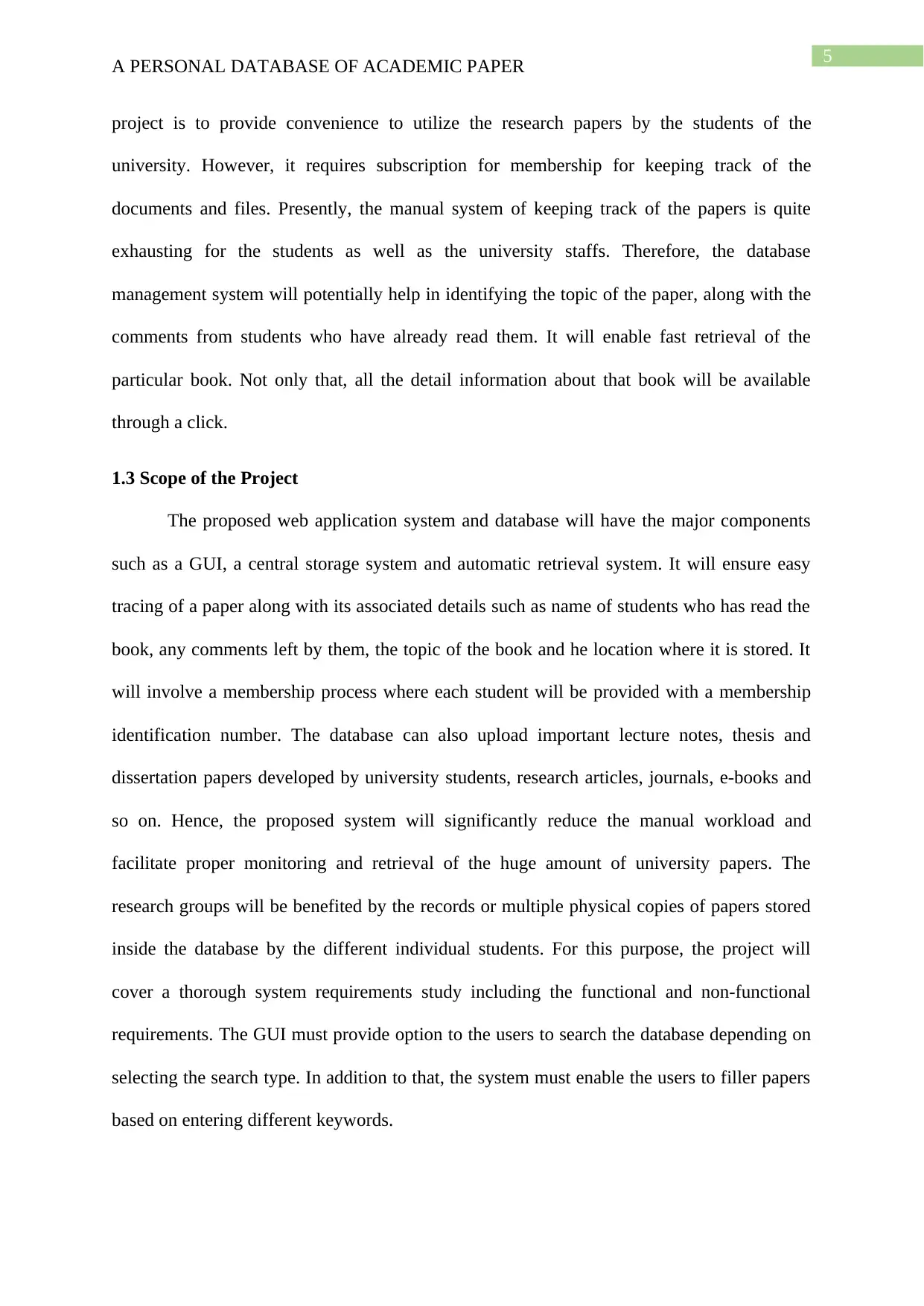
5
A PERSONAL DATABASE OF ACADEMIC PAPER
project is to provide convenience to utilize the research papers by the students of the
university. However, it requires subscription for membership for keeping track of the
documents and files. Presently, the manual system of keeping track of the papers is quite
exhausting for the students as well as the university staffs. Therefore, the database
management system will potentially help in identifying the topic of the paper, along with the
comments from students who have already read them. It will enable fast retrieval of the
particular book. Not only that, all the detail information about that book will be available
through a click.
1.3 Scope of the Project
The proposed web application system and database will have the major components
such as a GUI, a central storage system and automatic retrieval system. It will ensure easy
tracing of a paper along with its associated details such as name of students who has read the
book, any comments left by them, the topic of the book and he location where it is stored. It
will involve a membership process where each student will be provided with a membership
identification number. The database can also upload important lecture notes, thesis and
dissertation papers developed by university students, research articles, journals, e-books and
so on. Hence, the proposed system will significantly reduce the manual workload and
facilitate proper monitoring and retrieval of the huge amount of university papers. The
research groups will be benefited by the records or multiple physical copies of papers stored
inside the database by the different individual students. For this purpose, the project will
cover a thorough system requirements study including the functional and non-functional
requirements. The GUI must provide option to the users to search the database depending on
selecting the search type. In addition to that, the system must enable the users to filler papers
based on entering different keywords.
A PERSONAL DATABASE OF ACADEMIC PAPER
project is to provide convenience to utilize the research papers by the students of the
university. However, it requires subscription for membership for keeping track of the
documents and files. Presently, the manual system of keeping track of the papers is quite
exhausting for the students as well as the university staffs. Therefore, the database
management system will potentially help in identifying the topic of the paper, along with the
comments from students who have already read them. It will enable fast retrieval of the
particular book. Not only that, all the detail information about that book will be available
through a click.
1.3 Scope of the Project
The proposed web application system and database will have the major components
such as a GUI, a central storage system and automatic retrieval system. It will ensure easy
tracing of a paper along with its associated details such as name of students who has read the
book, any comments left by them, the topic of the book and he location where it is stored. It
will involve a membership process where each student will be provided with a membership
identification number. The database can also upload important lecture notes, thesis and
dissertation papers developed by university students, research articles, journals, e-books and
so on. Hence, the proposed system will significantly reduce the manual workload and
facilitate proper monitoring and retrieval of the huge amount of university papers. The
research groups will be benefited by the records or multiple physical copies of papers stored
inside the database by the different individual students. For this purpose, the project will
cover a thorough system requirements study including the functional and non-functional
requirements. The GUI must provide option to the users to search the database depending on
selecting the search type. In addition to that, the system must enable the users to filler papers
based on entering different keywords.
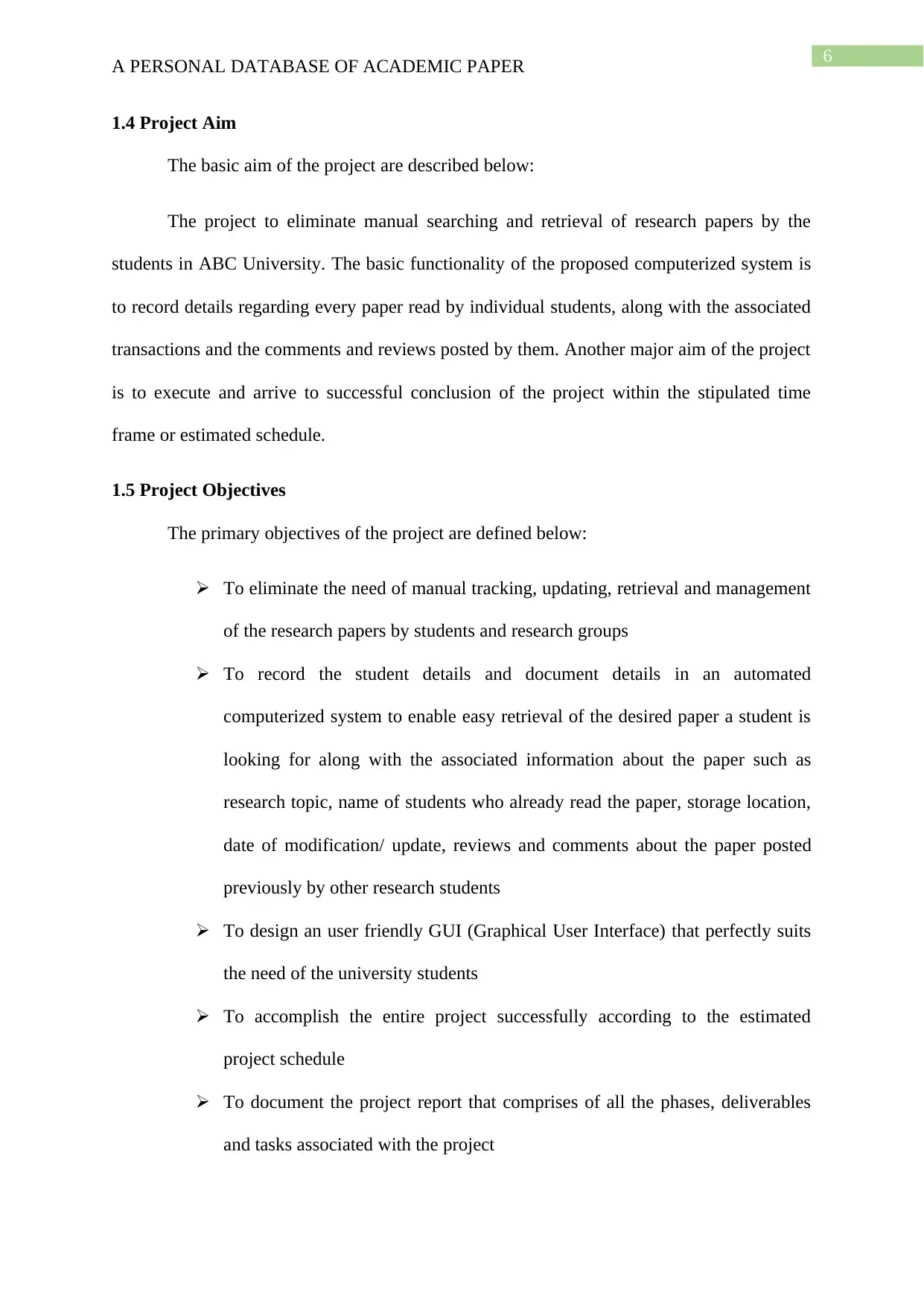
6
A PERSONAL DATABASE OF ACADEMIC PAPER
1.4 Project Aim
The basic aim of the project are described below:
The project to eliminate manual searching and retrieval of research papers by the
students in ABC University. The basic functionality of the proposed computerized system is
to record details regarding every paper read by individual students, along with the associated
transactions and the comments and reviews posted by them. Another major aim of the project
is to execute and arrive to successful conclusion of the project within the stipulated time
frame or estimated schedule.
1.5 Project Objectives
The primary objectives of the project are defined below:
To eliminate the need of manual tracking, updating, retrieval and management
of the research papers by students and research groups
To record the student details and document details in an automated
computerized system to enable easy retrieval of the desired paper a student is
looking for along with the associated information about the paper such as
research topic, name of students who already read the paper, storage location,
date of modification/ update, reviews and comments about the paper posted
previously by other research students
To design an user friendly GUI (Graphical User Interface) that perfectly suits
the need of the university students
To accomplish the entire project successfully according to the estimated
project schedule
To document the project report that comprises of all the phases, deliverables
and tasks associated with the project
A PERSONAL DATABASE OF ACADEMIC PAPER
1.4 Project Aim
The basic aim of the project are described below:
The project to eliminate manual searching and retrieval of research papers by the
students in ABC University. The basic functionality of the proposed computerized system is
to record details regarding every paper read by individual students, along with the associated
transactions and the comments and reviews posted by them. Another major aim of the project
is to execute and arrive to successful conclusion of the project within the stipulated time
frame or estimated schedule.
1.5 Project Objectives
The primary objectives of the project are defined below:
To eliminate the need of manual tracking, updating, retrieval and management
of the research papers by students and research groups
To record the student details and document details in an automated
computerized system to enable easy retrieval of the desired paper a student is
looking for along with the associated information about the paper such as
research topic, name of students who already read the paper, storage location,
date of modification/ update, reviews and comments about the paper posted
previously by other research students
To design an user friendly GUI (Graphical User Interface) that perfectly suits
the need of the university students
To accomplish the entire project successfully according to the estimated
project schedule
To document the project report that comprises of all the phases, deliverables
and tasks associated with the project
Paraphrase This Document
Need a fresh take? Get an instant paraphrase of this document with our AI Paraphraser
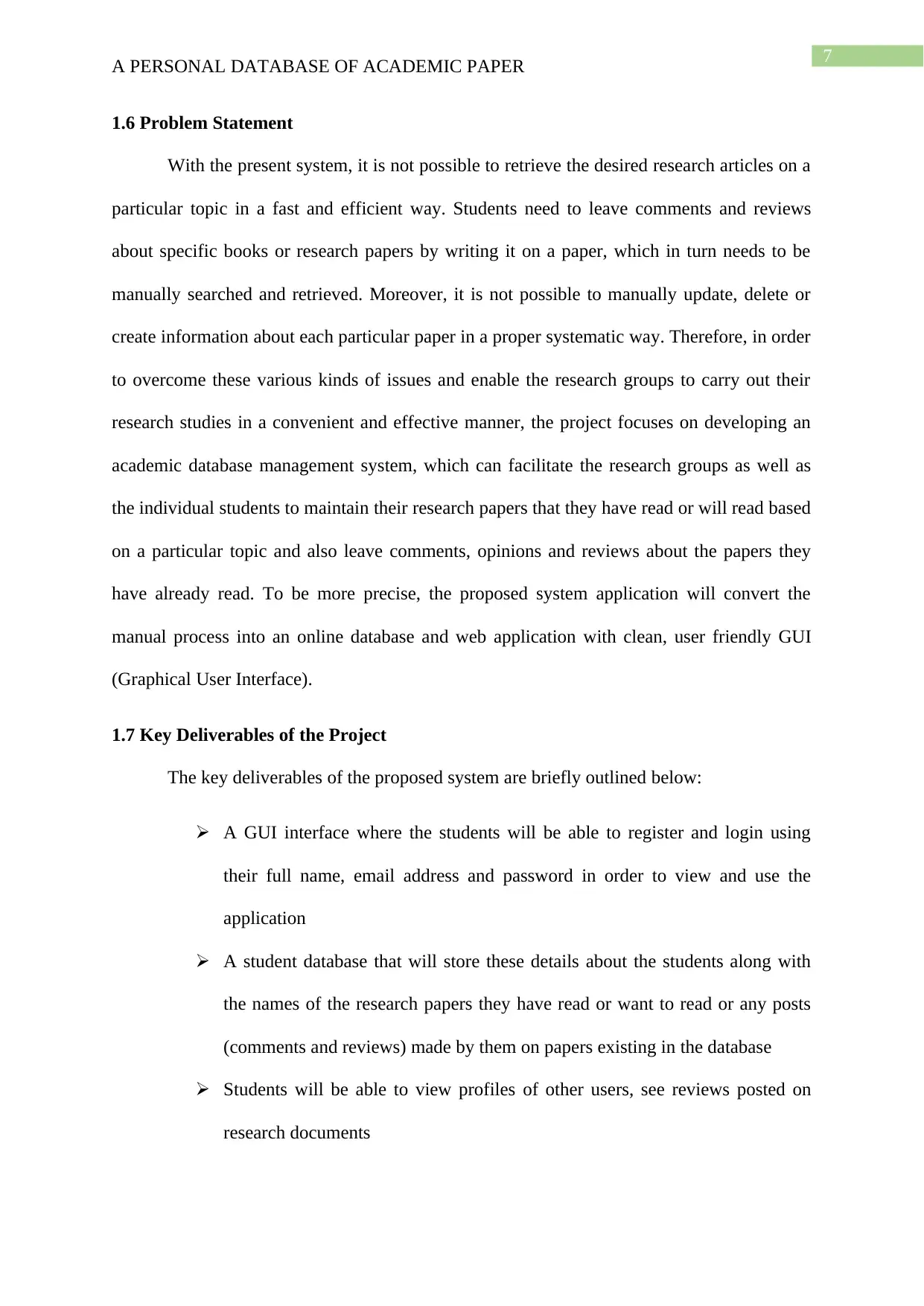
7
A PERSONAL DATABASE OF ACADEMIC PAPER
1.6 Problem Statement
With the present system, it is not possible to retrieve the desired research articles on a
particular topic in a fast and efficient way. Students need to leave comments and reviews
about specific books or research papers by writing it on a paper, which in turn needs to be
manually searched and retrieved. Moreover, it is not possible to manually update, delete or
create information about each particular paper in a proper systematic way. Therefore, in order
to overcome these various kinds of issues and enable the research groups to carry out their
research studies in a convenient and effective manner, the project focuses on developing an
academic database management system, which can facilitate the research groups as well as
the individual students to maintain their research papers that they have read or will read based
on a particular topic and also leave comments, opinions and reviews about the papers they
have already read. To be more precise, the proposed system application will convert the
manual process into an online database and web application with clean, user friendly GUI
(Graphical User Interface).
1.7 Key Deliverables of the Project
The key deliverables of the proposed system are briefly outlined below:
A GUI interface where the students will be able to register and login using
their full name, email address and password in order to view and use the
application
A student database that will store these details about the students along with
the names of the research papers they have read or want to read or any posts
(comments and reviews) made by them on papers existing in the database
Students will be able to view profiles of other users, see reviews posted on
research documents
A PERSONAL DATABASE OF ACADEMIC PAPER
1.6 Problem Statement
With the present system, it is not possible to retrieve the desired research articles on a
particular topic in a fast and efficient way. Students need to leave comments and reviews
about specific books or research papers by writing it on a paper, which in turn needs to be
manually searched and retrieved. Moreover, it is not possible to manually update, delete or
create information about each particular paper in a proper systematic way. Therefore, in order
to overcome these various kinds of issues and enable the research groups to carry out their
research studies in a convenient and effective manner, the project focuses on developing an
academic database management system, which can facilitate the research groups as well as
the individual students to maintain their research papers that they have read or will read based
on a particular topic and also leave comments, opinions and reviews about the papers they
have already read. To be more precise, the proposed system application will convert the
manual process into an online database and web application with clean, user friendly GUI
(Graphical User Interface).
1.7 Key Deliverables of the Project
The key deliverables of the proposed system are briefly outlined below:
A GUI interface where the students will be able to register and login using
their full name, email address and password in order to view and use the
application
A student database that will store these details about the students along with
the names of the research papers they have read or want to read or any posts
(comments and reviews) made by them on papers existing in the database
Students will be able to view profiles of other users, see reviews posted on
research documents
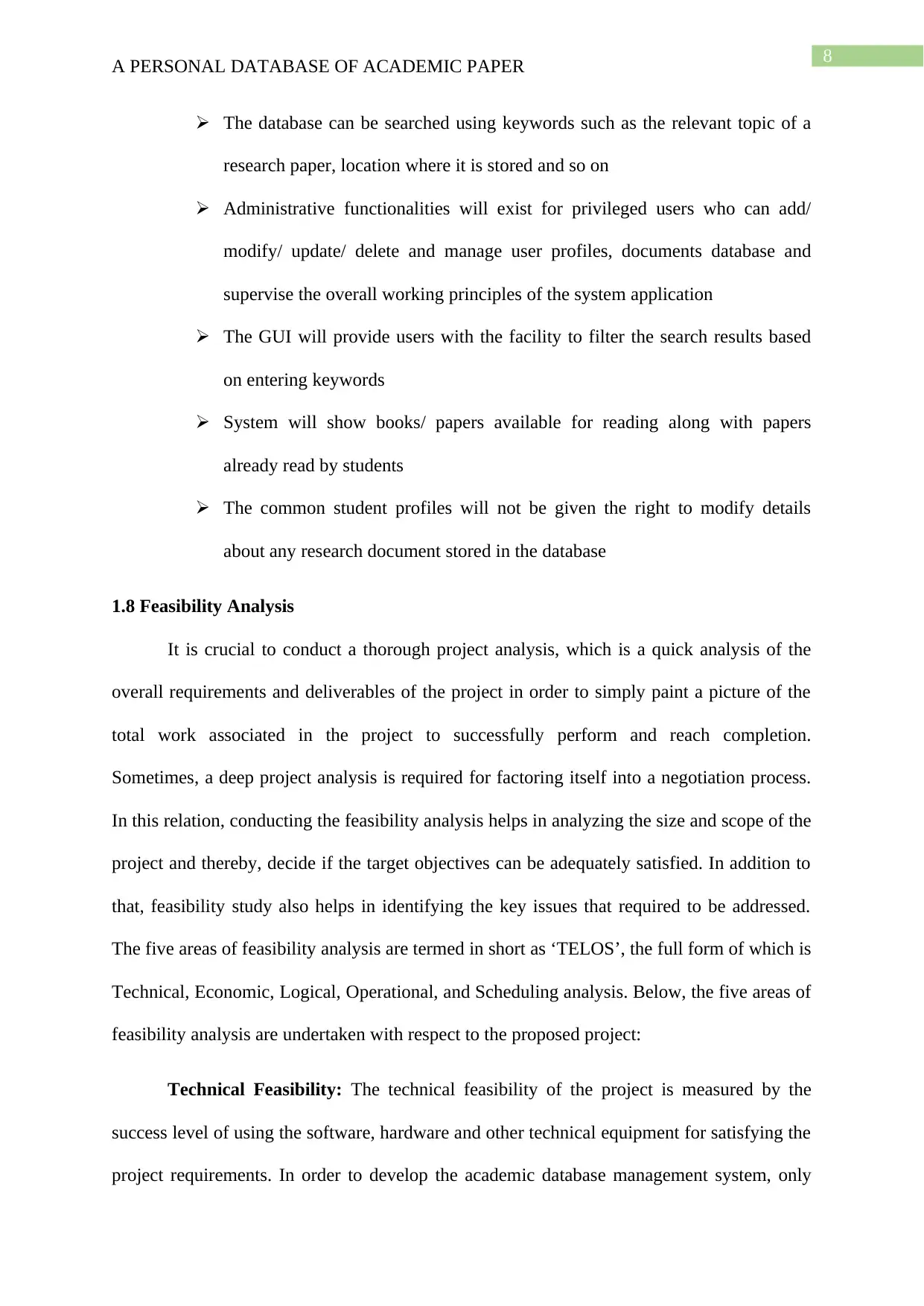
8
A PERSONAL DATABASE OF ACADEMIC PAPER
The database can be searched using keywords such as the relevant topic of a
research paper, location where it is stored and so on
Administrative functionalities will exist for privileged users who can add/
modify/ update/ delete and manage user profiles, documents database and
supervise the overall working principles of the system application
The GUI will provide users with the facility to filter the search results based
on entering keywords
System will show books/ papers available for reading along with papers
already read by students
The common student profiles will not be given the right to modify details
about any research document stored in the database
1.8 Feasibility Analysis
It is crucial to conduct a thorough project analysis, which is a quick analysis of the
overall requirements and deliverables of the project in order to simply paint a picture of the
total work associated in the project to successfully perform and reach completion.
Sometimes, a deep project analysis is required for factoring itself into a negotiation process.
In this relation, conducting the feasibility analysis helps in analyzing the size and scope of the
project and thereby, decide if the target objectives can be adequately satisfied. In addition to
that, feasibility study also helps in identifying the key issues that required to be addressed.
The five areas of feasibility analysis are termed in short as ‘TELOS’, the full form of which is
Technical, Economic, Logical, Operational, and Scheduling analysis. Below, the five areas of
feasibility analysis are undertaken with respect to the proposed project:
Technical Feasibility: The technical feasibility of the project is measured by the
success level of using the software, hardware and other technical equipment for satisfying the
project requirements. In order to develop the academic database management system, only
A PERSONAL DATABASE OF ACADEMIC PAPER
The database can be searched using keywords such as the relevant topic of a
research paper, location where it is stored and so on
Administrative functionalities will exist for privileged users who can add/
modify/ update/ delete and manage user profiles, documents database and
supervise the overall working principles of the system application
The GUI will provide users with the facility to filter the search results based
on entering keywords
System will show books/ papers available for reading along with papers
already read by students
The common student profiles will not be given the right to modify details
about any research document stored in the database
1.8 Feasibility Analysis
It is crucial to conduct a thorough project analysis, which is a quick analysis of the
overall requirements and deliverables of the project in order to simply paint a picture of the
total work associated in the project to successfully perform and reach completion.
Sometimes, a deep project analysis is required for factoring itself into a negotiation process.
In this relation, conducting the feasibility analysis helps in analyzing the size and scope of the
project and thereby, decide if the target objectives can be adequately satisfied. In addition to
that, feasibility study also helps in identifying the key issues that required to be addressed.
The five areas of feasibility analysis are termed in short as ‘TELOS’, the full form of which is
Technical, Economic, Logical, Operational, and Scheduling analysis. Below, the five areas of
feasibility analysis are undertaken with respect to the proposed project:
Technical Feasibility: The technical feasibility of the project is measured by the
success level of using the software, hardware and other technical equipment for satisfying the
project requirements. In order to develop the academic database management system, only

9
A PERSONAL DATABASE OF ACADEMIC PAPER
stable platforms such as MS Access and Visual Basic to create an efficient Windows
application.
Economic Feasibility: The project will further be assessed to analyse its economic
feasibility to determine the positive economic benefits that the university can utilize. The
proposed system will provide potential benefit to the university as it will omit the
requirement of manually managing the academic papers by the students. As a result, it will
reduce significant costs related to paper-based database management. The system will
provide automation and integration of the overall retrieval and update process of the research
papers, facilitating both time and cost savings to the university as well as to the students
using the academic database GUI. The economic scope of the project can be expanded in
future by incorporating advertisements that will increase the possibility of earning facility.
Logical Feasibility: The project evidently meets the logical feasibility criteria. The
overall system design of the project is logically sane and possible. Moreover, it is ensured
that the system design does not contain unnecessary options and features that can puzzle or
confuse the users while operating the system.
Operational Feasibility: The measuring of operational feasibility is defined by the
way a system resolves a particular problem. Along with that, operational feasibility also takes
the opportunities identified at the time of definition of scope and analyses how the path
undertaken satisfies the requirements of the project. The project requirements as defined in
the requirements analysis phase is compared and contrasted with the defined scope of the
overall system development. Furthermore, it can be said that this personal academic database
management system will be designed in a proper manner and users will not have problems
while using the GUI software, as it will be an adequately user friendly, easy to use, simple,
fast and efficient application.
A PERSONAL DATABASE OF ACADEMIC PAPER
stable platforms such as MS Access and Visual Basic to create an efficient Windows
application.
Economic Feasibility: The project will further be assessed to analyse its economic
feasibility to determine the positive economic benefits that the university can utilize. The
proposed system will provide potential benefit to the university as it will omit the
requirement of manually managing the academic papers by the students. As a result, it will
reduce significant costs related to paper-based database management. The system will
provide automation and integration of the overall retrieval and update process of the research
papers, facilitating both time and cost savings to the university as well as to the students
using the academic database GUI. The economic scope of the project can be expanded in
future by incorporating advertisements that will increase the possibility of earning facility.
Logical Feasibility: The project evidently meets the logical feasibility criteria. The
overall system design of the project is logically sane and possible. Moreover, it is ensured
that the system design does not contain unnecessary options and features that can puzzle or
confuse the users while operating the system.
Operational Feasibility: The measuring of operational feasibility is defined by the
way a system resolves a particular problem. Along with that, operational feasibility also takes
the opportunities identified at the time of definition of scope and analyses how the path
undertaken satisfies the requirements of the project. The project requirements as defined in
the requirements analysis phase is compared and contrasted with the defined scope of the
overall system development. Furthermore, it can be said that this personal academic database
management system will be designed in a proper manner and users will not have problems
while using the GUI software, as it will be an adequately user friendly, easy to use, simple,
fast and efficient application.
Secure Best Marks with AI Grader
Need help grading? Try our AI Grader for instant feedback on your assignments.
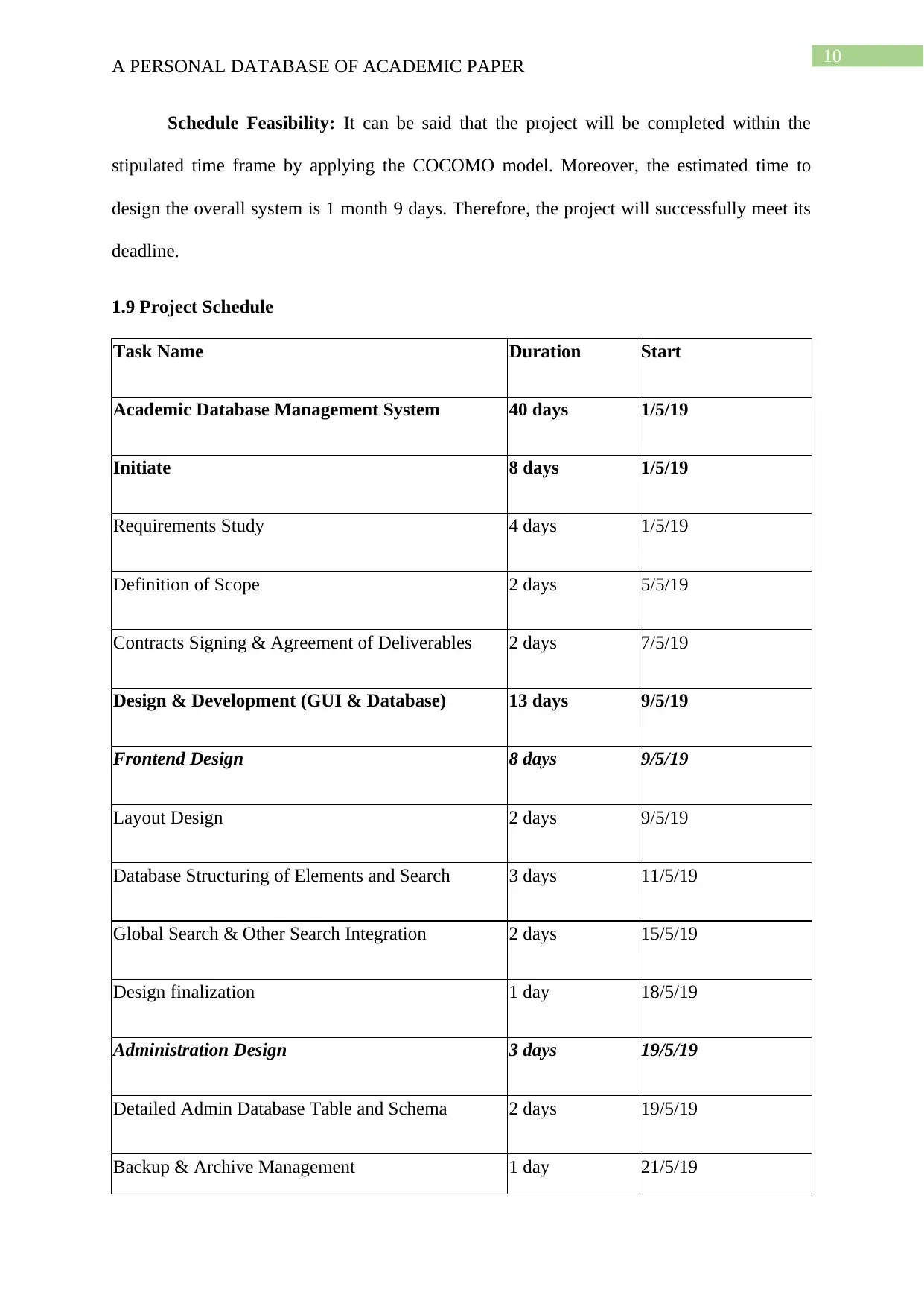
10
A PERSONAL DATABASE OF ACADEMIC PAPER
Schedule Feasibility: It can be said that the project will be completed within the
stipulated time frame by applying the COCOMO model. Moreover, the estimated time to
design the overall system is 1 month 9 days. Therefore, the project will successfully meet its
deadline.
1.9 Project Schedule
Task Name Duration Start
Academic Database Management System 40 days 1/5/19
Initiate 8 days 1/5/19
Requirements Study 4 days 1/5/19
Definition of Scope 2 days 5/5/19
Contracts Signing & Agreement of Deliverables 2 days 7/5/19
Design & Development (GUI & Database) 13 days 9/5/19
Frontend Design 8 days 9/5/19
Layout Design 2 days 9/5/19
Database Structuring of Elements and Search 3 days 11/5/19
Global Search & Other Search Integration 2 days 15/5/19
Design finalization 1 day 18/5/19
Administration Design 3 days 19/5/19
Detailed Admin Database Table and Schema 2 days 19/5/19
Backup & Archive Management 1 day 21/5/19
A PERSONAL DATABASE OF ACADEMIC PAPER
Schedule Feasibility: It can be said that the project will be completed within the
stipulated time frame by applying the COCOMO model. Moreover, the estimated time to
design the overall system is 1 month 9 days. Therefore, the project will successfully meet its
deadline.
1.9 Project Schedule
Task Name Duration Start
Academic Database Management System 40 days 1/5/19
Initiate 8 days 1/5/19
Requirements Study 4 days 1/5/19
Definition of Scope 2 days 5/5/19
Contracts Signing & Agreement of Deliverables 2 days 7/5/19
Design & Development (GUI & Database) 13 days 9/5/19
Frontend Design 8 days 9/5/19
Layout Design 2 days 9/5/19
Database Structuring of Elements and Search 3 days 11/5/19
Global Search & Other Search Integration 2 days 15/5/19
Design finalization 1 day 18/5/19
Administration Design 3 days 19/5/19
Detailed Admin Database Table and Schema 2 days 19/5/19
Backup & Archive Management 1 day 21/5/19
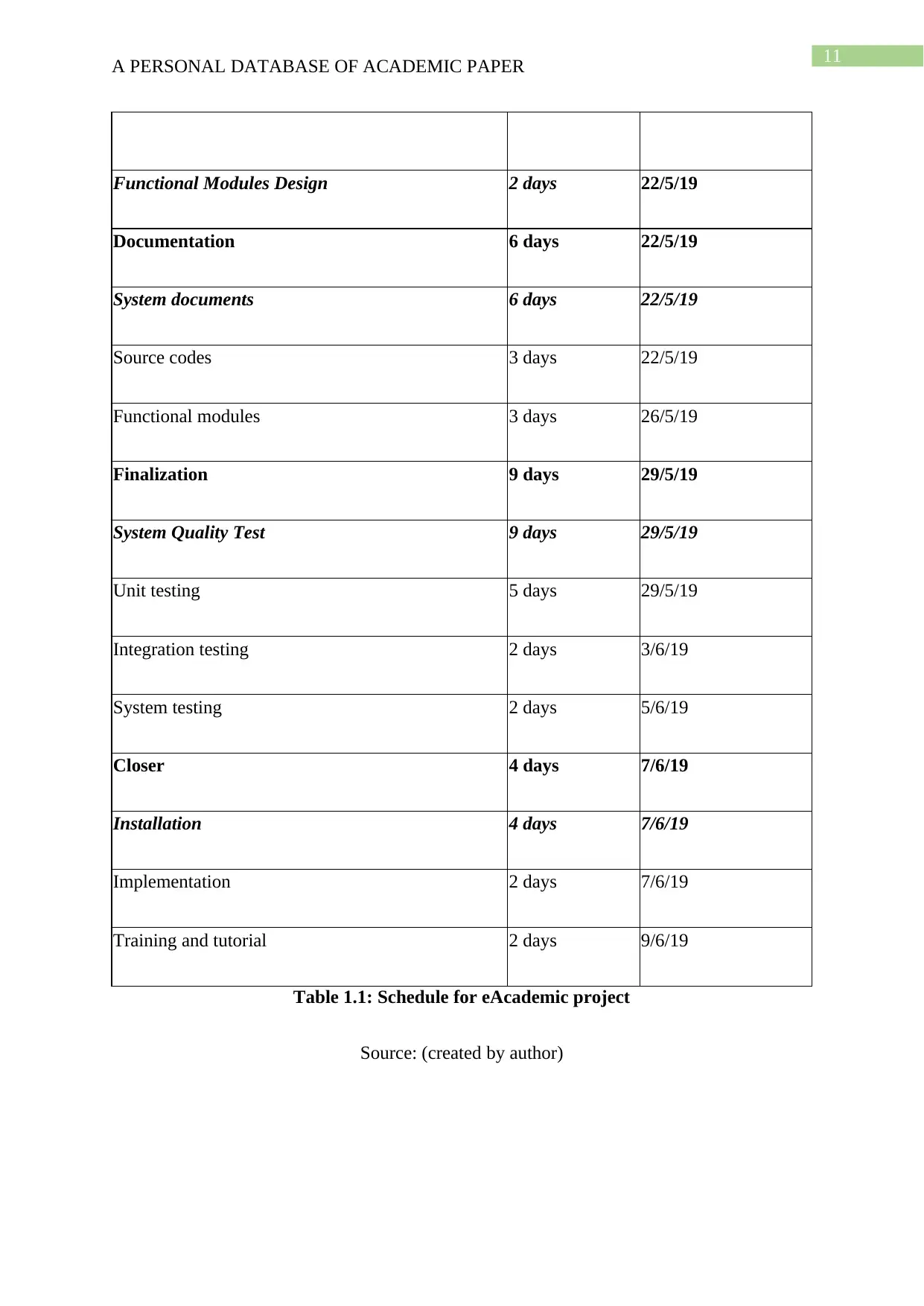
11
A PERSONAL DATABASE OF ACADEMIC PAPER
Functional Modules Design 2 days 22/5/19
Documentation 6 days 22/5/19
System documents 6 days 22/5/19
Source codes 3 days 22/5/19
Functional modules 3 days 26/5/19
Finalization 9 days 29/5/19
System Quality Test 9 days 29/5/19
Unit testing 5 days 29/5/19
Integration testing 2 days 3/6/19
System testing 2 days 5/6/19
Closer 4 days 7/6/19
Installation 4 days 7/6/19
Implementation 2 days 7/6/19
Training and tutorial 2 days 9/6/19
Table 1.1: Schedule for eAcademic project
Source: (created by author)
A PERSONAL DATABASE OF ACADEMIC PAPER
Functional Modules Design 2 days 22/5/19
Documentation 6 days 22/5/19
System documents 6 days 22/5/19
Source codes 3 days 22/5/19
Functional modules 3 days 26/5/19
Finalization 9 days 29/5/19
System Quality Test 9 days 29/5/19
Unit testing 5 days 29/5/19
Integration testing 2 days 3/6/19
System testing 2 days 5/6/19
Closer 4 days 7/6/19
Installation 4 days 7/6/19
Implementation 2 days 7/6/19
Training and tutorial 2 days 9/6/19
Table 1.1: Schedule for eAcademic project
Source: (created by author)
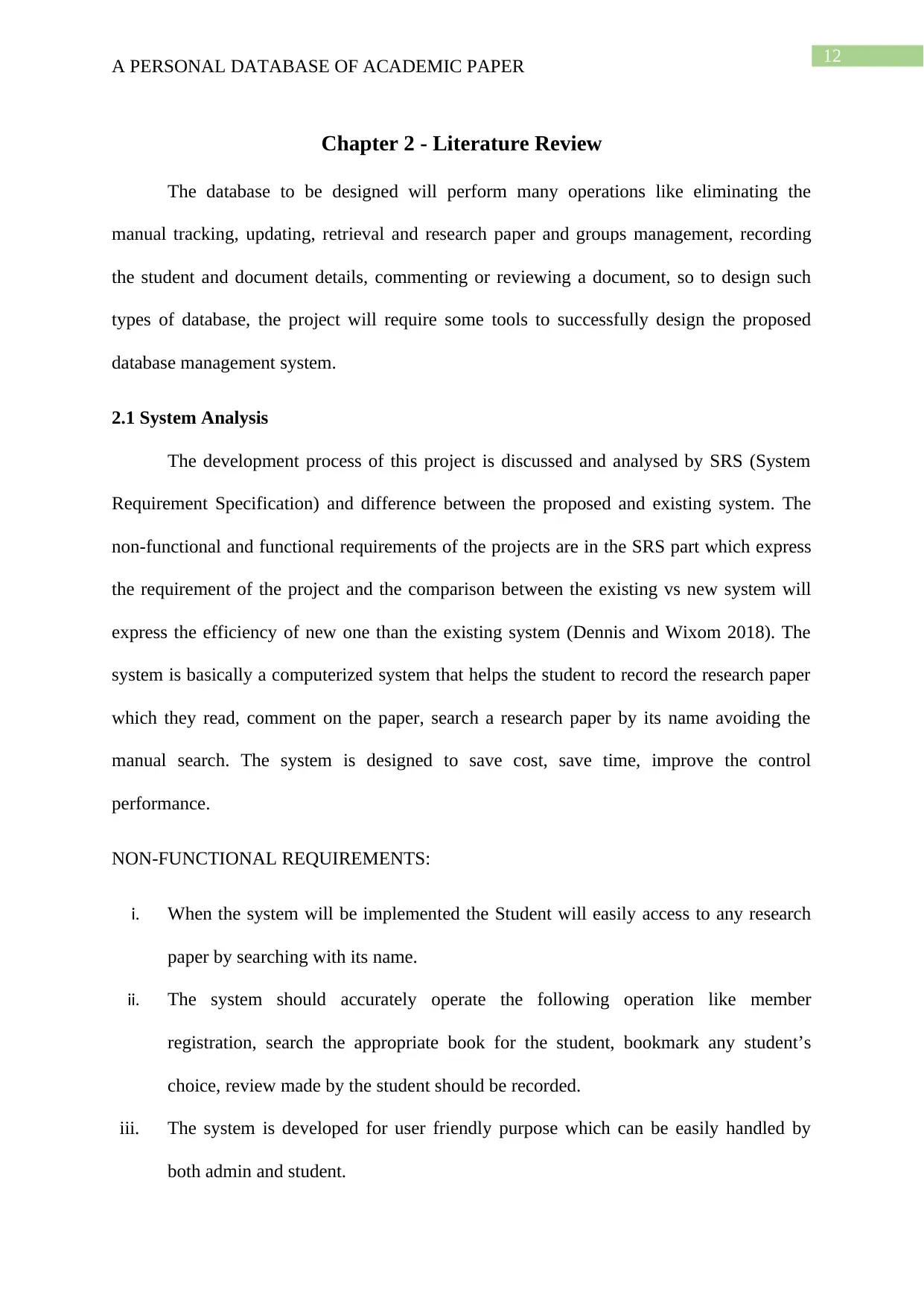
12
A PERSONAL DATABASE OF ACADEMIC PAPER
Chapter 2 - Literature Review
The database to be designed will perform many operations like eliminating the
manual tracking, updating, retrieval and research paper and groups management, recording
the student and document details, commenting or reviewing a document, so to design such
types of database, the project will require some tools to successfully design the proposed
database management system.
2.1 System Analysis
The development process of this project is discussed and analysed by SRS (System
Requirement Specification) and difference between the proposed and existing system. The
non-functional and functional requirements of the projects are in the SRS part which express
the requirement of the project and the comparison between the existing vs new system will
express the efficiency of new one than the existing system (Dennis and Wixom 2018). The
system is basically a computerized system that helps the student to record the research paper
which they read, comment on the paper, search a research paper by its name avoiding the
manual search. The system is designed to save cost, save time, improve the control
performance.
NON-FUNCTIONAL REQUIREMENTS:
i. When the system will be implemented the Student will easily access to any research
paper by searching with its name.
ii. The system should accurately operate the following operation like member
registration, search the appropriate book for the student, bookmark any student’s
choice, review made by the student should be recorded.
iii. The system is developed for user friendly purpose which can be easily handled by
both admin and student.
A PERSONAL DATABASE OF ACADEMIC PAPER
Chapter 2 - Literature Review
The database to be designed will perform many operations like eliminating the
manual tracking, updating, retrieval and research paper and groups management, recording
the student and document details, commenting or reviewing a document, so to design such
types of database, the project will require some tools to successfully design the proposed
database management system.
2.1 System Analysis
The development process of this project is discussed and analysed by SRS (System
Requirement Specification) and difference between the proposed and existing system. The
non-functional and functional requirements of the projects are in the SRS part which express
the requirement of the project and the comparison between the existing vs new system will
express the efficiency of new one than the existing system (Dennis and Wixom 2018). The
system is basically a computerized system that helps the student to record the research paper
which they read, comment on the paper, search a research paper by its name avoiding the
manual search. The system is designed to save cost, save time, improve the control
performance.
NON-FUNCTIONAL REQUIREMENTS:
i. When the system will be implemented the Student will easily access to any research
paper by searching with its name.
ii. The system should accurately operate the following operation like member
registration, search the appropriate book for the student, bookmark any student’s
choice, review made by the student should be recorded.
iii. The system is developed for user friendly purpose which can be easily handled by
both admin and student.
Paraphrase This Document
Need a fresh take? Get an instant paraphrase of this document with our AI Paraphraser
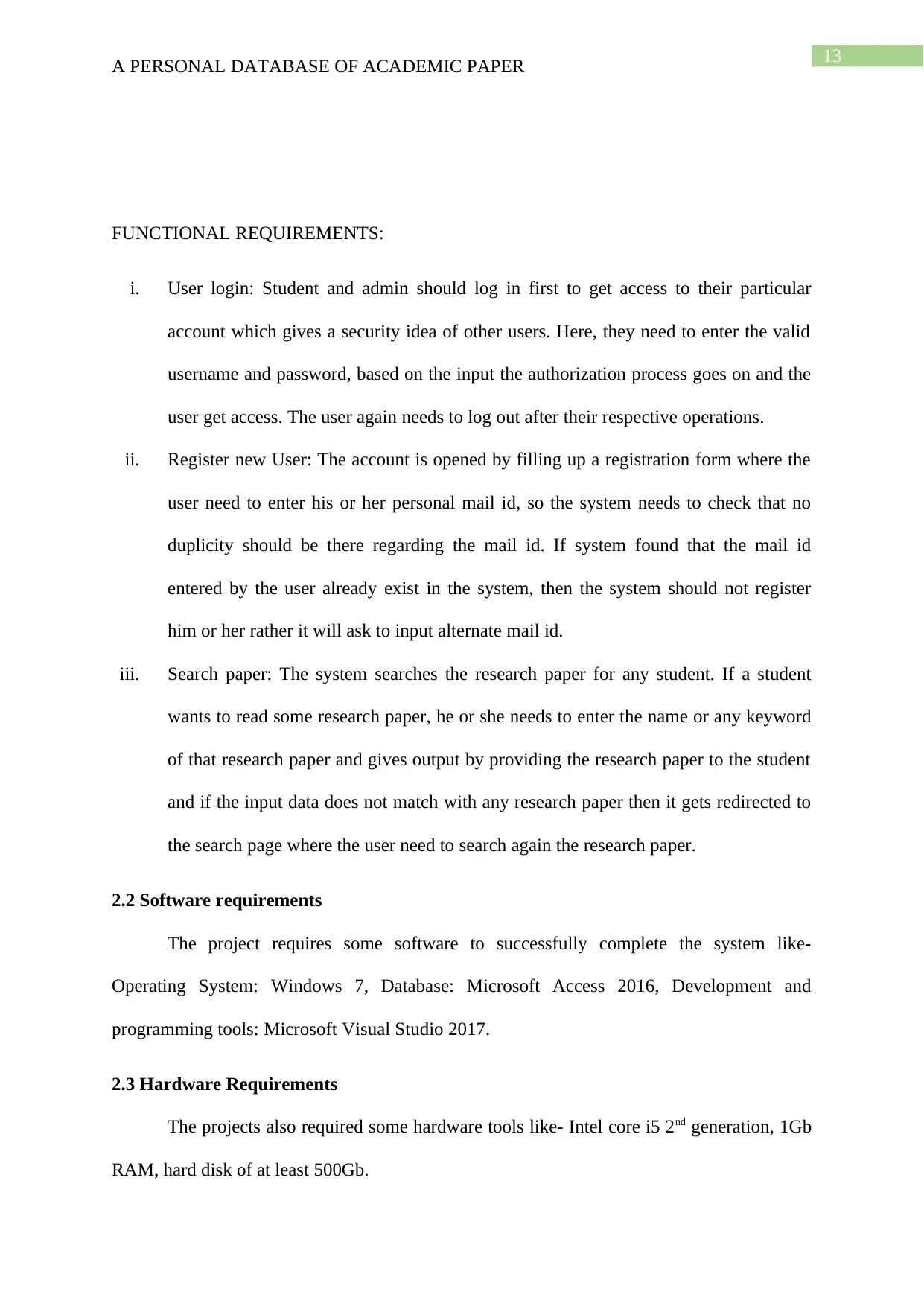
13
A PERSONAL DATABASE OF ACADEMIC PAPER
FUNCTIONAL REQUIREMENTS:
i. User login: Student and admin should log in first to get access to their particular
account which gives a security idea of other users. Here, they need to enter the valid
username and password, based on the input the authorization process goes on and the
user get access. The user again needs to log out after their respective operations.
ii. Register new User: The account is opened by filling up a registration form where the
user need to enter his or her personal mail id, so the system needs to check that no
duplicity should be there regarding the mail id. If system found that the mail id
entered by the user already exist in the system, then the system should not register
him or her rather it will ask to input alternate mail id.
iii. Search paper: The system searches the research paper for any student. If a student
wants to read some research paper, he or she needs to enter the name or any keyword
of that research paper and gives output by providing the research paper to the student
and if the input data does not match with any research paper then it gets redirected to
the search page where the user need to search again the research paper.
2.2 Software requirements
The project requires some software to successfully complete the system like-
Operating System: Windows 7, Database: Microsoft Access 2016, Development and
programming tools: Microsoft Visual Studio 2017.
2.3 Hardware Requirements
The projects also required some hardware tools like- Intel core i5 2nd generation, 1Gb
RAM, hard disk of at least 500Gb.
A PERSONAL DATABASE OF ACADEMIC PAPER
FUNCTIONAL REQUIREMENTS:
i. User login: Student and admin should log in first to get access to their particular
account which gives a security idea of other users. Here, they need to enter the valid
username and password, based on the input the authorization process goes on and the
user get access. The user again needs to log out after their respective operations.
ii. Register new User: The account is opened by filling up a registration form where the
user need to enter his or her personal mail id, so the system needs to check that no
duplicity should be there regarding the mail id. If system found that the mail id
entered by the user already exist in the system, then the system should not register
him or her rather it will ask to input alternate mail id.
iii. Search paper: The system searches the research paper for any student. If a student
wants to read some research paper, he or she needs to enter the name or any keyword
of that research paper and gives output by providing the research paper to the student
and if the input data does not match with any research paper then it gets redirected to
the search page where the user need to search again the research paper.
2.2 Software requirements
The project requires some software to successfully complete the system like-
Operating System: Windows 7, Database: Microsoft Access 2016, Development and
programming tools: Microsoft Visual Studio 2017.
2.3 Hardware Requirements
The projects also required some hardware tools like- Intel core i5 2nd generation, 1Gb
RAM, hard disk of at least 500Gb.
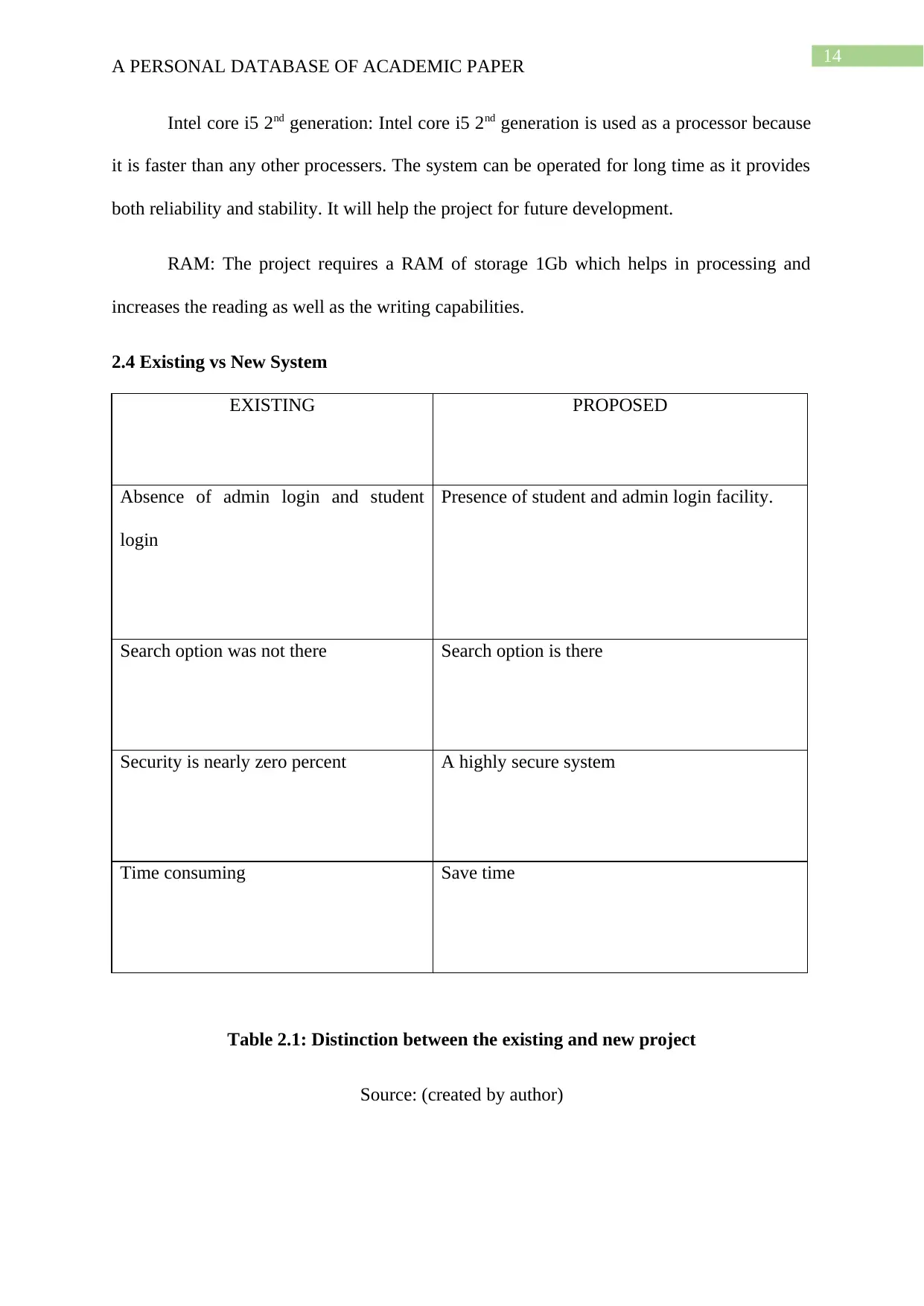
14
A PERSONAL DATABASE OF ACADEMIC PAPER
Intel core i5 2nd generation: Intel core i5 2nd generation is used as a processor because
it is faster than any other processers. The system can be operated for long time as it provides
both reliability and stability. It will help the project for future development.
RAM: The project requires a RAM of storage 1Gb which helps in processing and
increases the reading as well as the writing capabilities.
2.4 Existing vs New System
EXISTING PROPOSED
Absence of admin login and student
login
Presence of student and admin login facility.
Search option was not there Search option is there
Security is nearly zero percent A highly secure system
Time consuming Save time
Table 2.1: Distinction between the existing and new project
Source: (created by author)
A PERSONAL DATABASE OF ACADEMIC PAPER
Intel core i5 2nd generation: Intel core i5 2nd generation is used as a processor because
it is faster than any other processers. The system can be operated for long time as it provides
both reliability and stability. It will help the project for future development.
RAM: The project requires a RAM of storage 1Gb which helps in processing and
increases the reading as well as the writing capabilities.
2.4 Existing vs New System
EXISTING PROPOSED
Absence of admin login and student
login
Presence of student and admin login facility.
Search option was not there Search option is there
Security is nearly zero percent A highly secure system
Time consuming Save time
Table 2.1: Distinction between the existing and new project
Source: (created by author)
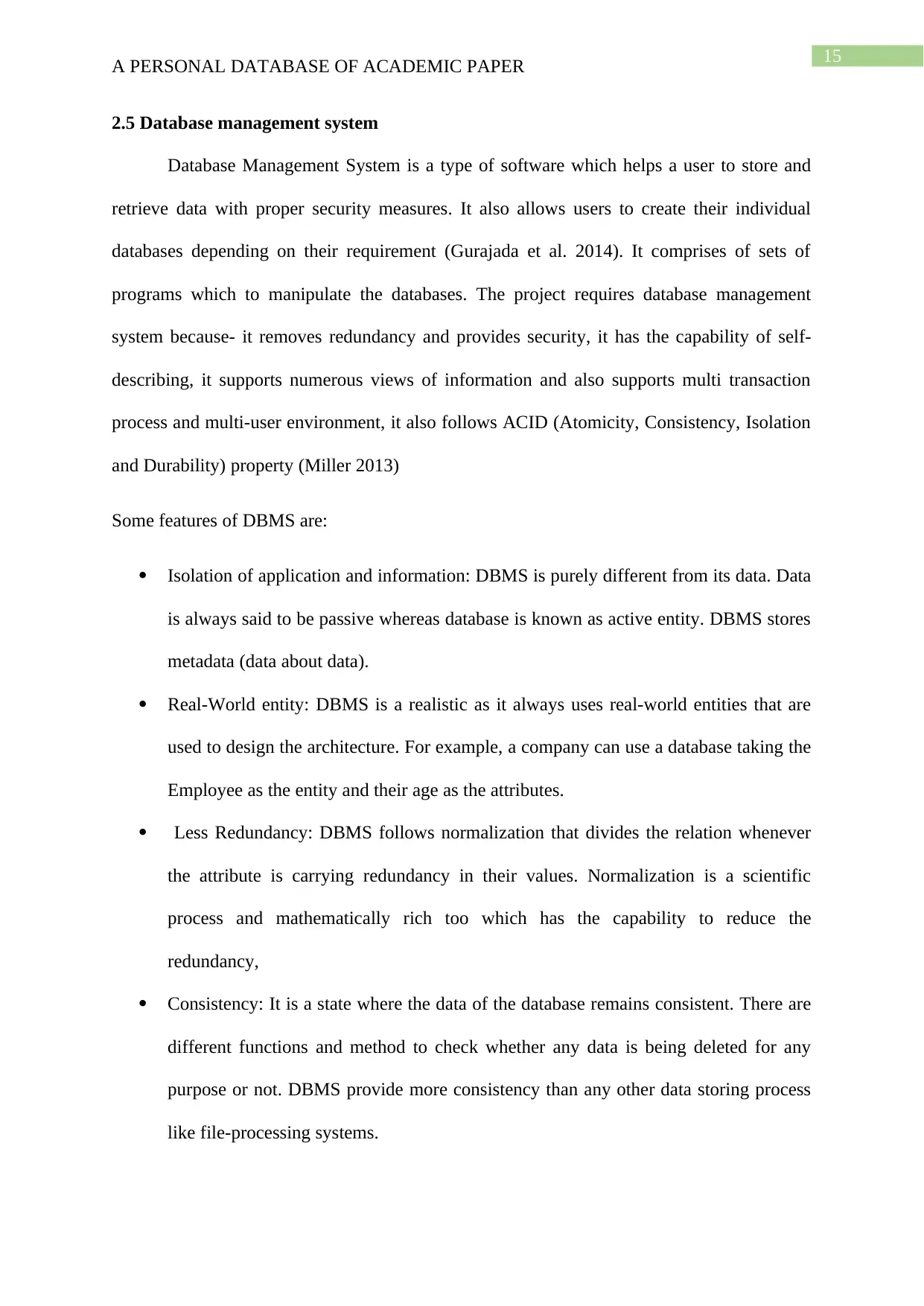
15
A PERSONAL DATABASE OF ACADEMIC PAPER
2.5 Database management system
Database Management System is a type of software which helps a user to store and
retrieve data with proper security measures. It also allows users to create their individual
databases depending on their requirement (Gurajada et al. 2014). It comprises of sets of
programs which to manipulate the databases. The project requires database management
system because- it removes redundancy and provides security, it has the capability of self-
describing, it supports numerous views of information and also supports multi transaction
process and multi-user environment, it also follows ACID (Atomicity, Consistency, Isolation
and Durability) property (Miller 2013)
Some features of DBMS are:
Isolation of application and information: DBMS is purely different from its data. Data
is always said to be passive whereas database is known as active entity. DBMS stores
metadata (data about data).
Real-World entity: DBMS is a realistic as it always uses real-world entities that are
used to design the architecture. For example, a company can use a database taking the
Employee as the entity and their age as the attributes.
Less Redundancy: DBMS follows normalization that divides the relation whenever
the attribute is carrying redundancy in their values. Normalization is a scientific
process and mathematically rich too which has the capability to reduce the
redundancy,
Consistency: It is a state where the data of the database remains consistent. There are
different functions and method to check whether any data is being deleted for any
purpose or not. DBMS provide more consistency than any other data storing process
like file-processing systems.
A PERSONAL DATABASE OF ACADEMIC PAPER
2.5 Database management system
Database Management System is a type of software which helps a user to store and
retrieve data with proper security measures. It also allows users to create their individual
databases depending on their requirement (Gurajada et al. 2014). It comprises of sets of
programs which to manipulate the databases. The project requires database management
system because- it removes redundancy and provides security, it has the capability of self-
describing, it supports numerous views of information and also supports multi transaction
process and multi-user environment, it also follows ACID (Atomicity, Consistency, Isolation
and Durability) property (Miller 2013)
Some features of DBMS are:
Isolation of application and information: DBMS is purely different from its data. Data
is always said to be passive whereas database is known as active entity. DBMS stores
metadata (data about data).
Real-World entity: DBMS is a realistic as it always uses real-world entities that are
used to design the architecture. For example, a company can use a database taking the
Employee as the entity and their age as the attributes.
Less Redundancy: DBMS follows normalization that divides the relation whenever
the attribute is carrying redundancy in their values. Normalization is a scientific
process and mathematically rich too which has the capability to reduce the
redundancy,
Consistency: It is a state where the data of the database remains consistent. There are
different functions and method to check whether any data is being deleted for any
purpose or not. DBMS provide more consistency than any other data storing process
like file-processing systems.
Secure Best Marks with AI Grader
Need help grading? Try our AI Grader for instant feedback on your assignments.
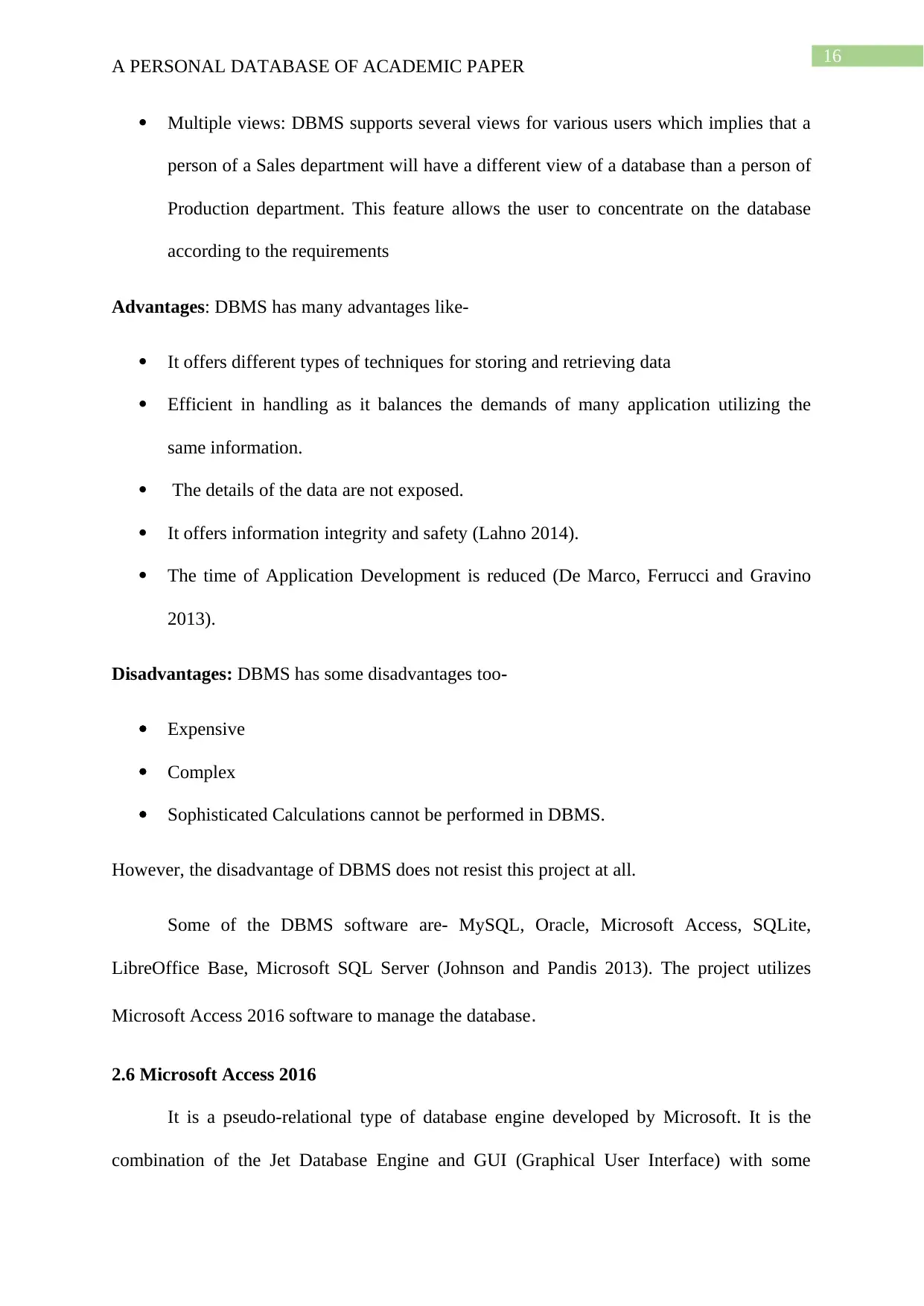
16
A PERSONAL DATABASE OF ACADEMIC PAPER
Multiple views: DBMS supports several views for various users which implies that a
person of a Sales department will have a different view of a database than a person of
Production department. This feature allows the user to concentrate on the database
according to the requirements
Advantages: DBMS has many advantages like-
It offers different types of techniques for storing and retrieving data
Efficient in handling as it balances the demands of many application utilizing the
same information.
The details of the data are not exposed.
It offers information integrity and safety (Lahno 2014).
The time of Application Development is reduced (De Marco, Ferrucci and Gravino
2013).
Disadvantages: DBMS has some disadvantages too-
Expensive
Complex
Sophisticated Calculations cannot be performed in DBMS.
However, the disadvantage of DBMS does not resist this project at all.
Some of the DBMS software are- MySQL, Oracle, Microsoft Access, SQLite,
LibreOffice Base, Microsoft SQL Server (Johnson and Pandis 2013). The project utilizes
Microsoft Access 2016 software to manage the database.
2.6 Microsoft Access 2016
It is a pseudo-relational type of database engine developed by Microsoft. It is the
combination of the Jet Database Engine and GUI (Graphical User Interface) with some
A PERSONAL DATABASE OF ACADEMIC PAPER
Multiple views: DBMS supports several views for various users which implies that a
person of a Sales department will have a different view of a database than a person of
Production department. This feature allows the user to concentrate on the database
according to the requirements
Advantages: DBMS has many advantages like-
It offers different types of techniques for storing and retrieving data
Efficient in handling as it balances the demands of many application utilizing the
same information.
The details of the data are not exposed.
It offers information integrity and safety (Lahno 2014).
The time of Application Development is reduced (De Marco, Ferrucci and Gravino
2013).
Disadvantages: DBMS has some disadvantages too-
Expensive
Complex
Sophisticated Calculations cannot be performed in DBMS.
However, the disadvantage of DBMS does not resist this project at all.
Some of the DBMS software are- MySQL, Oracle, Microsoft Access, SQLite,
LibreOffice Base, Microsoft SQL Server (Johnson and Pandis 2013). The project utilizes
Microsoft Access 2016 software to manage the database.
2.6 Microsoft Access 2016
It is a pseudo-relational type of database engine developed by Microsoft. It is the
combination of the Jet Database Engine and GUI (Graphical User Interface) with some
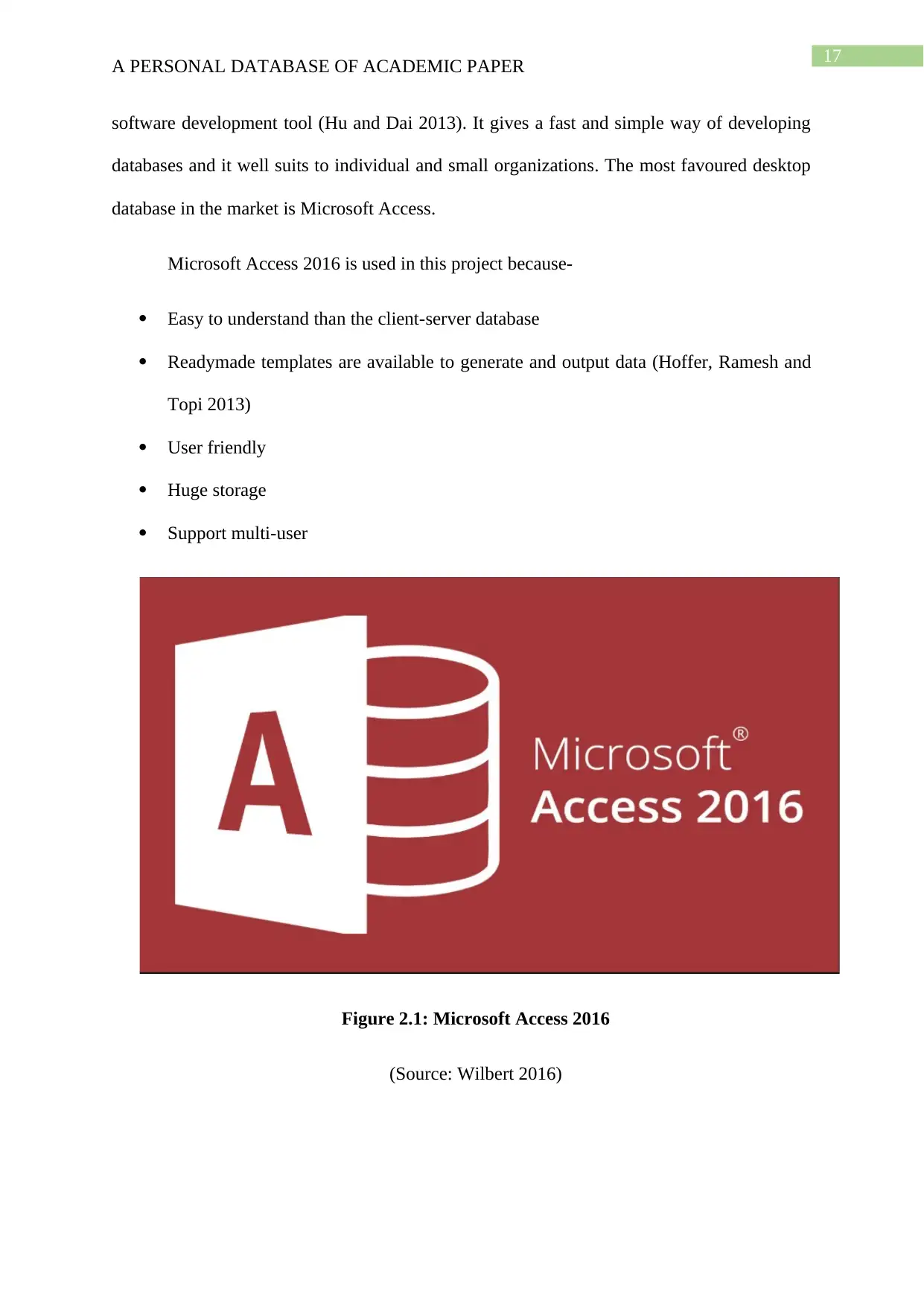
17
A PERSONAL DATABASE OF ACADEMIC PAPER
software development tool (Hu and Dai 2013). It gives a fast and simple way of developing
databases and it well suits to individual and small organizations. The most favoured desktop
database in the market is Microsoft Access.
Microsoft Access 2016 is used in this project because-
Easy to understand than the client-server database
Readymade templates are available to generate and output data (Hoffer, Ramesh and
Topi 2013)
User friendly
Huge storage
Support multi-user
Figure 2.1: Microsoft Access 2016
(Source: Wilbert 2016)
A PERSONAL DATABASE OF ACADEMIC PAPER
software development tool (Hu and Dai 2013). It gives a fast and simple way of developing
databases and it well suits to individual and small organizations. The most favoured desktop
database in the market is Microsoft Access.
Microsoft Access 2016 is used in this project because-
Easy to understand than the client-server database
Readymade templates are available to generate and output data (Hoffer, Ramesh and
Topi 2013)
User friendly
Huge storage
Support multi-user
Figure 2.1: Microsoft Access 2016
(Source: Wilbert 2016)
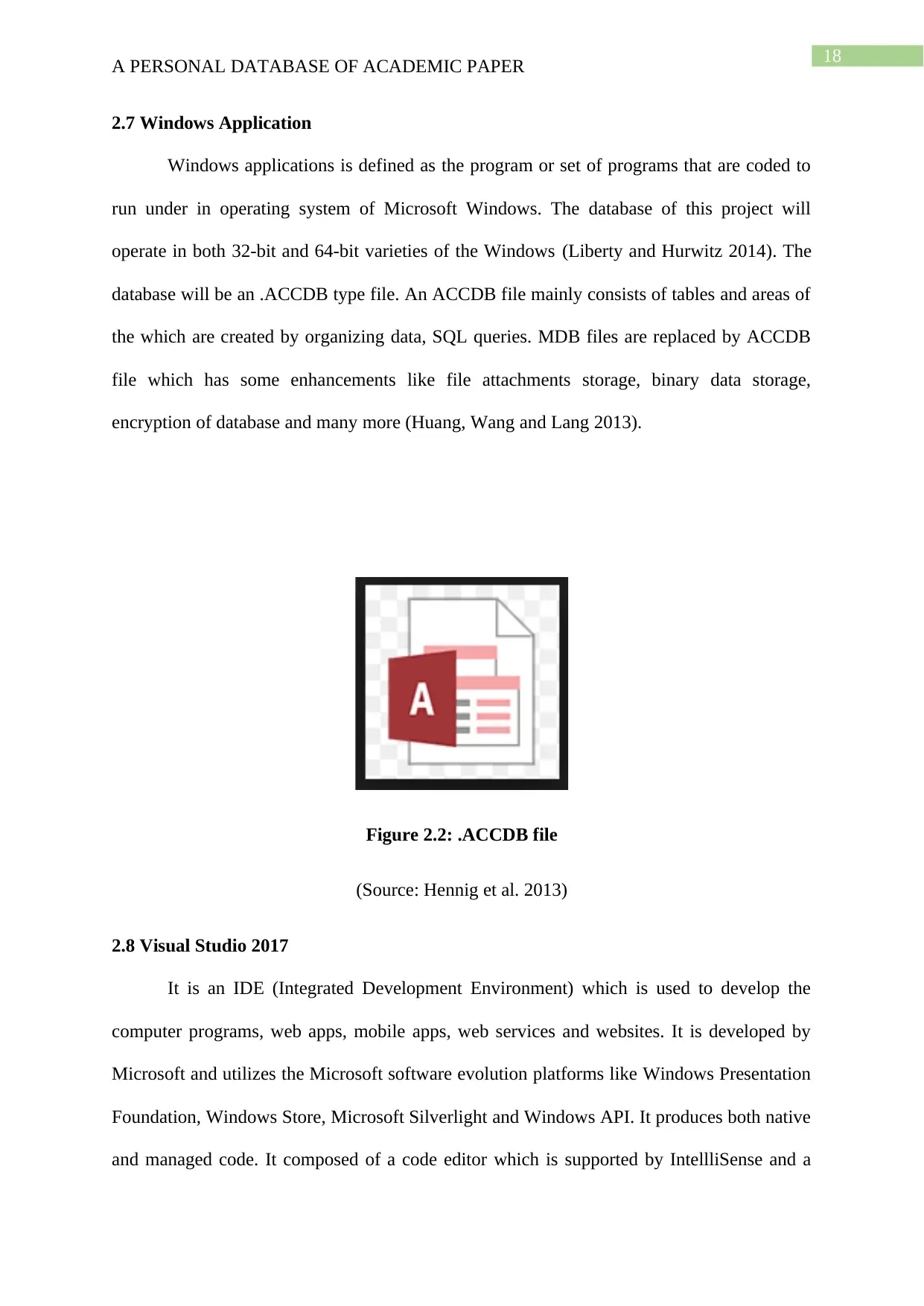
18
A PERSONAL DATABASE OF ACADEMIC PAPER
2.7 Windows Application
Windows applications is defined as the program or set of programs that are coded to
run under in operating system of Microsoft Windows. The database of this project will
operate in both 32-bit and 64-bit varieties of the Windows (Liberty and Hurwitz 2014). The
database will be an .ACCDB type file. An ACCDB file mainly consists of tables and areas of
the which are created by organizing data, SQL queries. MDB files are replaced by ACCDB
file which has some enhancements like file attachments storage, binary data storage,
encryption of database and many more (Huang, Wang and Lang 2013).
Figure 2.2: .ACCDB file
(Source: Hennig et al. 2013)
2.8 Visual Studio 2017
It is an IDE (Integrated Development Environment) which is used to develop the
computer programs, web apps, mobile apps, web services and websites. It is developed by
Microsoft and utilizes the Microsoft software evolution platforms like Windows Presentation
Foundation, Windows Store, Microsoft Silverlight and Windows API. It produces both native
and managed code. It composed of a code editor which is supported by IntellliSense and a
A PERSONAL DATABASE OF ACADEMIC PAPER
2.7 Windows Application
Windows applications is defined as the program or set of programs that are coded to
run under in operating system of Microsoft Windows. The database of this project will
operate in both 32-bit and 64-bit varieties of the Windows (Liberty and Hurwitz 2014). The
database will be an .ACCDB type file. An ACCDB file mainly consists of tables and areas of
the which are created by organizing data, SQL queries. MDB files are replaced by ACCDB
file which has some enhancements like file attachments storage, binary data storage,
encryption of database and many more (Huang, Wang and Lang 2013).
Figure 2.2: .ACCDB file
(Source: Hennig et al. 2013)
2.8 Visual Studio 2017
It is an IDE (Integrated Development Environment) which is used to develop the
computer programs, web apps, mobile apps, web services and websites. It is developed by
Microsoft and utilizes the Microsoft software evolution platforms like Windows Presentation
Foundation, Windows Store, Microsoft Silverlight and Windows API. It produces both native
and managed code. It composed of a code editor which is supported by IntellliSense and a
Paraphrase This Document
Need a fresh take? Get an instant paraphrase of this document with our AI Paraphraser
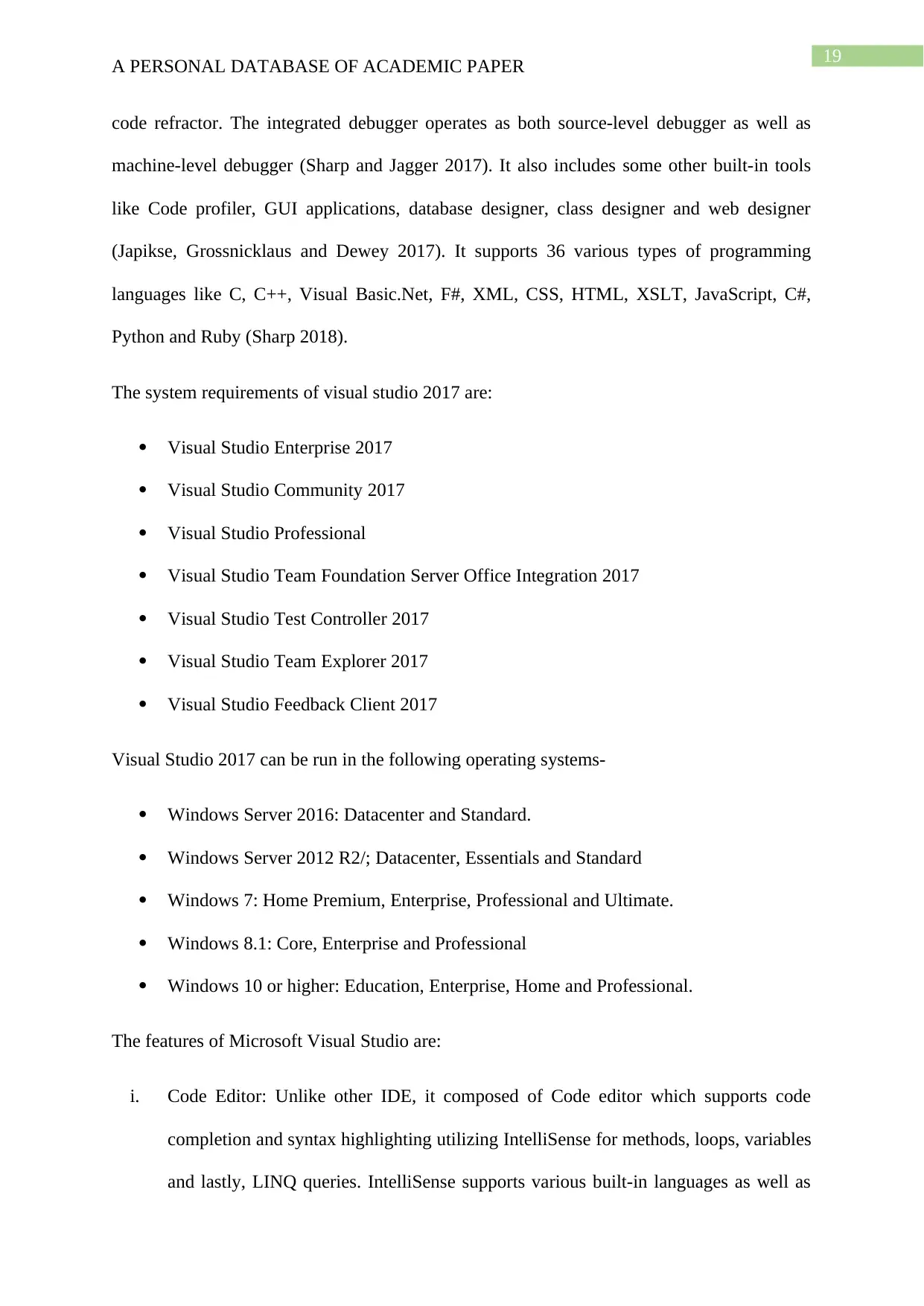
19
A PERSONAL DATABASE OF ACADEMIC PAPER
code refractor. The integrated debugger operates as both source-level debugger as well as
machine-level debugger (Sharp and Jagger 2017). It also includes some other built-in tools
like Code profiler, GUI applications, database designer, class designer and web designer
(Japikse, Grossnicklaus and Dewey 2017). It supports 36 various types of programming
languages like C, C++, Visual Basic.Net, F#, XML, CSS, HTML, XSLT, JavaScript, C#,
Python and Ruby (Sharp 2018).
The system requirements of visual studio 2017 are:
Visual Studio Enterprise 2017
Visual Studio Community 2017
Visual Studio Professional
Visual Studio Team Foundation Server Office Integration 2017
Visual Studio Test Controller 2017
Visual Studio Team Explorer 2017
Visual Studio Feedback Client 2017
Visual Studio 2017 can be run in the following operating systems-
Windows Server 2016: Datacenter and Standard.
Windows Server 2012 R2/; Datacenter, Essentials and Standard
Windows 7: Home Premium, Enterprise, Professional and Ultimate.
Windows 8.1: Core, Enterprise and Professional
Windows 10 or higher: Education, Enterprise, Home and Professional.
The features of Microsoft Visual Studio are:
i. Code Editor: Unlike other IDE, it composed of Code editor which supports code
completion and syntax highlighting utilizing IntelliSense for methods, loops, variables
and lastly, LINQ queries. IntelliSense supports various built-in languages as well as
A PERSONAL DATABASE OF ACADEMIC PAPER
code refractor. The integrated debugger operates as both source-level debugger as well as
machine-level debugger (Sharp and Jagger 2017). It also includes some other built-in tools
like Code profiler, GUI applications, database designer, class designer and web designer
(Japikse, Grossnicklaus and Dewey 2017). It supports 36 various types of programming
languages like C, C++, Visual Basic.Net, F#, XML, CSS, HTML, XSLT, JavaScript, C#,
Python and Ruby (Sharp 2018).
The system requirements of visual studio 2017 are:
Visual Studio Enterprise 2017
Visual Studio Community 2017
Visual Studio Professional
Visual Studio Team Foundation Server Office Integration 2017
Visual Studio Test Controller 2017
Visual Studio Team Explorer 2017
Visual Studio Feedback Client 2017
Visual Studio 2017 can be run in the following operating systems-
Windows Server 2016: Datacenter and Standard.
Windows Server 2012 R2/; Datacenter, Essentials and Standard
Windows 7: Home Premium, Enterprise, Professional and Ultimate.
Windows 8.1: Core, Enterprise and Professional
Windows 10 or higher: Education, Enterprise, Home and Professional.
The features of Microsoft Visual Studio are:
i. Code Editor: Unlike other IDE, it composed of Code editor which supports code
completion and syntax highlighting utilizing IntelliSense for methods, loops, variables
and lastly, LINQ queries. IntelliSense supports various built-in languages as well as
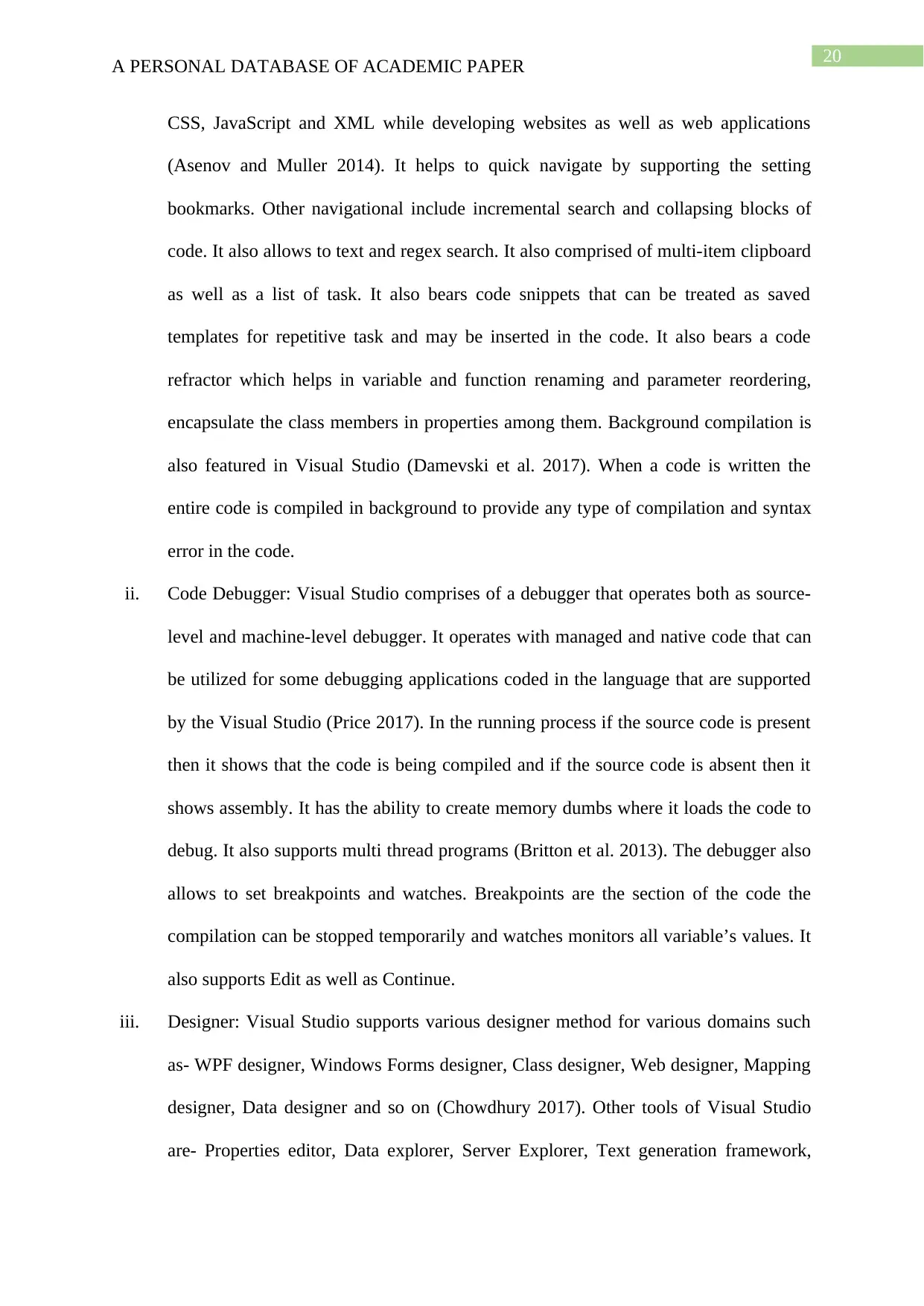
20
A PERSONAL DATABASE OF ACADEMIC PAPER
CSS, JavaScript and XML while developing websites as well as web applications
(Asenov and Muller 2014). It helps to quick navigate by supporting the setting
bookmarks. Other navigational include incremental search and collapsing blocks of
code. It also allows to text and regex search. It also comprised of multi-item clipboard
as well as a list of task. It also bears code snippets that can be treated as saved
templates for repetitive task and may be inserted in the code. It also bears a code
refractor which helps in variable and function renaming and parameter reordering,
encapsulate the class members in properties among them. Background compilation is
also featured in Visual Studio (Damevski et al. 2017). When a code is written the
entire code is compiled in background to provide any type of compilation and syntax
error in the code.
ii. Code Debugger: Visual Studio comprises of a debugger that operates both as source-
level and machine-level debugger. It operates with managed and native code that can
be utilized for some debugging applications coded in the language that are supported
by the Visual Studio (Price 2017). In the running process if the source code is present
then it shows that the code is being compiled and if the source code is absent then it
shows assembly. It has the ability to create memory dumbs where it loads the code to
debug. It also supports multi thread programs (Britton et al. 2013). The debugger also
allows to set breakpoints and watches. Breakpoints are the section of the code the
compilation can be stopped temporarily and watches monitors all variable’s values. It
also supports Edit as well as Continue.
iii. Designer: Visual Studio supports various designer method for various domains such
as- WPF designer, Windows Forms designer, Class designer, Web designer, Mapping
designer, Data designer and so on (Chowdhury 2017). Other tools of Visual Studio
are- Properties editor, Data explorer, Server Explorer, Text generation framework,
A PERSONAL DATABASE OF ACADEMIC PAPER
CSS, JavaScript and XML while developing websites as well as web applications
(Asenov and Muller 2014). It helps to quick navigate by supporting the setting
bookmarks. Other navigational include incremental search and collapsing blocks of
code. It also allows to text and regex search. It also comprised of multi-item clipboard
as well as a list of task. It also bears code snippets that can be treated as saved
templates for repetitive task and may be inserted in the code. It also bears a code
refractor which helps in variable and function renaming and parameter reordering,
encapsulate the class members in properties among them. Background compilation is
also featured in Visual Studio (Damevski et al. 2017). When a code is written the
entire code is compiled in background to provide any type of compilation and syntax
error in the code.
ii. Code Debugger: Visual Studio comprises of a debugger that operates both as source-
level and machine-level debugger. It operates with managed and native code that can
be utilized for some debugging applications coded in the language that are supported
by the Visual Studio (Price 2017). In the running process if the source code is present
then it shows that the code is being compiled and if the source code is absent then it
shows assembly. It has the ability to create memory dumbs where it loads the code to
debug. It also supports multi thread programs (Britton et al. 2013). The debugger also
allows to set breakpoints and watches. Breakpoints are the section of the code the
compilation can be stopped temporarily and watches monitors all variable’s values. It
also supports Edit as well as Continue.
iii. Designer: Visual Studio supports various designer method for various domains such
as- WPF designer, Windows Forms designer, Class designer, Web designer, Mapping
designer, Data designer and so on (Chowdhury 2017). Other tools of Visual Studio
are- Properties editor, Data explorer, Server Explorer, Text generation framework,
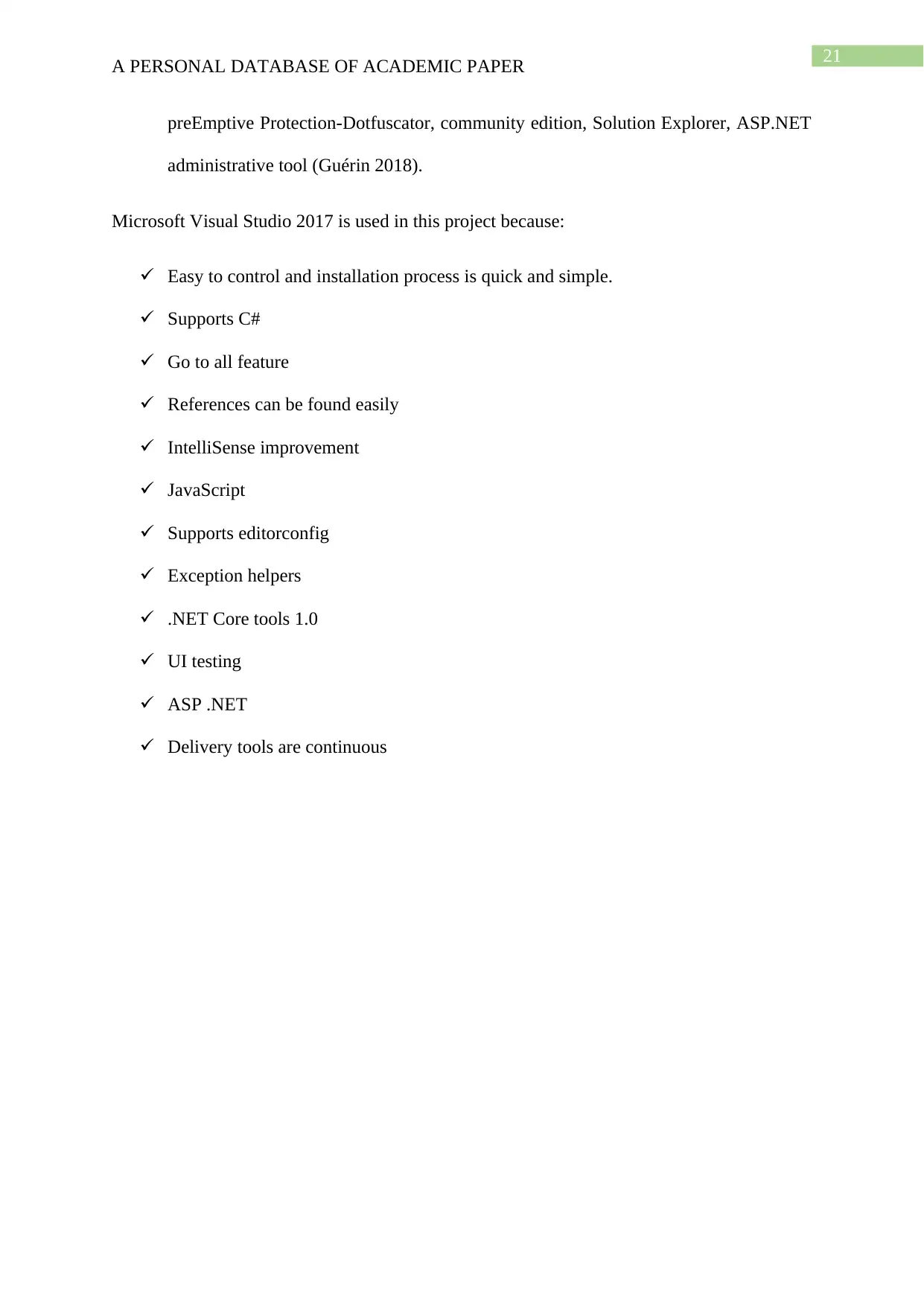
21
A PERSONAL DATABASE OF ACADEMIC PAPER
preEmptive Protection-Dotfuscator, community edition, Solution Explorer, ASP.NET
administrative tool (Guérin 2018).
Microsoft Visual Studio 2017 is used in this project because:
Easy to control and installation process is quick and simple.
Supports C#
Go to all feature
References can be found easily
IntelliSense improvement
JavaScript
Supports editorconfig
Exception helpers
.NET Core tools 1.0
UI testing
ASP .NET
Delivery tools are continuous
A PERSONAL DATABASE OF ACADEMIC PAPER
preEmptive Protection-Dotfuscator, community edition, Solution Explorer, ASP.NET
administrative tool (Guérin 2018).
Microsoft Visual Studio 2017 is used in this project because:
Easy to control and installation process is quick and simple.
Supports C#
Go to all feature
References can be found easily
IntelliSense improvement
JavaScript
Supports editorconfig
Exception helpers
.NET Core tools 1.0
UI testing
ASP .NET
Delivery tools are continuous
Secure Best Marks with AI Grader
Need help grading? Try our AI Grader for instant feedback on your assignments.
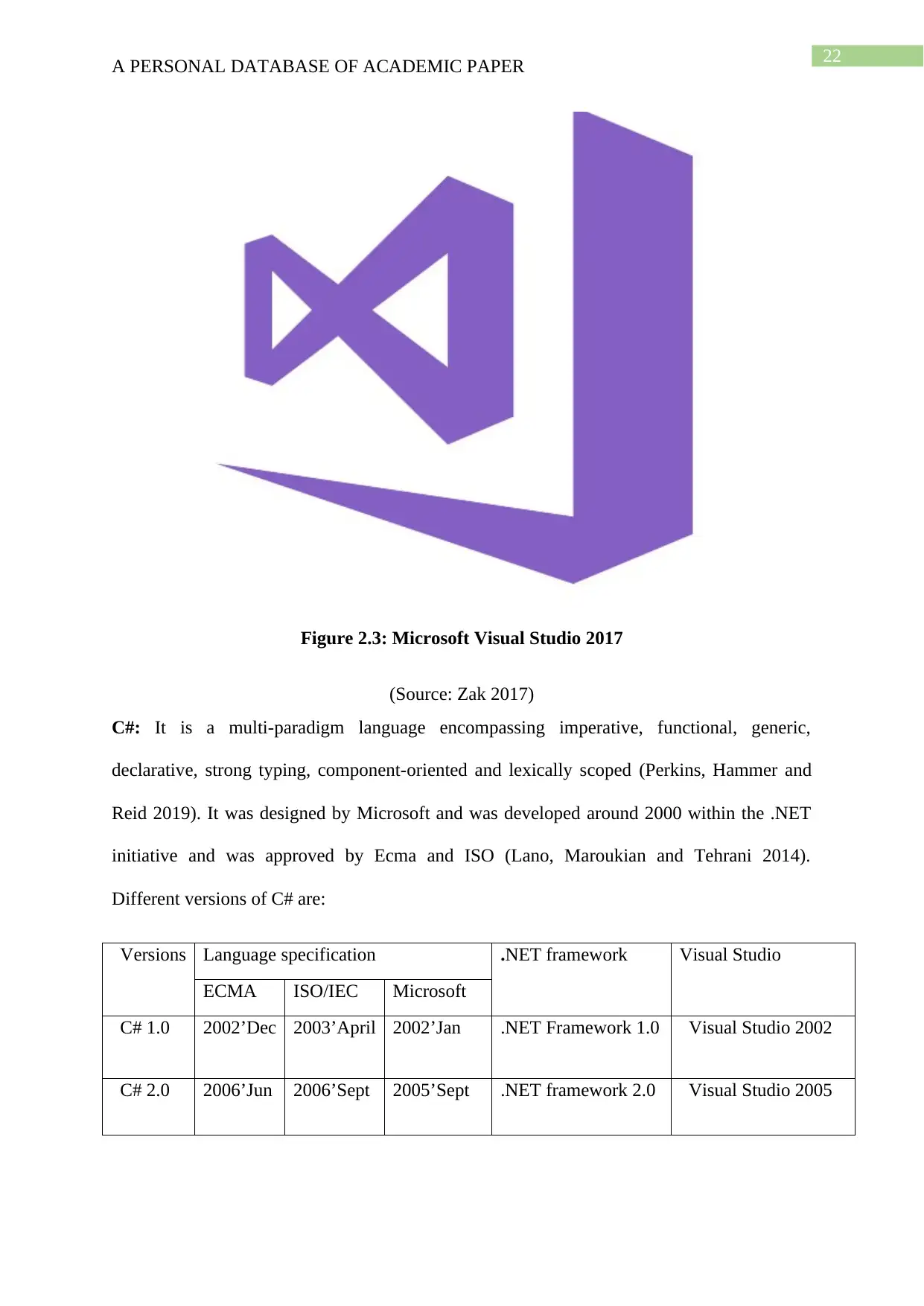
22
A PERSONAL DATABASE OF ACADEMIC PAPER
Figure 2.3: Microsoft Visual Studio 2017
(Source: Zak 2017)
C#: It is a multi-paradigm language encompassing imperative, functional, generic,
declarative, strong typing, component-oriented and lexically scoped (Perkins, Hammer and
Reid 2019). It was designed by Microsoft and was developed around 2000 within the .NET
initiative and was approved by Ecma and ISO (Lano, Maroukian and Tehrani 2014).
Different versions of C# are:
Versions Language specification .NET framework Visual Studio
ECMA ISO/IEC Microsoft
C# 1.0 2002’Dec 2003’April 2002’Jan .NET Framework 1.0 Visual Studio 2002
C# 2.0 2006’Jun 2006’Sept 2005’Sept .NET framework 2.0 Visual Studio 2005
A PERSONAL DATABASE OF ACADEMIC PAPER
Figure 2.3: Microsoft Visual Studio 2017
(Source: Zak 2017)
C#: It is a multi-paradigm language encompassing imperative, functional, generic,
declarative, strong typing, component-oriented and lexically scoped (Perkins, Hammer and
Reid 2019). It was designed by Microsoft and was developed around 2000 within the .NET
initiative and was approved by Ecma and ISO (Lano, Maroukian and Tehrani 2014).
Different versions of C# are:
Versions Language specification .NET framework Visual Studio
ECMA ISO/IEC Microsoft
C# 1.0 2002’Dec 2003’April 2002’Jan .NET Framework 1.0 Visual Studio 2002
C# 2.0 2006’Jun 2006’Sept 2005’Sept .NET framework 2.0 Visual Studio 2005
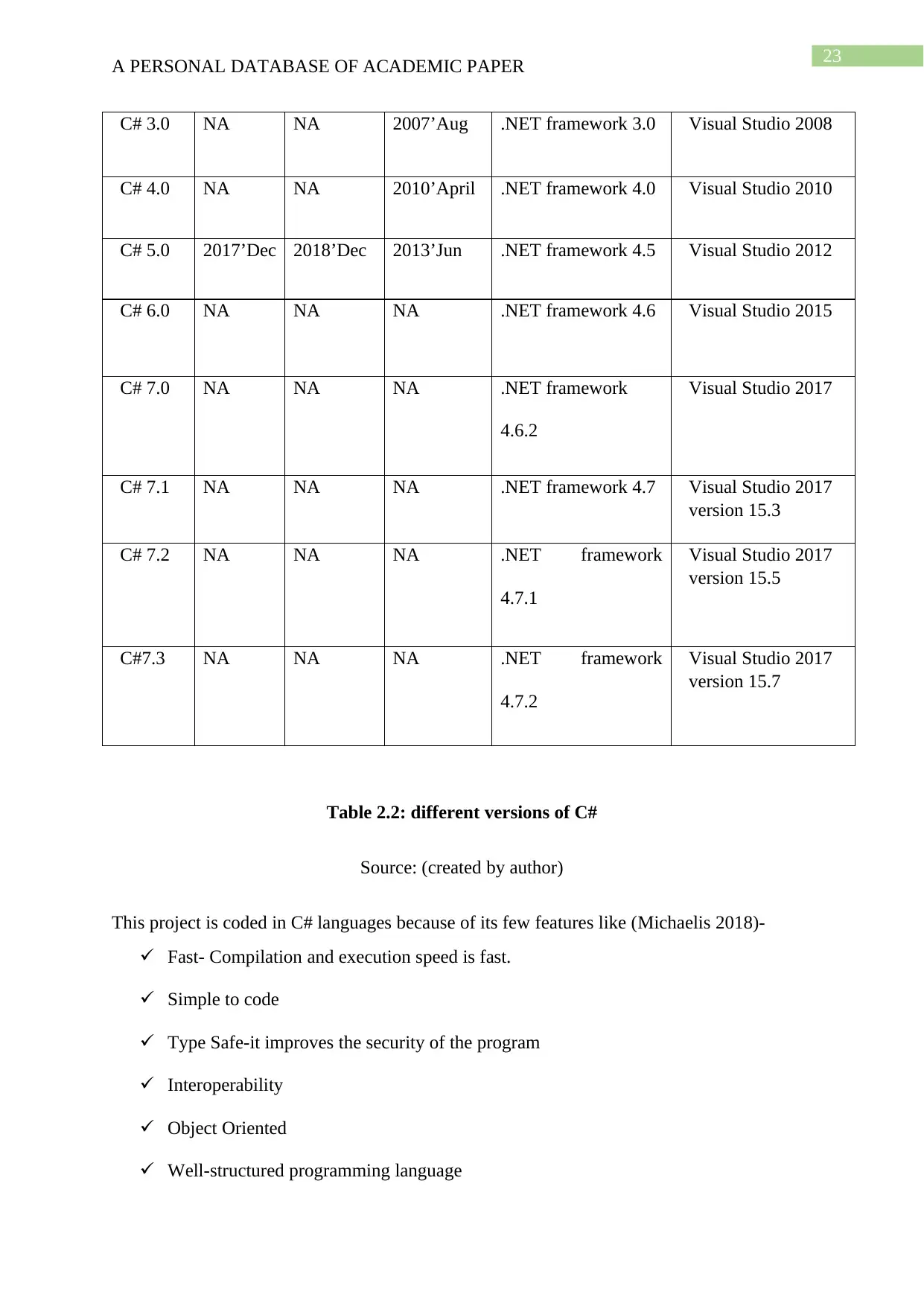
23
A PERSONAL DATABASE OF ACADEMIC PAPER
C# 3.0 NA NA 2007’Aug .NET framework 3.0 Visual Studio 2008
C# 4.0 NA NA 2010’April .NET framework 4.0 Visual Studio 2010
C# 5.0 2017’Dec 2018’Dec 2013’Jun .NET framework 4.5 Visual Studio 2012
C# 6.0 NA NA NA .NET framework 4.6 Visual Studio 2015
C# 7.0 NA NA NA .NET framework
4.6.2
Visual Studio 2017
C# 7.1 NA NA NA .NET framework 4.7 Visual Studio 2017
version 15.3
C# 7.2 NA NA NA .NET framework
4.7.1
Visual Studio 2017
version 15.5
C#7.3 NA NA NA .NET framework
4.7.2
Visual Studio 2017
version 15.7
Table 2.2: different versions of C#
Source: (created by author)
This project is coded in C# languages because of its few features like (Michaelis 2018)-
Fast- Compilation and execution speed is fast.
Simple to code
Type Safe-it improves the security of the program
Interoperability
Object Oriented
Well-structured programming language
A PERSONAL DATABASE OF ACADEMIC PAPER
C# 3.0 NA NA 2007’Aug .NET framework 3.0 Visual Studio 2008
C# 4.0 NA NA 2010’April .NET framework 4.0 Visual Studio 2010
C# 5.0 2017’Dec 2018’Dec 2013’Jun .NET framework 4.5 Visual Studio 2012
C# 6.0 NA NA NA .NET framework 4.6 Visual Studio 2015
C# 7.0 NA NA NA .NET framework
4.6.2
Visual Studio 2017
C# 7.1 NA NA NA .NET framework 4.7 Visual Studio 2017
version 15.3
C# 7.2 NA NA NA .NET framework
4.7.1
Visual Studio 2017
version 15.5
C#7.3 NA NA NA .NET framework
4.7.2
Visual Studio 2017
version 15.7
Table 2.2: different versions of C#
Source: (created by author)
This project is coded in C# languages because of its few features like (Michaelis 2018)-
Fast- Compilation and execution speed is fast.
Simple to code
Type Safe-it improves the security of the program
Interoperability
Object Oriented
Well-structured programming language
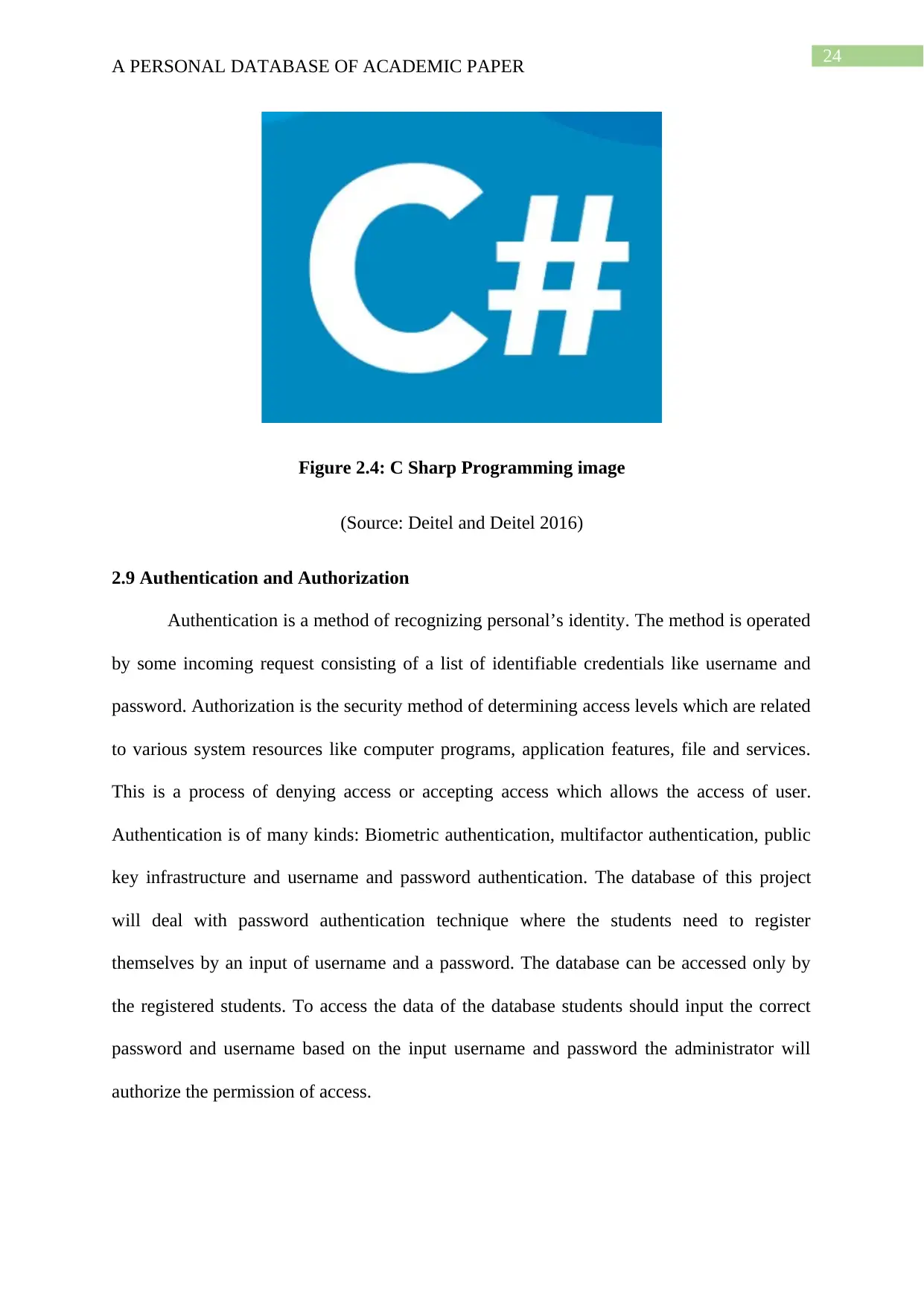
24
A PERSONAL DATABASE OF ACADEMIC PAPER
Figure 2.4: C Sharp Programming image
(Source: Deitel and Deitel 2016)
2.9 Authentication and Authorization
Authentication is a method of recognizing personal’s identity. The method is operated
by some incoming request consisting of a list of identifiable credentials like username and
password. Authorization is the security method of determining access levels which are related
to various system resources like computer programs, application features, file and services.
This is a process of denying access or accepting access which allows the access of user.
Authentication is of many kinds: Biometric authentication, multifactor authentication, public
key infrastructure and username and password authentication. The database of this project
will deal with password authentication technique where the students need to register
themselves by an input of username and a password. The database can be accessed only by
the registered students. To access the data of the database students should input the correct
password and username based on the input username and password the administrator will
authorize the permission of access.
A PERSONAL DATABASE OF ACADEMIC PAPER
Figure 2.4: C Sharp Programming image
(Source: Deitel and Deitel 2016)
2.9 Authentication and Authorization
Authentication is a method of recognizing personal’s identity. The method is operated
by some incoming request consisting of a list of identifiable credentials like username and
password. Authorization is the security method of determining access levels which are related
to various system resources like computer programs, application features, file and services.
This is a process of denying access or accepting access which allows the access of user.
Authentication is of many kinds: Biometric authentication, multifactor authentication, public
key infrastructure and username and password authentication. The database of this project
will deal with password authentication technique where the students need to register
themselves by an input of username and a password. The database can be accessed only by
the registered students. To access the data of the database students should input the correct
password and username based on the input username and password the administrator will
authorize the permission of access.
Paraphrase This Document
Need a fresh take? Get an instant paraphrase of this document with our AI Paraphraser
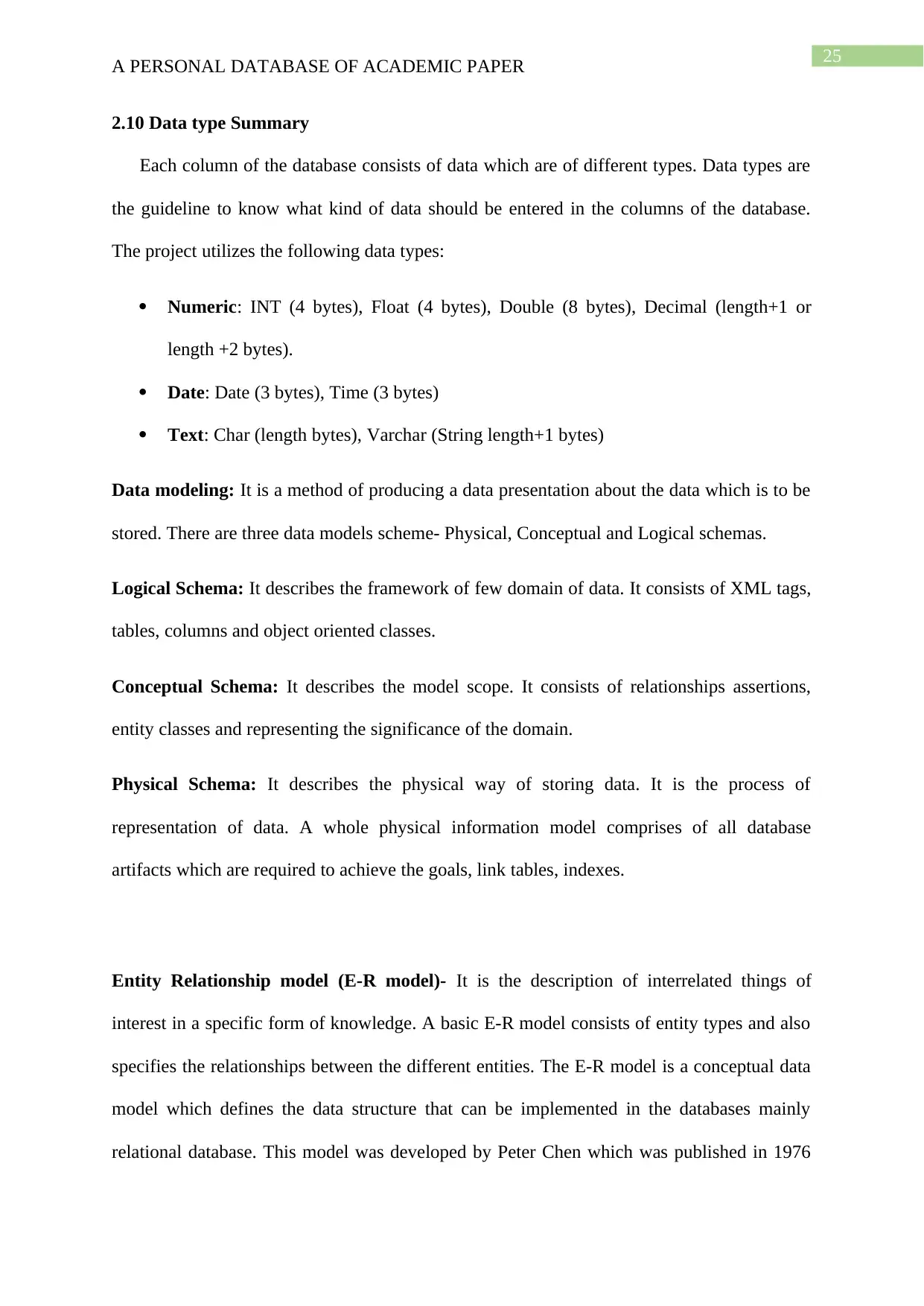
25
A PERSONAL DATABASE OF ACADEMIC PAPER
2.10 Data type Summary
Each column of the database consists of data which are of different types. Data types are
the guideline to know what kind of data should be entered in the columns of the database.
The project utilizes the following data types:
Numeric: INT (4 bytes), Float (4 bytes), Double (8 bytes), Decimal (length+1 or
length +2 bytes).
Date: Date (3 bytes), Time (3 bytes)
Text: Char (length bytes), Varchar (String length+1 bytes)
Data modeling: It is a method of producing a data presentation about the data which is to be
stored. There are three data models scheme- Physical, Conceptual and Logical schemas.
Logical Schema: It describes the framework of few domain of data. It consists of XML tags,
tables, columns and object oriented classes.
Conceptual Schema: It describes the model scope. It consists of relationships assertions,
entity classes and representing the significance of the domain.
Physical Schema: It describes the physical way of storing data. It is the process of
representation of data. A whole physical information model comprises of all database
artifacts which are required to achieve the goals, link tables, indexes.
Entity Relationship model (E-R model)- It is the description of interrelated things of
interest in a specific form of knowledge. A basic E-R model consists of entity types and also
specifies the relationships between the different entities. The E-R model is a conceptual data
model which defines the data structure that can be implemented in the databases mainly
relational database. This model was developed by Peter Chen which was published in 1976
A PERSONAL DATABASE OF ACADEMIC PAPER
2.10 Data type Summary
Each column of the database consists of data which are of different types. Data types are
the guideline to know what kind of data should be entered in the columns of the database.
The project utilizes the following data types:
Numeric: INT (4 bytes), Float (4 bytes), Double (8 bytes), Decimal (length+1 or
length +2 bytes).
Date: Date (3 bytes), Time (3 bytes)
Text: Char (length bytes), Varchar (String length+1 bytes)
Data modeling: It is a method of producing a data presentation about the data which is to be
stored. There are three data models scheme- Physical, Conceptual and Logical schemas.
Logical Schema: It describes the framework of few domain of data. It consists of XML tags,
tables, columns and object oriented classes.
Conceptual Schema: It describes the model scope. It consists of relationships assertions,
entity classes and representing the significance of the domain.
Physical Schema: It describes the physical way of storing data. It is the process of
representation of data. A whole physical information model comprises of all database
artifacts which are required to achieve the goals, link tables, indexes.
Entity Relationship model (E-R model)- It is the description of interrelated things of
interest in a specific form of knowledge. A basic E-R model consists of entity types and also
specifies the relationships between the different entities. The E-R model is a conceptual data
model which defines the data structure that can be implemented in the databases mainly
relational database. This model was developed by Peter Chen which was published in 1976
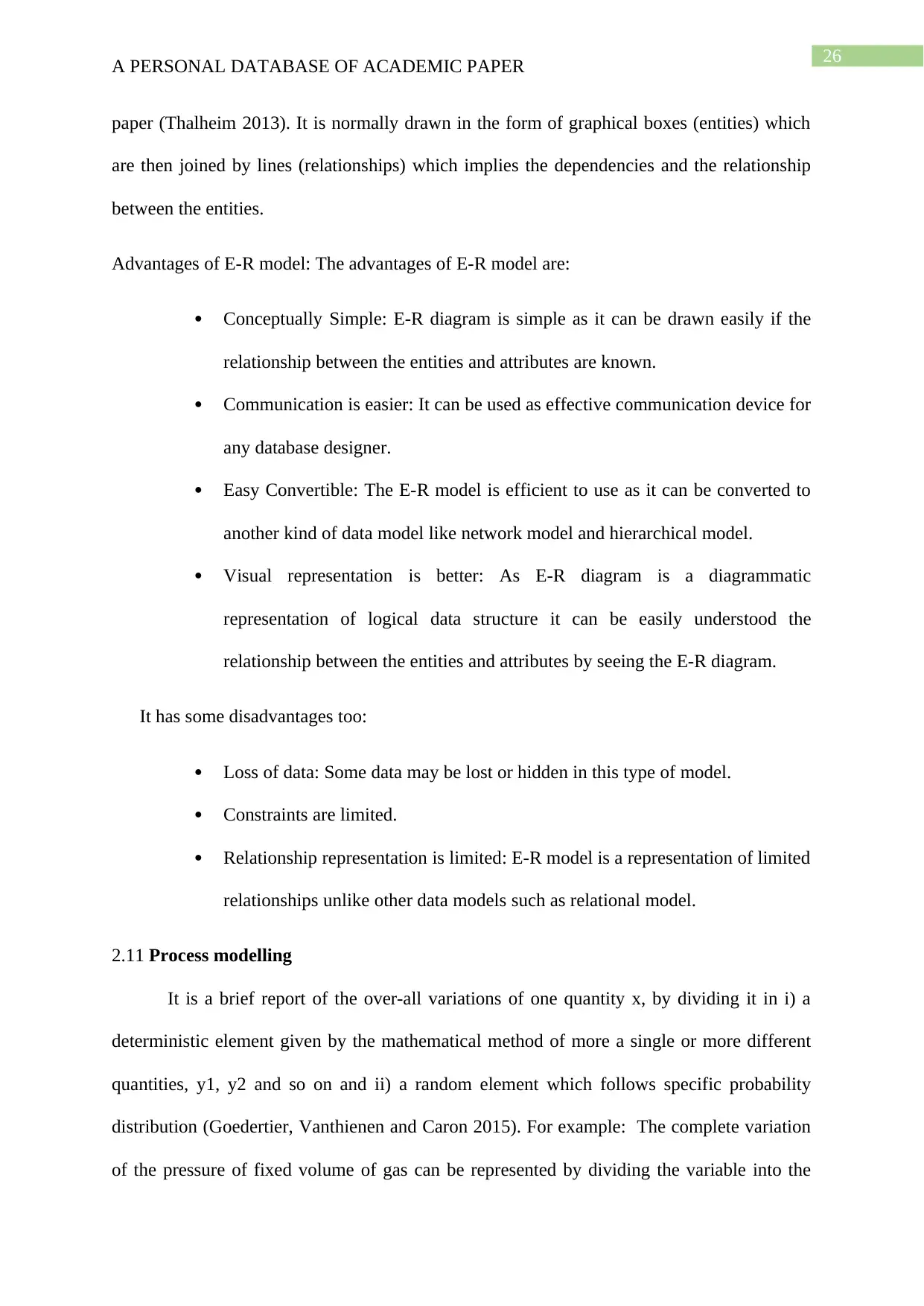
26
A PERSONAL DATABASE OF ACADEMIC PAPER
paper (Thalheim 2013). It is normally drawn in the form of graphical boxes (entities) which
are then joined by lines (relationships) which implies the dependencies and the relationship
between the entities.
Advantages of E-R model: The advantages of E-R model are:
Conceptually Simple: E-R diagram is simple as it can be drawn easily if the
relationship between the entities and attributes are known.
Communication is easier: It can be used as effective communication device for
any database designer.
Easy Convertible: The E-R model is efficient to use as it can be converted to
another kind of data model like network model and hierarchical model.
Visual representation is better: As E-R diagram is a diagrammatic
representation of logical data structure it can be easily understood the
relationship between the entities and attributes by seeing the E-R diagram.
It has some disadvantages too:
Loss of data: Some data may be lost or hidden in this type of model.
Constraints are limited.
Relationship representation is limited: E-R model is a representation of limited
relationships unlike other data models such as relational model.
2.11 Process modelling
It is a brief report of the over-all variations of one quantity x, by dividing it in i) a
deterministic element given by the mathematical method of more a single or more different
quantities, y1, y2 and so on and ii) a random element which follows specific probability
distribution (Goedertier, Vanthienen and Caron 2015). For example: The complete variation
of the pressure of fixed volume of gas can be represented by dividing the variable into the
A PERSONAL DATABASE OF ACADEMIC PAPER
paper (Thalheim 2013). It is normally drawn in the form of graphical boxes (entities) which
are then joined by lines (relationships) which implies the dependencies and the relationship
between the entities.
Advantages of E-R model: The advantages of E-R model are:
Conceptually Simple: E-R diagram is simple as it can be drawn easily if the
relationship between the entities and attributes are known.
Communication is easier: It can be used as effective communication device for
any database designer.
Easy Convertible: The E-R model is efficient to use as it can be converted to
another kind of data model like network model and hierarchical model.
Visual representation is better: As E-R diagram is a diagrammatic
representation of logical data structure it can be easily understood the
relationship between the entities and attributes by seeing the E-R diagram.
It has some disadvantages too:
Loss of data: Some data may be lost or hidden in this type of model.
Constraints are limited.
Relationship representation is limited: E-R model is a representation of limited
relationships unlike other data models such as relational model.
2.11 Process modelling
It is a brief report of the over-all variations of one quantity x, by dividing it in i) a
deterministic element given by the mathematical method of more a single or more different
quantities, y1, y2 and so on and ii) a random element which follows specific probability
distribution (Goedertier, Vanthienen and Caron 2015). For example: The complete variation
of the pressure of fixed volume of gas can be represented by dividing the variable into the

27
A PERSONAL DATABASE OF ACADEMIC PAPER
deterministic section, that is the temperature of the taken gas with few left-over regular
errors. According to the Charles law the volume of a gas is directly proportional to the
temperature of the gas keeping the pressure of the gas remains constant. The relationship will
fail if there is any error in the measurement of the pressure in the pressure gauge. This type of
random errors are not characterized individually yet it will follow few probability distribution
which will define the comparative frequencies of various sized errors. The project typically
utilizes process modelling for various reasons like: Human understanding, Automation
execution, process management, process improvement.
2.12 System testing
System testing analysis aims to detect all the defects in this project. The defect of the
project will be identified by analyzing the output on the set of input data. This project
undergone two types of testing:
UNIT TESTING: It is done on every module of the project.
Test for the admin module:
i. Test for admin login- It is page for web administrator where he or she will enter the
username and password and then it gets checked, if both values are correct then
administration page opens else if the combination of the inputs are incorrect then it
gets redirected again to the login page where it asks to input correct username and
password.
ii. Addition of Student account: In this part the admin verify the registration form
entered by a student. The admin need to verify the validation of the academic
information of the student then the admin clicks add or delete button based on his or
her checking and based on his or her observations the student details is added to the
main library database.
A PERSONAL DATABASE OF ACADEMIC PAPER
deterministic section, that is the temperature of the taken gas with few left-over regular
errors. According to the Charles law the volume of a gas is directly proportional to the
temperature of the gas keeping the pressure of the gas remains constant. The relationship will
fail if there is any error in the measurement of the pressure in the pressure gauge. This type of
random errors are not characterized individually yet it will follow few probability distribution
which will define the comparative frequencies of various sized errors. The project typically
utilizes process modelling for various reasons like: Human understanding, Automation
execution, process management, process improvement.
2.12 System testing
System testing analysis aims to detect all the defects in this project. The defect of the
project will be identified by analyzing the output on the set of input data. This project
undergone two types of testing:
UNIT TESTING: It is done on every module of the project.
Test for the admin module:
i. Test for admin login- It is page for web administrator where he or she will enter the
username and password and then it gets checked, if both values are correct then
administration page opens else if the combination of the inputs are incorrect then it
gets redirected again to the login page where it asks to input correct username and
password.
ii. Addition of Student account: In this part the admin verify the registration form
entered by a student. The admin need to verify the validation of the academic
information of the student then the admin clicks add or delete button based on his or
her checking and based on his or her observations the student details is added to the
main library database.
Secure Best Marks with AI Grader
Need help grading? Try our AI Grader for instant feedback on your assignments.
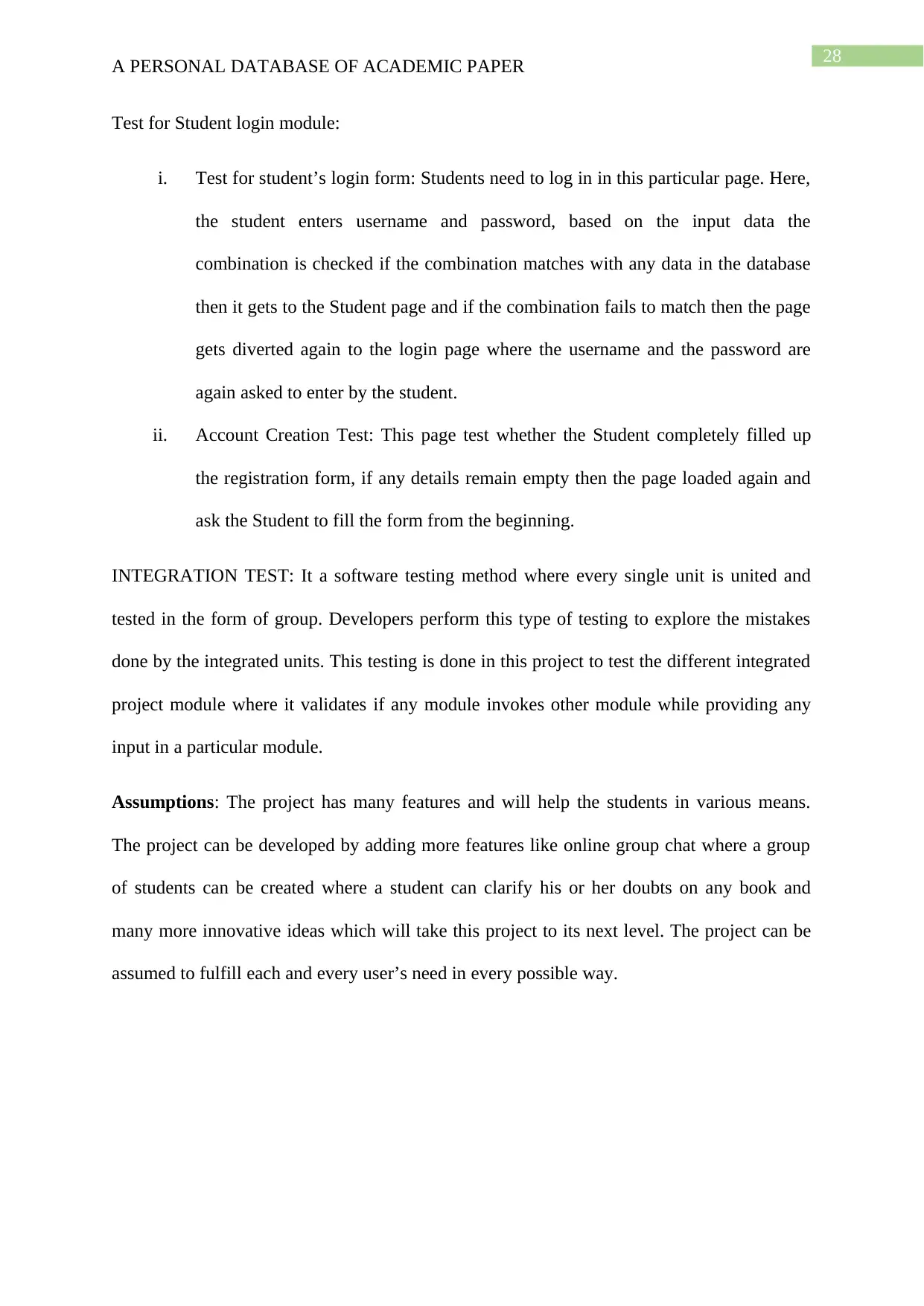
28
A PERSONAL DATABASE OF ACADEMIC PAPER
Test for Student login module:
i. Test for student’s login form: Students need to log in in this particular page. Here,
the student enters username and password, based on the input data the
combination is checked if the combination matches with any data in the database
then it gets to the Student page and if the combination fails to match then the page
gets diverted again to the login page where the username and the password are
again asked to enter by the student.
ii. Account Creation Test: This page test whether the Student completely filled up
the registration form, if any details remain empty then the page loaded again and
ask the Student to fill the form from the beginning.
INTEGRATION TEST: It a software testing method where every single unit is united and
tested in the form of group. Developers perform this type of testing to explore the mistakes
done by the integrated units. This testing is done in this project to test the different integrated
project module where it validates if any module invokes other module while providing any
input in a particular module.
Assumptions: The project has many features and will help the students in various means.
The project can be developed by adding more features like online group chat where a group
of students can be created where a student can clarify his or her doubts on any book and
many more innovative ideas which will take this project to its next level. The project can be
assumed to fulfill each and every user’s need in every possible way.
A PERSONAL DATABASE OF ACADEMIC PAPER
Test for Student login module:
i. Test for student’s login form: Students need to log in in this particular page. Here,
the student enters username and password, based on the input data the
combination is checked if the combination matches with any data in the database
then it gets to the Student page and if the combination fails to match then the page
gets diverted again to the login page where the username and the password are
again asked to enter by the student.
ii. Account Creation Test: This page test whether the Student completely filled up
the registration form, if any details remain empty then the page loaded again and
ask the Student to fill the form from the beginning.
INTEGRATION TEST: It a software testing method where every single unit is united and
tested in the form of group. Developers perform this type of testing to explore the mistakes
done by the integrated units. This testing is done in this project to test the different integrated
project module where it validates if any module invokes other module while providing any
input in a particular module.
Assumptions: The project has many features and will help the students in various means.
The project can be developed by adding more features like online group chat where a group
of students can be created where a student can clarify his or her doubts on any book and
many more innovative ideas which will take this project to its next level. The project can be
assumed to fulfill each and every user’s need in every possible way.

29
A PERSONAL DATABASE OF ACADEMIC PAPER
Chapter 3: Research Methodology
3.1 Introduction
According to Brown and Stowers (2013) research methodology is used as the
introduction of the statistical device that is used to analyse the data. According to Silverman
(2016) research methodology also represents the scientific research process and the methods
used for the scientific inquiry. Research methods comprises of the techniques used and
methods adopted to complete the research successfully. Research methodology helps to solve
all types of research problems.
3.2 Method Outline:
The project contains many research techniques to successfully design the proposed
database for the university students which will have a great impact on Students by helping
them in various ways . The research chooses positivism as the research philosophy and
applied deductive method for research approach because it helps the researcher to concentrate
on the previous research and equivalent model that are proposed earlier. Further the selected
mode of approach allows the researcher to study the reviews of the university students and
the admin of the database. The researcher applied analytical or descriptive design method as
the research design method. The researcher collected data by both primary and secondary
means that are needed to successfully design the database.
3.3 Research Philosophy
Research Philosophy is the study of the nature and the development of knowledge
(Knobe and Nichols 2013). The idea of the research philosophy requires to collect the data
from both primary as well as the secondary sources to express the new innovation in the
proposed database system. Basically, it is list of beliefs comprising of three kinds such as
positivism, realism and interpretivism (Hughes and Sharrock 2016). Positivism is the method
A PERSONAL DATABASE OF ACADEMIC PAPER
Chapter 3: Research Methodology
3.1 Introduction
According to Brown and Stowers (2013) research methodology is used as the
introduction of the statistical device that is used to analyse the data. According to Silverman
(2016) research methodology also represents the scientific research process and the methods
used for the scientific inquiry. Research methods comprises of the techniques used and
methods adopted to complete the research successfully. Research methodology helps to solve
all types of research problems.
3.2 Method Outline:
The project contains many research techniques to successfully design the proposed
database for the university students which will have a great impact on Students by helping
them in various ways . The research chooses positivism as the research philosophy and
applied deductive method for research approach because it helps the researcher to concentrate
on the previous research and equivalent model that are proposed earlier. Further the selected
mode of approach allows the researcher to study the reviews of the university students and
the admin of the database. The researcher applied analytical or descriptive design method as
the research design method. The researcher collected data by both primary and secondary
means that are needed to successfully design the database.
3.3 Research Philosophy
Research Philosophy is the study of the nature and the development of knowledge
(Knobe and Nichols 2013). The idea of the research philosophy requires to collect the data
from both primary as well as the secondary sources to express the new innovation in the
proposed database system. Basically, it is list of beliefs comprising of three kinds such as
positivism, realism and interpretivism (Hughes and Sharrock 2016). Positivism is the method
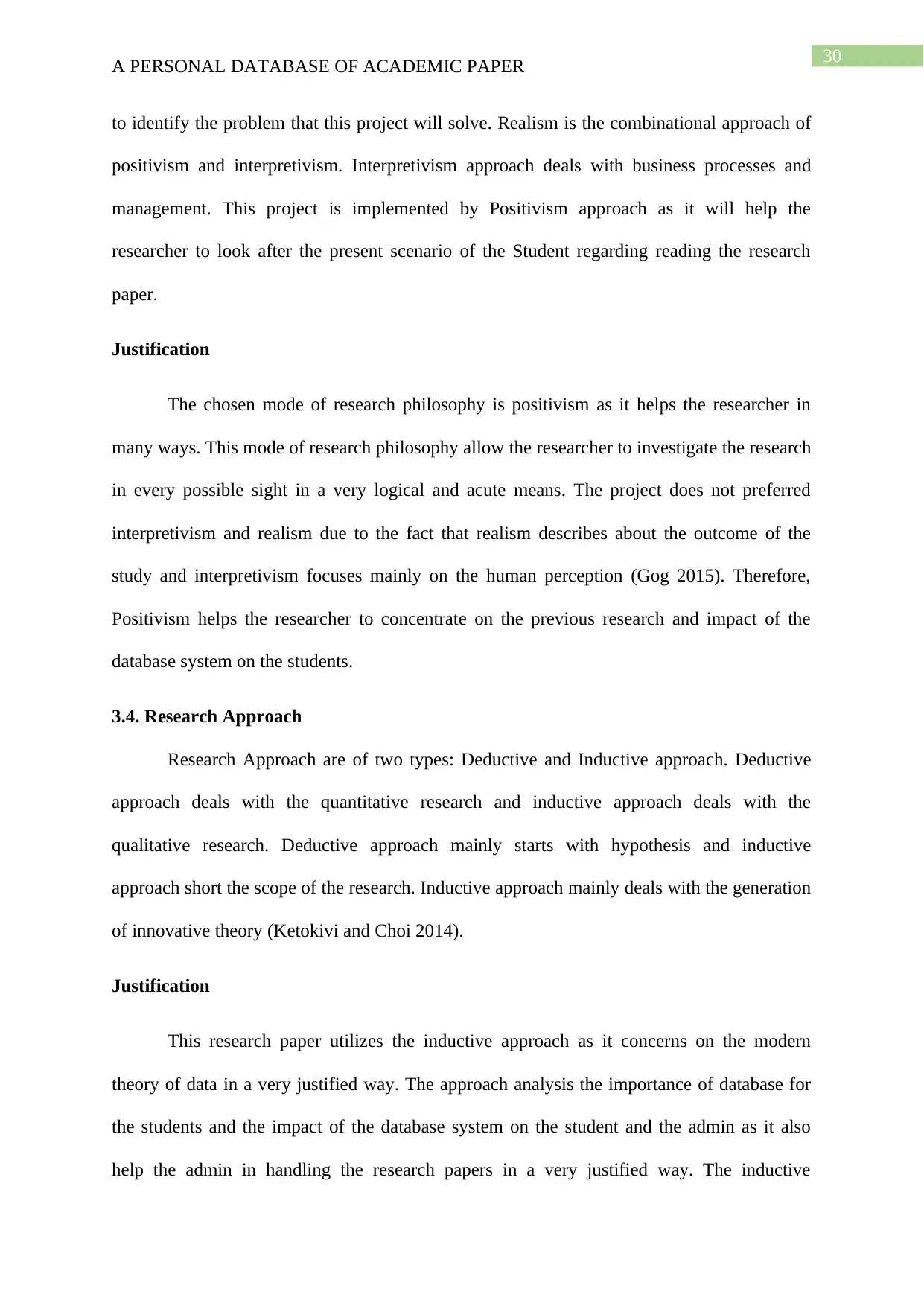
30
A PERSONAL DATABASE OF ACADEMIC PAPER
to identify the problem that this project will solve. Realism is the combinational approach of
positivism and interpretivism. Interpretivism approach deals with business processes and
management. This project is implemented by Positivism approach as it will help the
researcher to look after the present scenario of the Student regarding reading the research
paper.
Justification
The chosen mode of research philosophy is positivism as it helps the researcher in
many ways. This mode of research philosophy allow the researcher to investigate the research
in every possible sight in a very logical and acute means. The project does not preferred
interpretivism and realism due to the fact that realism describes about the outcome of the
study and interpretivism focuses mainly on the human perception (Gog 2015). Therefore,
Positivism helps the researcher to concentrate on the previous research and impact of the
database system on the students.
3.4. Research Approach
Research Approach are of two types: Deductive and Inductive approach. Deductive
approach deals with the quantitative research and inductive approach deals with the
qualitative research. Deductive approach mainly starts with hypothesis and inductive
approach short the scope of the research. Inductive approach mainly deals with the generation
of innovative theory (Ketokivi and Choi 2014).
Justification
This research paper utilizes the inductive approach as it concerns on the modern
theory of data in a very justified way. The approach analysis the importance of database for
the students and the impact of the database system on the student and the admin as it also
help the admin in handling the research papers in a very justified way. The inductive
A PERSONAL DATABASE OF ACADEMIC PAPER
to identify the problem that this project will solve. Realism is the combinational approach of
positivism and interpretivism. Interpretivism approach deals with business processes and
management. This project is implemented by Positivism approach as it will help the
researcher to look after the present scenario of the Student regarding reading the research
paper.
Justification
The chosen mode of research philosophy is positivism as it helps the researcher in
many ways. This mode of research philosophy allow the researcher to investigate the research
in every possible sight in a very logical and acute means. The project does not preferred
interpretivism and realism due to the fact that realism describes about the outcome of the
study and interpretivism focuses mainly on the human perception (Gog 2015). Therefore,
Positivism helps the researcher to concentrate on the previous research and impact of the
database system on the students.
3.4. Research Approach
Research Approach are of two types: Deductive and Inductive approach. Deductive
approach deals with the quantitative research and inductive approach deals with the
qualitative research. Deductive approach mainly starts with hypothesis and inductive
approach short the scope of the research. Inductive approach mainly deals with the generation
of innovative theory (Ketokivi and Choi 2014).
Justification
This research paper utilizes the inductive approach as it concerns on the modern
theory of data in a very justified way. The approach analysis the importance of database for
the students and the impact of the database system on the student and the admin as it also
help the admin in handling the research papers in a very justified way. The inductive
Paraphrase This Document
Need a fresh take? Get an instant paraphrase of this document with our AI Paraphraser
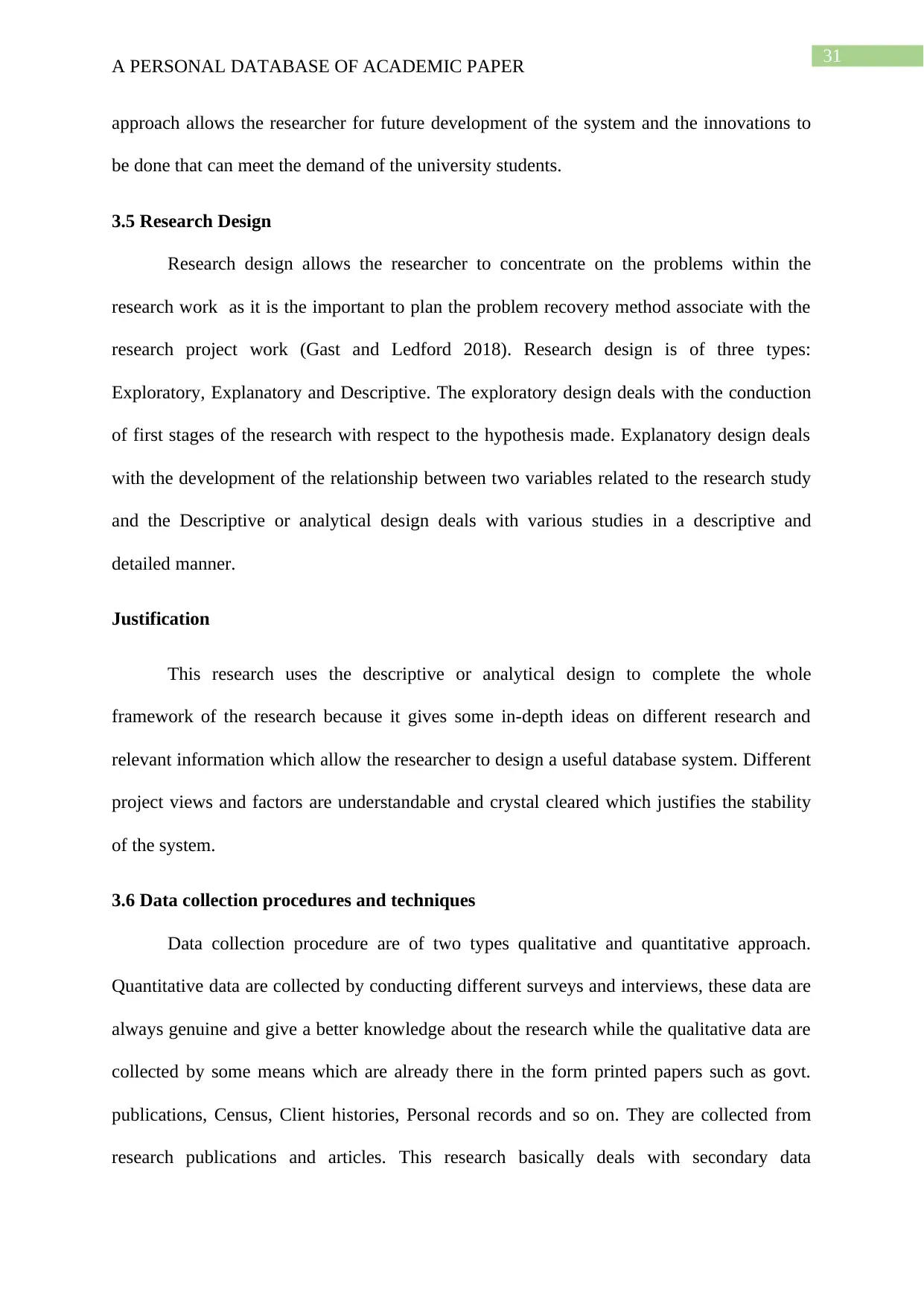
31
A PERSONAL DATABASE OF ACADEMIC PAPER
approach allows the researcher for future development of the system and the innovations to
be done that can meet the demand of the university students.
3.5 Research Design
Research design allows the researcher to concentrate on the problems within the
research work as it is the important to plan the problem recovery method associate with the
research project work (Gast and Ledford 2018). Research design is of three types:
Exploratory, Explanatory and Descriptive. The exploratory design deals with the conduction
of first stages of the research with respect to the hypothesis made. Explanatory design deals
with the development of the relationship between two variables related to the research study
and the Descriptive or analytical design deals with various studies in a descriptive and
detailed manner.
Justification
This research uses the descriptive or analytical design to complete the whole
framework of the research because it gives some in-depth ideas on different research and
relevant information which allow the researcher to design a useful database system. Different
project views and factors are understandable and crystal cleared which justifies the stability
of the system.
3.6 Data collection procedures and techniques
Data collection procedure are of two types qualitative and quantitative approach.
Quantitative data are collected by conducting different surveys and interviews, these data are
always genuine and give a better knowledge about the research while the qualitative data are
collected by some means which are already there in the form printed papers such as govt.
publications, Census, Client histories, Personal records and so on. They are collected from
research publications and articles. This research basically deals with secondary data
A PERSONAL DATABASE OF ACADEMIC PAPER
approach allows the researcher for future development of the system and the innovations to
be done that can meet the demand of the university students.
3.5 Research Design
Research design allows the researcher to concentrate on the problems within the
research work as it is the important to plan the problem recovery method associate with the
research project work (Gast and Ledford 2018). Research design is of three types:
Exploratory, Explanatory and Descriptive. The exploratory design deals with the conduction
of first stages of the research with respect to the hypothesis made. Explanatory design deals
with the development of the relationship between two variables related to the research study
and the Descriptive or analytical design deals with various studies in a descriptive and
detailed manner.
Justification
This research uses the descriptive or analytical design to complete the whole
framework of the research because it gives some in-depth ideas on different research and
relevant information which allow the researcher to design a useful database system. Different
project views and factors are understandable and crystal cleared which justifies the stability
of the system.
3.6 Data collection procedures and techniques
Data collection procedure are of two types qualitative and quantitative approach.
Quantitative data are collected by conducting different surveys and interviews, these data are
always genuine and give a better knowledge about the research while the qualitative data are
collected by some means which are already there in the form printed papers such as govt.
publications, Census, Client histories, Personal records and so on. They are collected from
research publications and articles. This research basically deals with secondary data
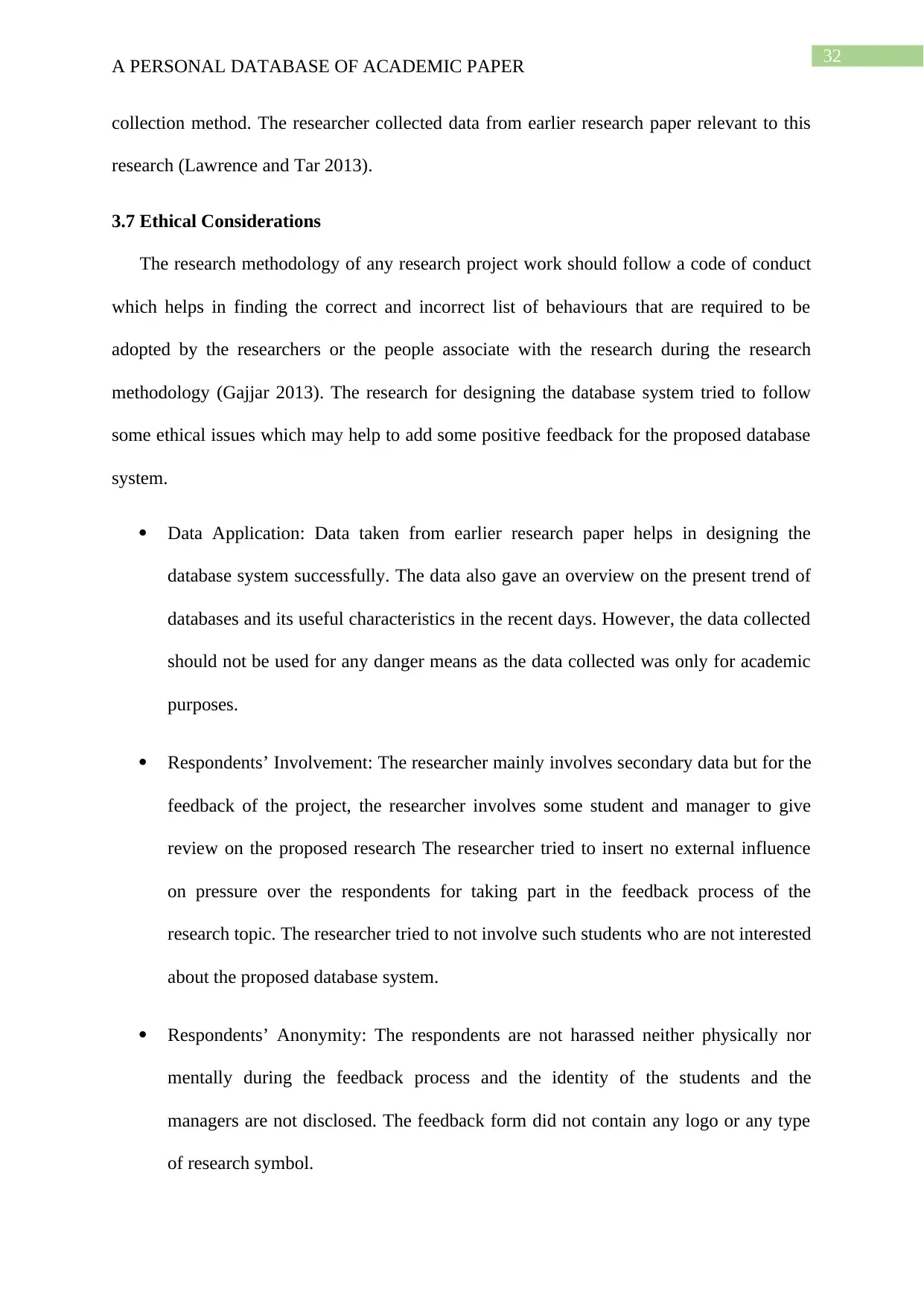
32
A PERSONAL DATABASE OF ACADEMIC PAPER
collection method. The researcher collected data from earlier research paper relevant to this
research (Lawrence and Tar 2013).
3.7 Ethical Considerations
The research methodology of any research project work should follow a code of conduct
which helps in finding the correct and incorrect list of behaviours that are required to be
adopted by the researchers or the people associate with the research during the research
methodology (Gajjar 2013). The research for designing the database system tried to follow
some ethical issues which may help to add some positive feedback for the proposed database
system.
Data Application: Data taken from earlier research paper helps in designing the
database system successfully. The data also gave an overview on the present trend of
databases and its useful characteristics in the recent days. However, the data collected
should not be used for any danger means as the data collected was only for academic
purposes.
Respondents’ Involvement: The researcher mainly involves secondary data but for the
feedback of the project, the researcher involves some student and manager to give
review on the proposed research The researcher tried to insert no external influence
on pressure over the respondents for taking part in the feedback process of the
research topic. The researcher tried to not involve such students who are not interested
about the proposed database system.
Respondents’ Anonymity: The respondents are not harassed neither physically nor
mentally during the feedback process and the identity of the students and the
managers are not disclosed. The feedback form did not contain any logo or any type
of research symbol.
A PERSONAL DATABASE OF ACADEMIC PAPER
collection method. The researcher collected data from earlier research paper relevant to this
research (Lawrence and Tar 2013).
3.7 Ethical Considerations
The research methodology of any research project work should follow a code of conduct
which helps in finding the correct and incorrect list of behaviours that are required to be
adopted by the researchers or the people associate with the research during the research
methodology (Gajjar 2013). The research for designing the database system tried to follow
some ethical issues which may help to add some positive feedback for the proposed database
system.
Data Application: Data taken from earlier research paper helps in designing the
database system successfully. The data also gave an overview on the present trend of
databases and its useful characteristics in the recent days. However, the data collected
should not be used for any danger means as the data collected was only for academic
purposes.
Respondents’ Involvement: The researcher mainly involves secondary data but for the
feedback of the project, the researcher involves some student and manager to give
review on the proposed research The researcher tried to insert no external influence
on pressure over the respondents for taking part in the feedback process of the
research topic. The researcher tried to not involve such students who are not interested
about the proposed database system.
Respondents’ Anonymity: The respondents are not harassed neither physically nor
mentally during the feedback process and the identity of the students and the
managers are not disclosed. The feedback form did not contain any logo or any type
of research symbol.
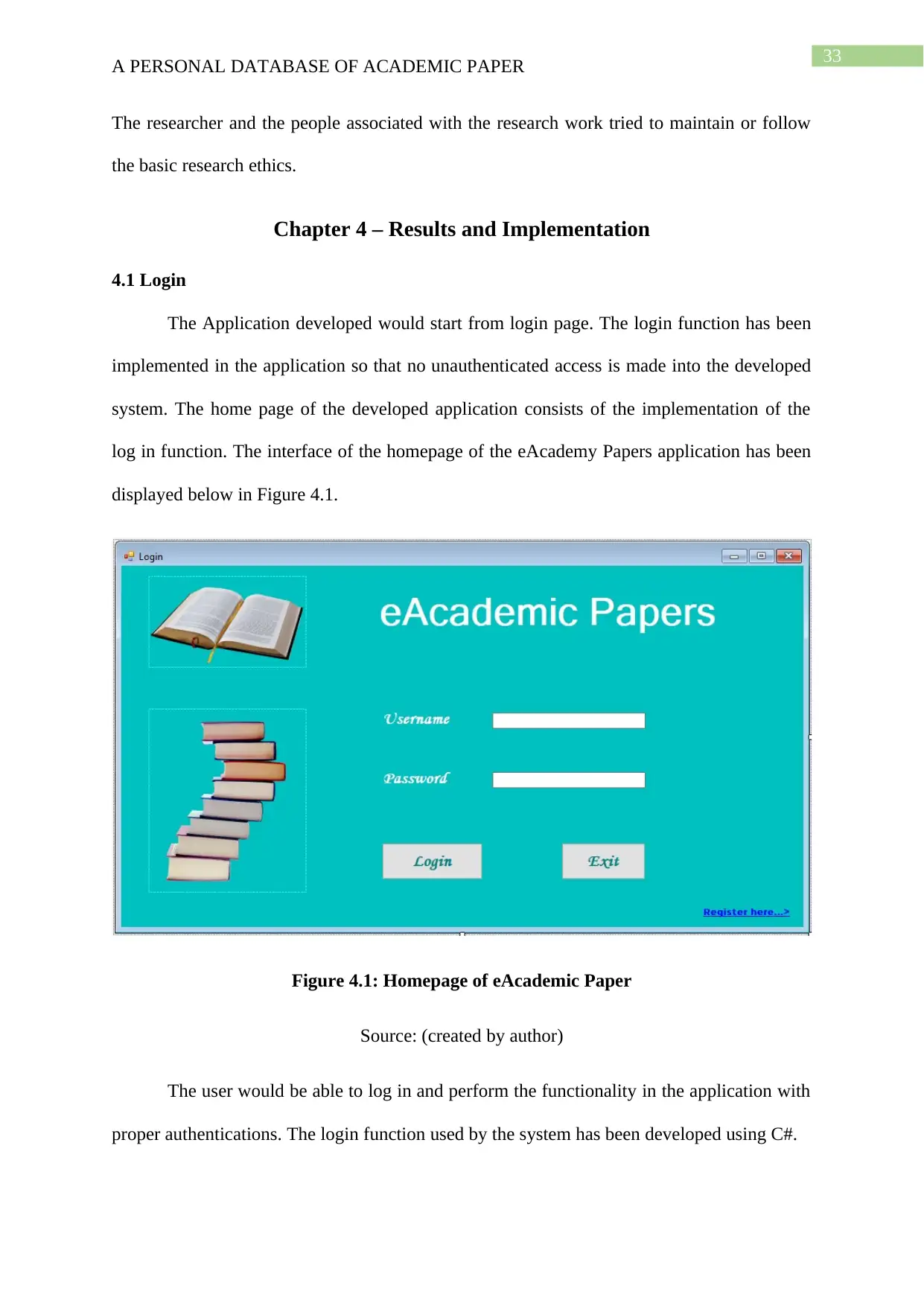
33
A PERSONAL DATABASE OF ACADEMIC PAPER
The researcher and the people associated with the research work tried to maintain or follow
the basic research ethics.
Chapter 4 – Results and Implementation
4.1 Login
The Application developed would start from login page. The login function has been
implemented in the application so that no unauthenticated access is made into the developed
system. The home page of the developed application consists of the implementation of the
log in function. The interface of the homepage of the eAcademy Papers application has been
displayed below in Figure 4.1.
Figure 4.1: Homepage of eAcademic Paper
Source: (created by author)
The user would be able to log in and perform the functionality in the application with
proper authentications. The login function used by the system has been developed using C#.
A PERSONAL DATABASE OF ACADEMIC PAPER
The researcher and the people associated with the research work tried to maintain or follow
the basic research ethics.
Chapter 4 – Results and Implementation
4.1 Login
The Application developed would start from login page. The login function has been
implemented in the application so that no unauthenticated access is made into the developed
system. The home page of the developed application consists of the implementation of the
log in function. The interface of the homepage of the eAcademy Papers application has been
displayed below in Figure 4.1.
Figure 4.1: Homepage of eAcademic Paper
Source: (created by author)
The user would be able to log in and perform the functionality in the application with
proper authentications. The login function used by the system has been developed using C#.
Secure Best Marks with AI Grader
Need help grading? Try our AI Grader for instant feedback on your assignments.
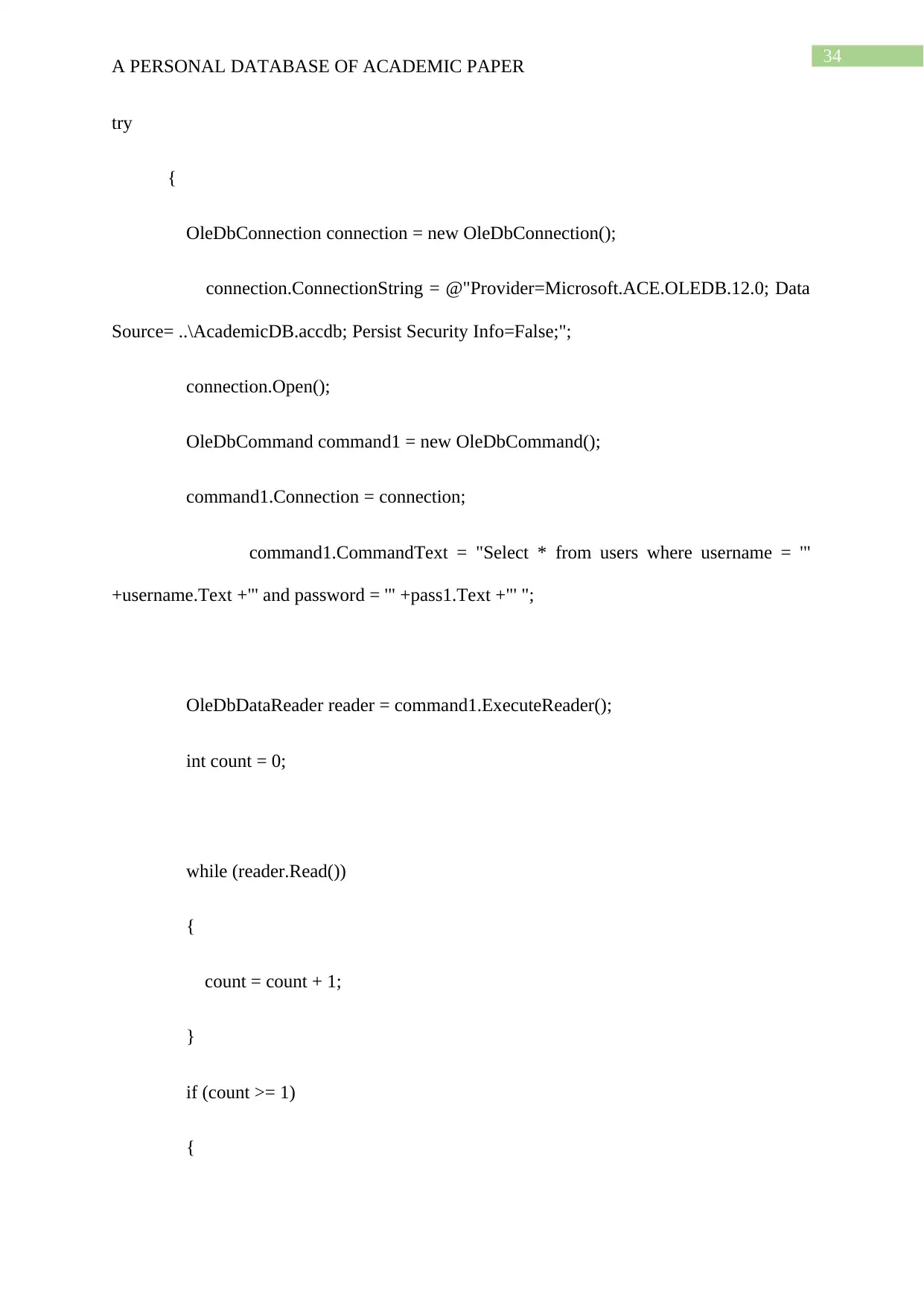
34
A PERSONAL DATABASE OF ACADEMIC PAPER
try
{
OleDbConnection connection = new OleDbConnection();
connection.ConnectionString = @"Provider=Microsoft.ACE.OLEDB.12.0; Data
Source= ..\AcademicDB.accdb; Persist Security Info=False;";
connection.Open();
OleDbCommand command1 = new OleDbCommand();
command1.Connection = connection;
command1.CommandText = "Select * from users where username = '"
+username.Text +"' and password = '" +pass1.Text +"' ";
OleDbDataReader reader = command1.ExecuteReader();
int count = 0;
while (reader.Read())
{
count = count + 1;
}
if (count >= 1)
{
A PERSONAL DATABASE OF ACADEMIC PAPER
try
{
OleDbConnection connection = new OleDbConnection();
connection.ConnectionString = @"Provider=Microsoft.ACE.OLEDB.12.0; Data
Source= ..\AcademicDB.accdb; Persist Security Info=False;";
connection.Open();
OleDbCommand command1 = new OleDbCommand();
command1.Connection = connection;
command1.CommandText = "Select * from users where username = '"
+username.Text +"' and password = '" +pass1.Text +"' ";
OleDbDataReader reader = command1.ExecuteReader();
int count = 0;
while (reader.Read())
{
count = count + 1;
}
if (count >= 1)
{

35
A PERSONAL DATABASE OF ACADEMIC PAPER
this.Hide();
MessageBox.Show("Welcome to the Inventory");
Menu m = new Menu();
m.Show();
}
else
{
MessageBox.Show("Incorrect Password");
}
connection.Close();
}
catch (Exception ex)
{
MessageBox.Show("Error" + ex);
}
The code block described above is used for the development of the login functions in
the application. The try block would be trying to log the user in to the system. The try block
further makes use of the if and else blocks. After the button is clicked the compiler enters in
to the try block and establishes the connection. If the connection is not established then the
complier enters into the catch block and the catch block displays the error message. After the
A PERSONAL DATABASE OF ACADEMIC PAPER
this.Hide();
MessageBox.Show("Welcome to the Inventory");
Menu m = new Menu();
m.Show();
}
else
{
MessageBox.Show("Incorrect Password");
}
connection.Close();
}
catch (Exception ex)
{
MessageBox.Show("Error" + ex);
}
The code block described above is used for the development of the login functions in
the application. The try block would be trying to log the user in to the system. The try block
further makes use of the if and else blocks. After the button is clicked the compiler enters in
to the try block and establishes the connection. If the connection is not established then the
complier enters into the catch block and the catch block displays the error message. After the
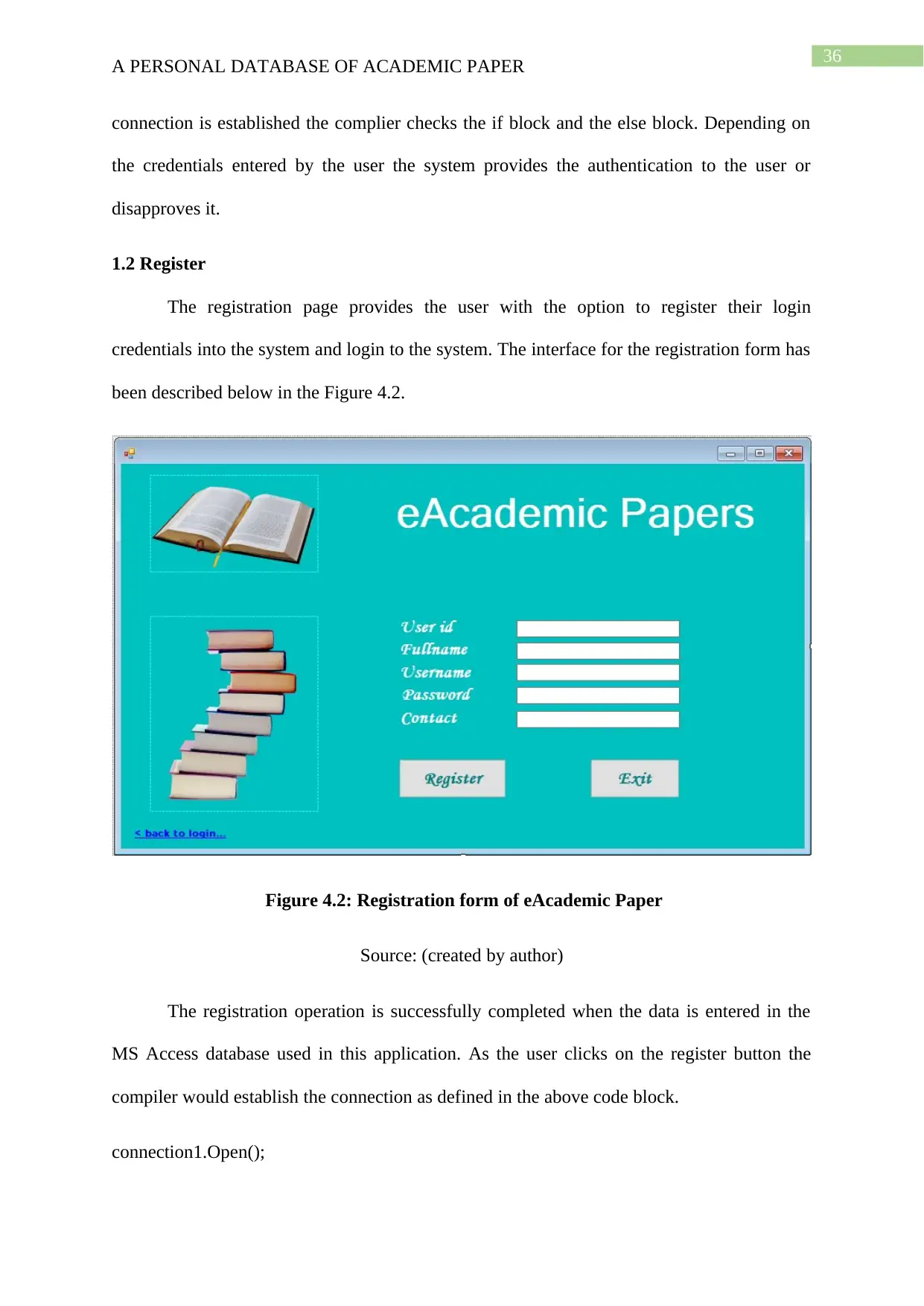
36
A PERSONAL DATABASE OF ACADEMIC PAPER
connection is established the complier checks the if block and the else block. Depending on
the credentials entered by the user the system provides the authentication to the user or
disapproves it.
1.2 Register
The registration page provides the user with the option to register their login
credentials into the system and login to the system. The interface for the registration form has
been described below in the Figure 4.2.
Figure 4.2: Registration form of eAcademic Paper
Source: (created by author)
The registration operation is successfully completed when the data is entered in the
MS Access database used in this application. As the user clicks on the register button the
compiler would establish the connection as defined in the above code block.
connection1.Open();
A PERSONAL DATABASE OF ACADEMIC PAPER
connection is established the complier checks the if block and the else block. Depending on
the credentials entered by the user the system provides the authentication to the user or
disapproves it.
1.2 Register
The registration page provides the user with the option to register their login
credentials into the system and login to the system. The interface for the registration form has
been described below in the Figure 4.2.
Figure 4.2: Registration form of eAcademic Paper
Source: (created by author)
The registration operation is successfully completed when the data is entered in the
MS Access database used in this application. As the user clicks on the register button the
compiler would establish the connection as defined in the above code block.
connection1.Open();
Paraphrase This Document
Need a fresh take? Get an instant paraphrase of this document with our AI Paraphraser
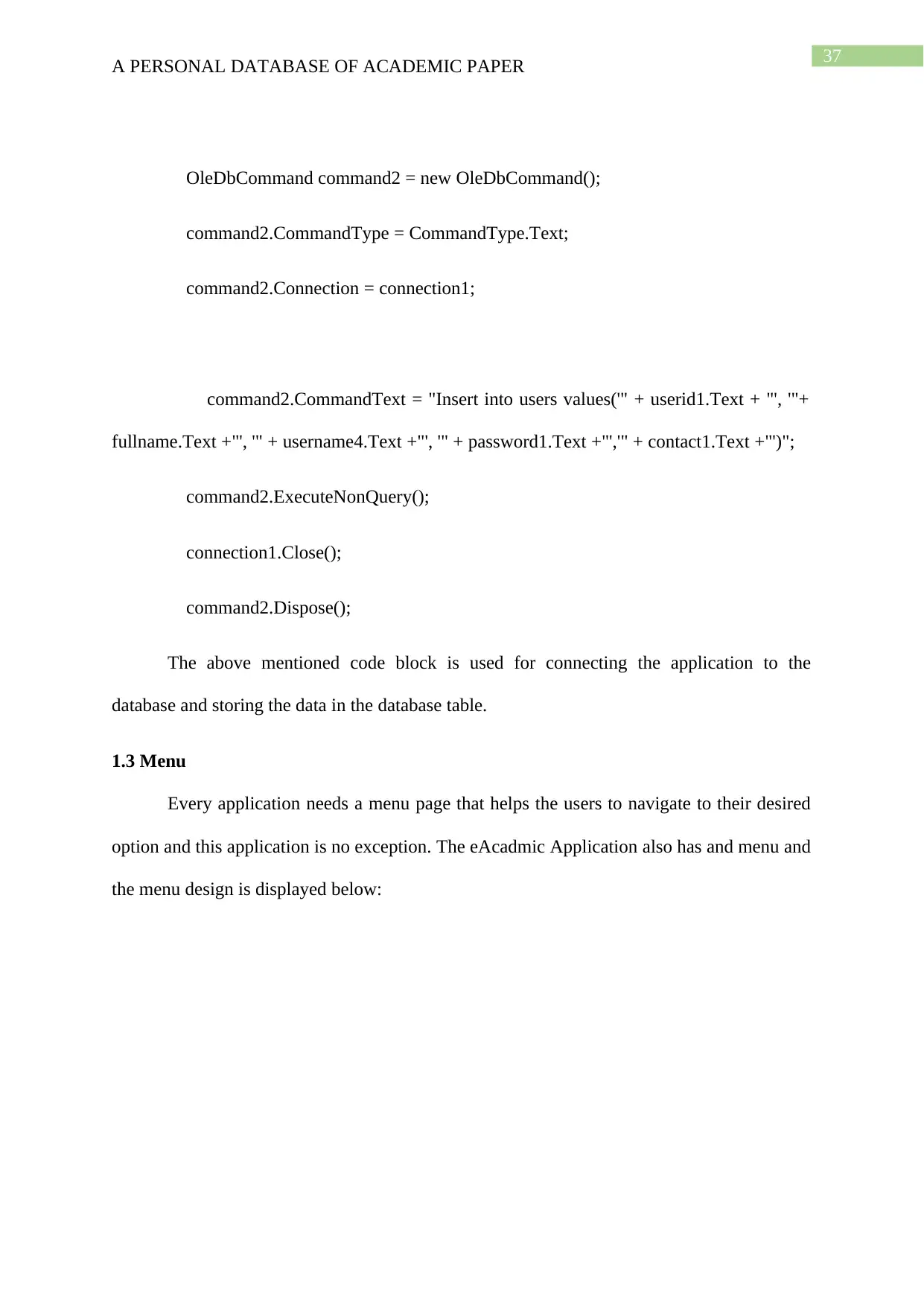
37
A PERSONAL DATABASE OF ACADEMIC PAPER
OleDbCommand command2 = new OleDbCommand();
command2.CommandType = CommandType.Text;
command2.Connection = connection1;
command2.CommandText = "Insert into users values('" + userid1.Text + "', '"+
fullname.Text +"', '" + username4.Text +"', '" + password1.Text +"','" + contact1.Text +"')";
command2.ExecuteNonQuery();
connection1.Close();
command2.Dispose();
The above mentioned code block is used for connecting the application to the
database and storing the data in the database table.
1.3 Menu
Every application needs a menu page that helps the users to navigate to their desired
option and this application is no exception. The eAcadmic Application also has and menu and
the menu design is displayed below:
A PERSONAL DATABASE OF ACADEMIC PAPER
OleDbCommand command2 = new OleDbCommand();
command2.CommandType = CommandType.Text;
command2.Connection = connection1;
command2.CommandText = "Insert into users values('" + userid1.Text + "', '"+
fullname.Text +"', '" + username4.Text +"', '" + password1.Text +"','" + contact1.Text +"')";
command2.ExecuteNonQuery();
connection1.Close();
command2.Dispose();
The above mentioned code block is used for connecting the application to the
database and storing the data in the database table.
1.3 Menu
Every application needs a menu page that helps the users to navigate to their desired
option and this application is no exception. The eAcadmic Application also has and menu and
the menu design is displayed below:
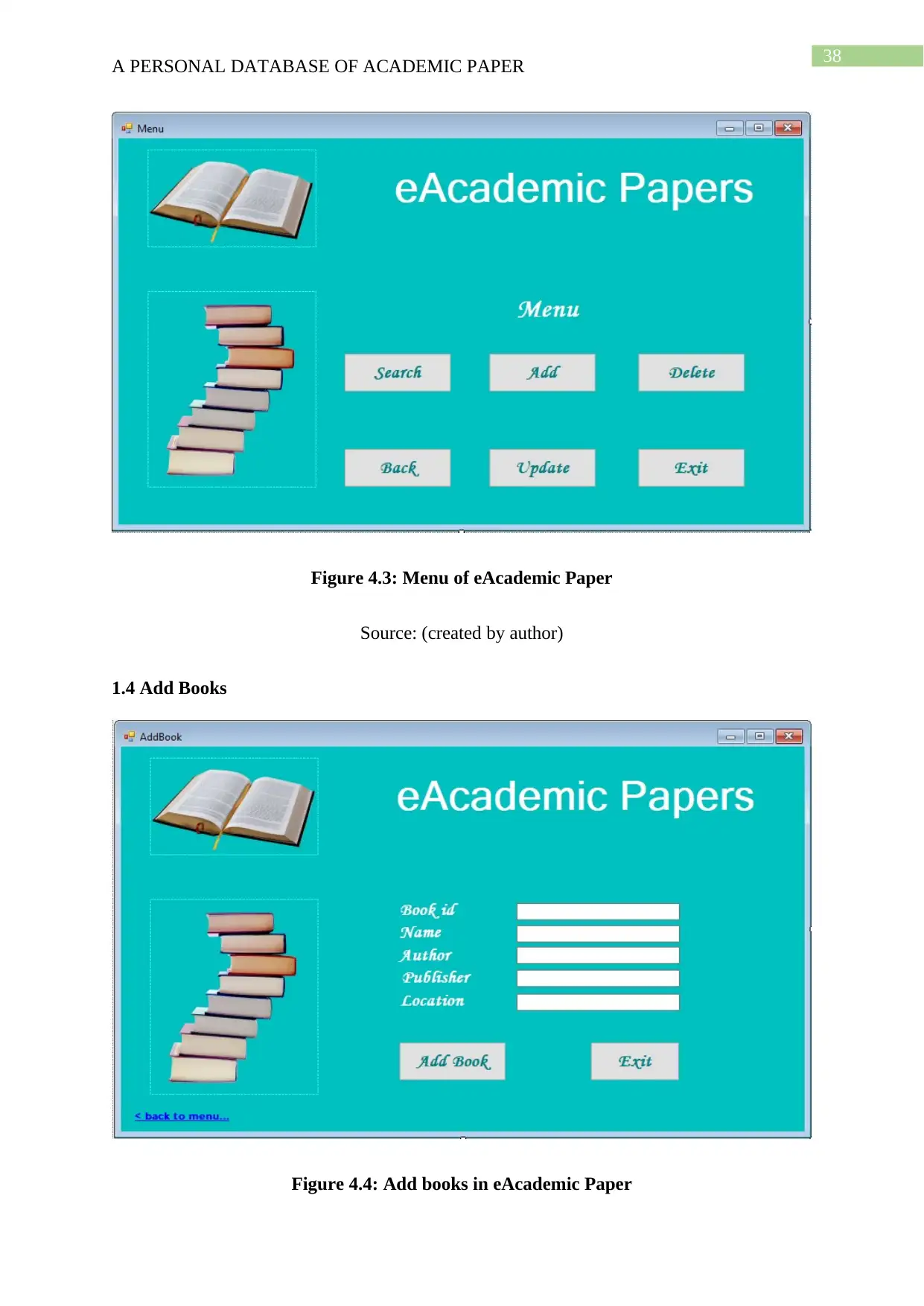
38
A PERSONAL DATABASE OF ACADEMIC PAPER
Figure 4.3: Menu of eAcademic Paper
Source: (created by author)
1.4 Add Books
Figure 4.4: Add books in eAcademic Paper
A PERSONAL DATABASE OF ACADEMIC PAPER
Figure 4.3: Menu of eAcademic Paper
Source: (created by author)
1.4 Add Books
Figure 4.4: Add books in eAcademic Paper
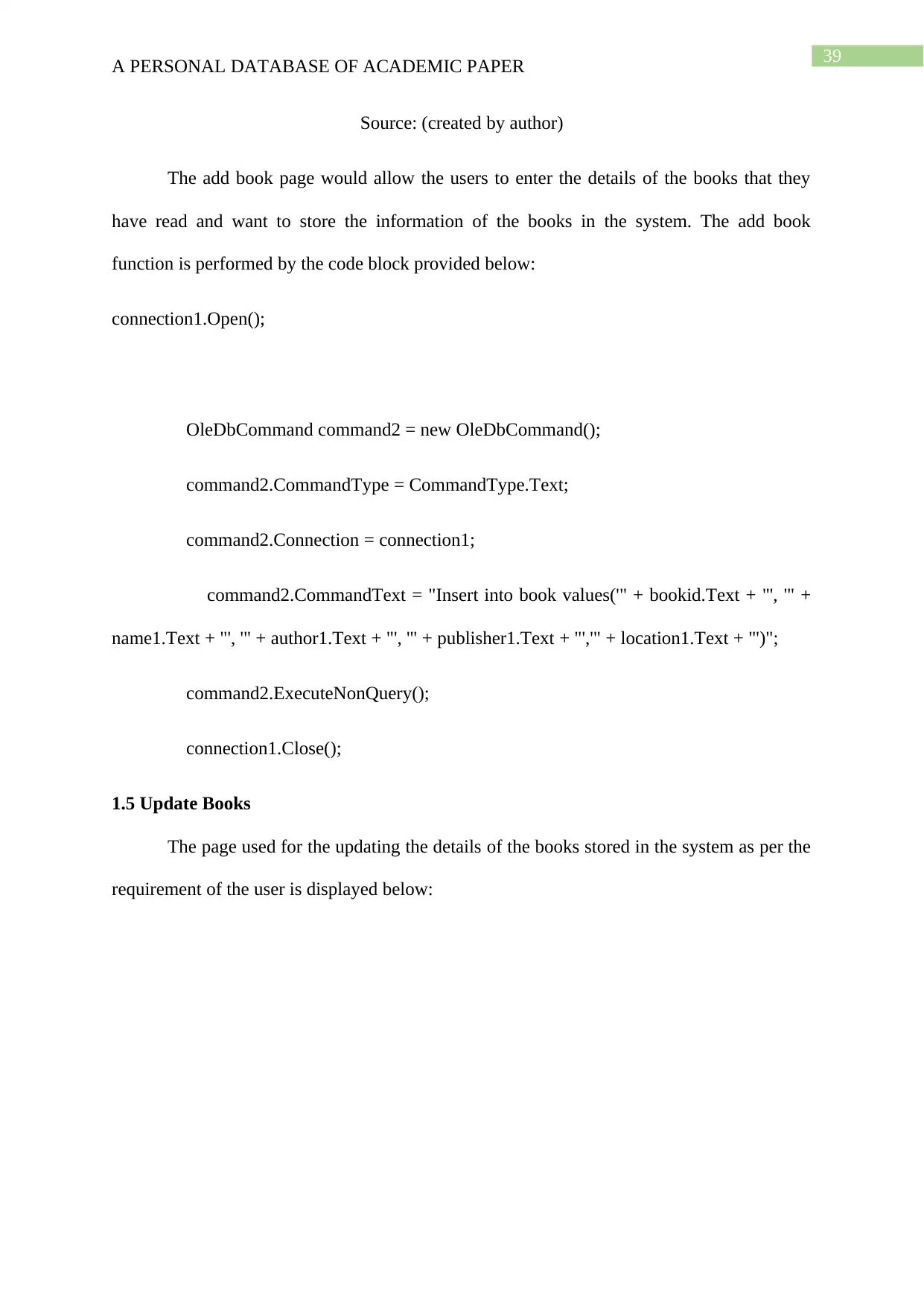
39
A PERSONAL DATABASE OF ACADEMIC PAPER
Source: (created by author)
The add book page would allow the users to enter the details of the books that they
have read and want to store the information of the books in the system. The add book
function is performed by the code block provided below:
connection1.Open();
OleDbCommand command2 = new OleDbCommand();
command2.CommandType = CommandType.Text;
command2.Connection = connection1;
command2.CommandText = "Insert into book values('" + bookid.Text + "', '" +
name1.Text + "', '" + author1.Text + "', '" + publisher1.Text + "','" + location1.Text + "')";
command2.ExecuteNonQuery();
connection1.Close();
1.5 Update Books
The page used for the updating the details of the books stored in the system as per the
requirement of the user is displayed below:
A PERSONAL DATABASE OF ACADEMIC PAPER
Source: (created by author)
The add book page would allow the users to enter the details of the books that they
have read and want to store the information of the books in the system. The add book
function is performed by the code block provided below:
connection1.Open();
OleDbCommand command2 = new OleDbCommand();
command2.CommandType = CommandType.Text;
command2.Connection = connection1;
command2.CommandText = "Insert into book values('" + bookid.Text + "', '" +
name1.Text + "', '" + author1.Text + "', '" + publisher1.Text + "','" + location1.Text + "')";
command2.ExecuteNonQuery();
connection1.Close();
1.5 Update Books
The page used for the updating the details of the books stored in the system as per the
requirement of the user is displayed below:
Secure Best Marks with AI Grader
Need help grading? Try our AI Grader for instant feedback on your assignments.
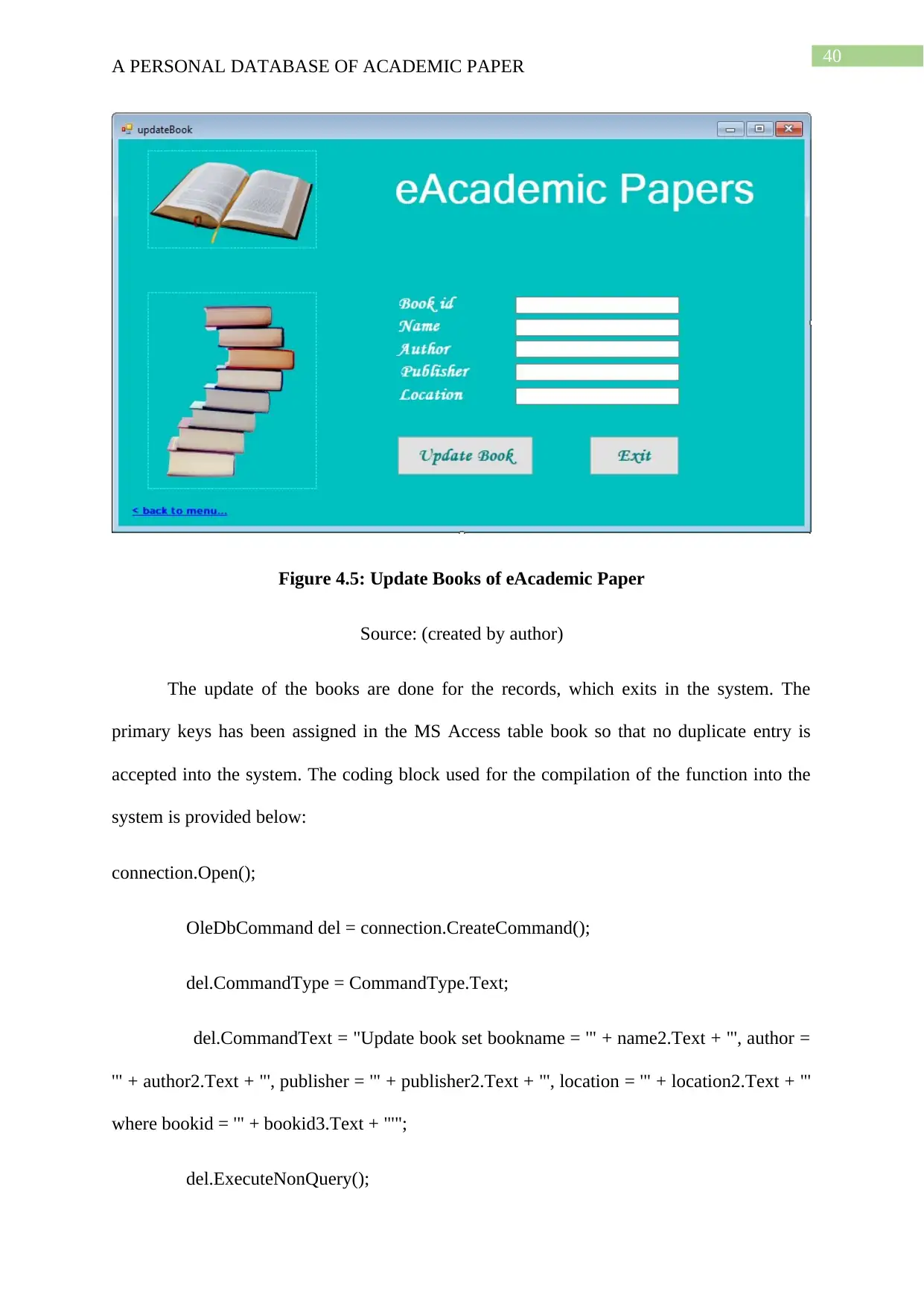
40
A PERSONAL DATABASE OF ACADEMIC PAPER
Figure 4.5: Update Books of eAcademic Paper
Source: (created by author)
The update of the books are done for the records, which exits in the system. The
primary keys has been assigned in the MS Access table book so that no duplicate entry is
accepted into the system. The coding block used for the compilation of the function into the
system is provided below:
connection.Open();
OleDbCommand del = connection.CreateCommand();
del.CommandType = CommandType.Text;
del.CommandText = "Update book set bookname = '" + name2.Text + "', author =
'" + author2.Text + "', publisher = '" + publisher2.Text + "', location = '" + location2.Text + "'
where bookid = '" + bookid3.Text + "'";
del.ExecuteNonQuery();
A PERSONAL DATABASE OF ACADEMIC PAPER
Figure 4.5: Update Books of eAcademic Paper
Source: (created by author)
The update of the books are done for the records, which exits in the system. The
primary keys has been assigned in the MS Access table book so that no duplicate entry is
accepted into the system. The coding block used for the compilation of the function into the
system is provided below:
connection.Open();
OleDbCommand del = connection.CreateCommand();
del.CommandType = CommandType.Text;
del.CommandText = "Update book set bookname = '" + name2.Text + "', author =
'" + author2.Text + "', publisher = '" + publisher2.Text + "', location = '" + location2.Text + "'
where bookid = '" + bookid3.Text + "'";
del.ExecuteNonQuery();
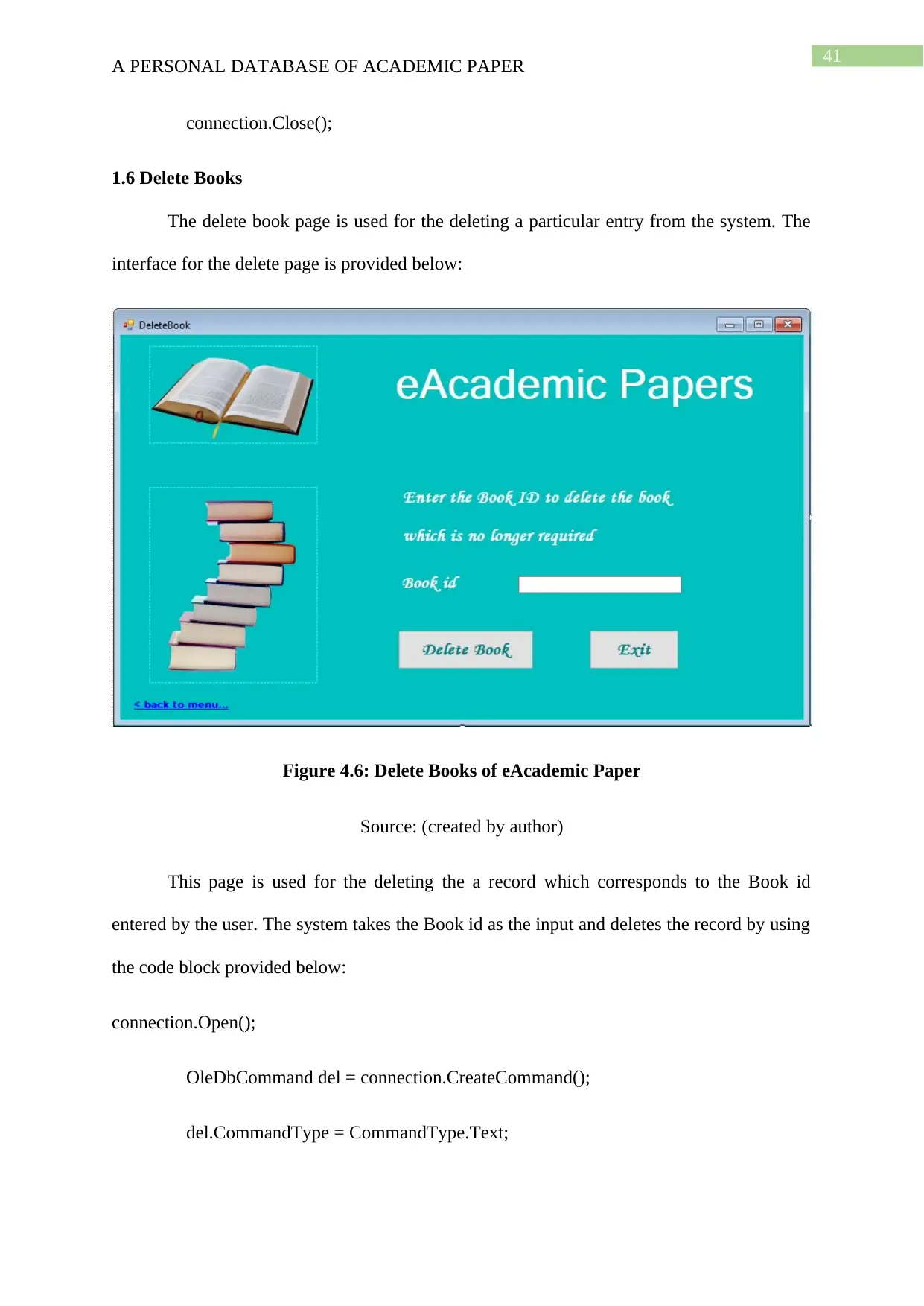
41
A PERSONAL DATABASE OF ACADEMIC PAPER
connection.Close();
1.6 Delete Books
The delete book page is used for the deleting a particular entry from the system. The
interface for the delete page is provided below:
Figure 4.6: Delete Books of eAcademic Paper
Source: (created by author)
This page is used for the deleting the a record which corresponds to the Book id
entered by the user. The system takes the Book id as the input and deletes the record by using
the code block provided below:
connection.Open();
OleDbCommand del = connection.CreateCommand();
del.CommandType = CommandType.Text;
A PERSONAL DATABASE OF ACADEMIC PAPER
connection.Close();
1.6 Delete Books
The delete book page is used for the deleting a particular entry from the system. The
interface for the delete page is provided below:
Figure 4.6: Delete Books of eAcademic Paper
Source: (created by author)
This page is used for the deleting the a record which corresponds to the Book id
entered by the user. The system takes the Book id as the input and deletes the record by using
the code block provided below:
connection.Open();
OleDbCommand del = connection.CreateCommand();
del.CommandType = CommandType.Text;
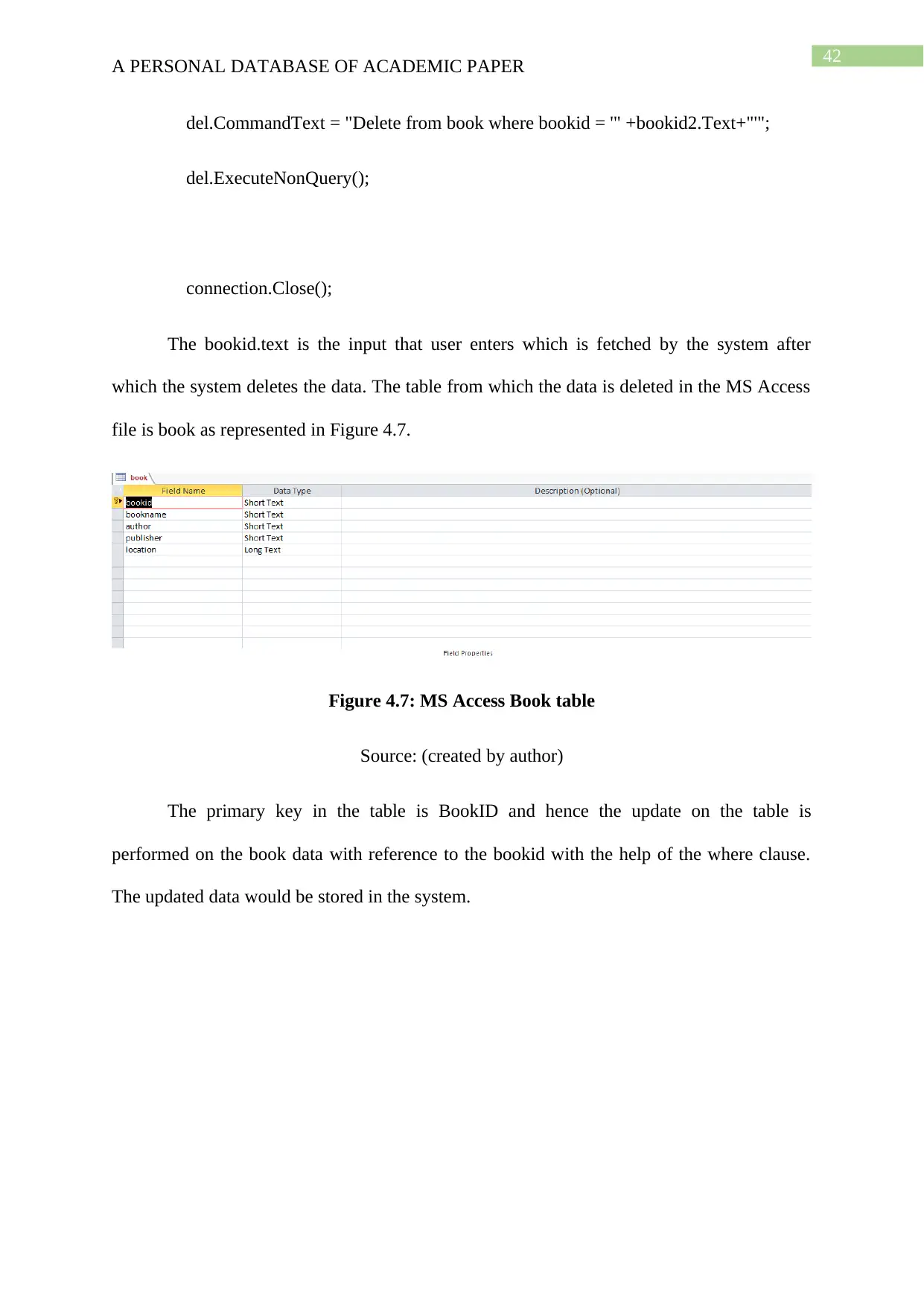
42
A PERSONAL DATABASE OF ACADEMIC PAPER
del.CommandText = "Delete from book where bookid = '" +bookid2.Text+"'";
del.ExecuteNonQuery();
connection.Close();
The bookid.text is the input that user enters which is fetched by the system after
which the system deletes the data. The table from which the data is deleted in the MS Access
file is book as represented in Figure 4.7.
Figure 4.7: MS Access Book table
Source: (created by author)
The primary key in the table is BookID and hence the update on the table is
performed on the book data with reference to the bookid with the help of the where clause.
The updated data would be stored in the system.
A PERSONAL DATABASE OF ACADEMIC PAPER
del.CommandText = "Delete from book where bookid = '" +bookid2.Text+"'";
del.ExecuteNonQuery();
connection.Close();
The bookid.text is the input that user enters which is fetched by the system after
which the system deletes the data. The table from which the data is deleted in the MS Access
file is book as represented in Figure 4.7.
Figure 4.7: MS Access Book table
Source: (created by author)
The primary key in the table is BookID and hence the update on the table is
performed on the book data with reference to the bookid with the help of the where clause.
The updated data would be stored in the system.
Paraphrase This Document
Need a fresh take? Get an instant paraphrase of this document with our AI Paraphraser
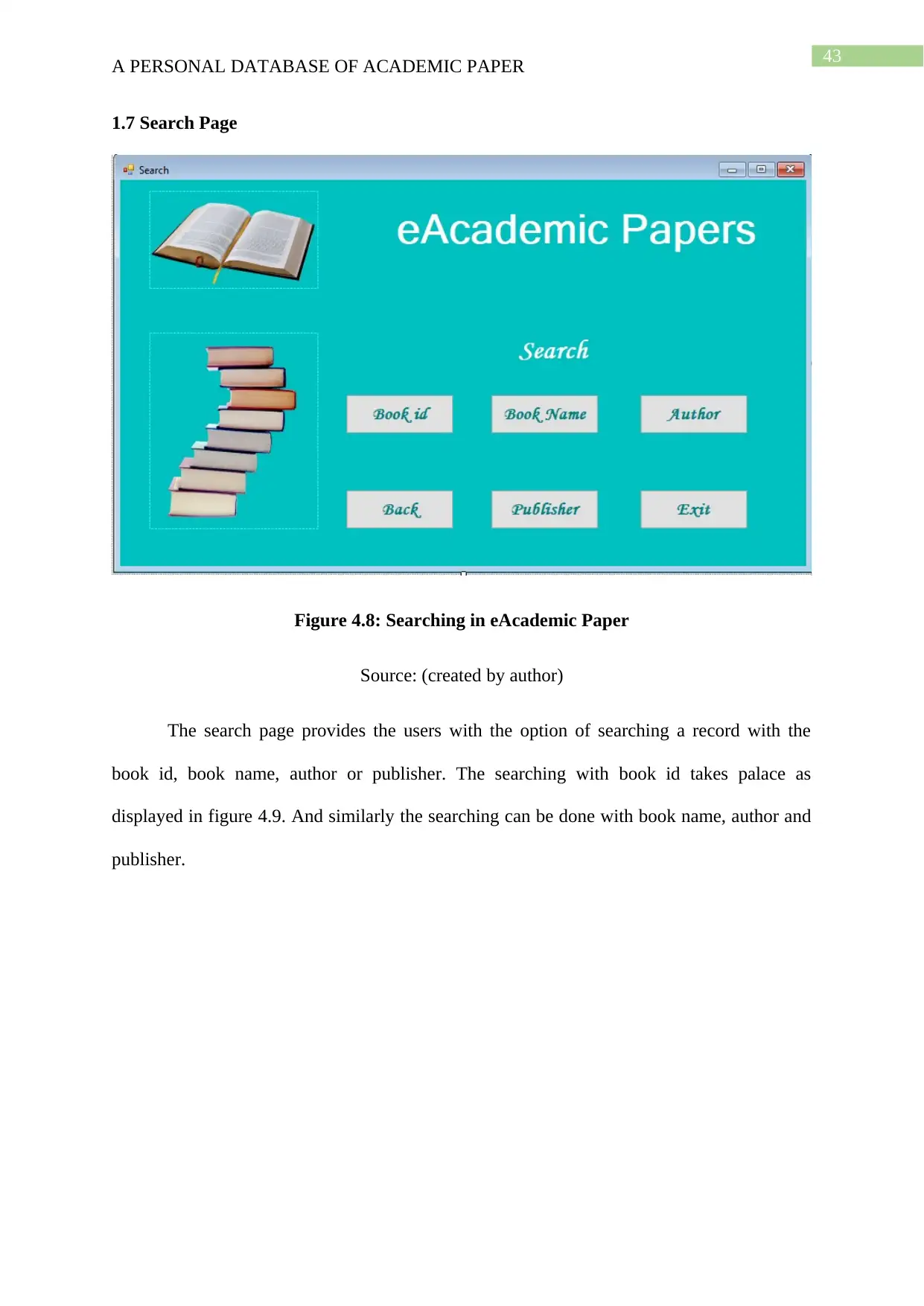
43
A PERSONAL DATABASE OF ACADEMIC PAPER
1.7 Search Page
Figure 4.8: Searching in eAcademic Paper
Source: (created by author)
The search page provides the users with the option of searching a record with the
book id, book name, author or publisher. The searching with book id takes palace as
displayed in figure 4.9. And similarly the searching can be done with book name, author and
publisher.
A PERSONAL DATABASE OF ACADEMIC PAPER
1.7 Search Page
Figure 4.8: Searching in eAcademic Paper
Source: (created by author)
The search page provides the users with the option of searching a record with the
book id, book name, author or publisher. The searching with book id takes palace as
displayed in figure 4.9. And similarly the searching can be done with book name, author and
publisher.
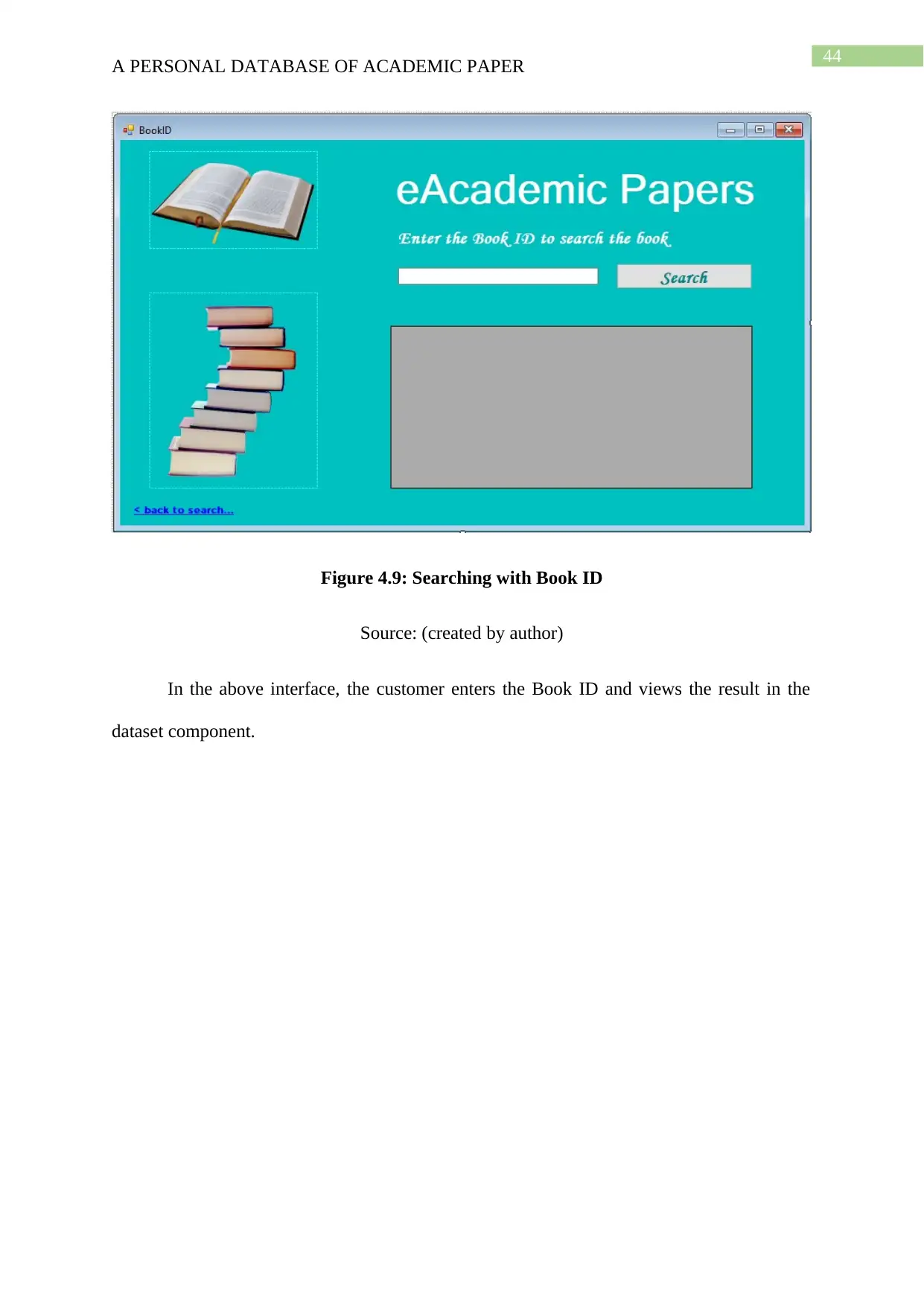
44
A PERSONAL DATABASE OF ACADEMIC PAPER
Figure 4.9: Searching with Book ID
Source: (created by author)
In the above interface, the customer enters the Book ID and views the result in the
dataset component.
A PERSONAL DATABASE OF ACADEMIC PAPER
Figure 4.9: Searching with Book ID
Source: (created by author)
In the above interface, the customer enters the Book ID and views the result in the
dataset component.

45
A PERSONAL DATABASE OF ACADEMIC PAPER
Figure 4.10: Searching with Book name
Source: (created by author)
In the above interface, the customer enters the Book Name and views the result in the
dataset component.
A PERSONAL DATABASE OF ACADEMIC PAPER
Figure 4.10: Searching with Book name
Source: (created by author)
In the above interface, the customer enters the Book Name and views the result in the
dataset component.
Secure Best Marks with AI Grader
Need help grading? Try our AI Grader for instant feedback on your assignments.

46
A PERSONAL DATABASE OF ACADEMIC PAPER
Figure 4.11: Searching with Author
Source: (created by author)
In the above interface, the customer enters the Author Name and views the result in
the dataset component.
A PERSONAL DATABASE OF ACADEMIC PAPER
Figure 4.11: Searching with Author
Source: (created by author)
In the above interface, the customer enters the Author Name and views the result in
the dataset component.
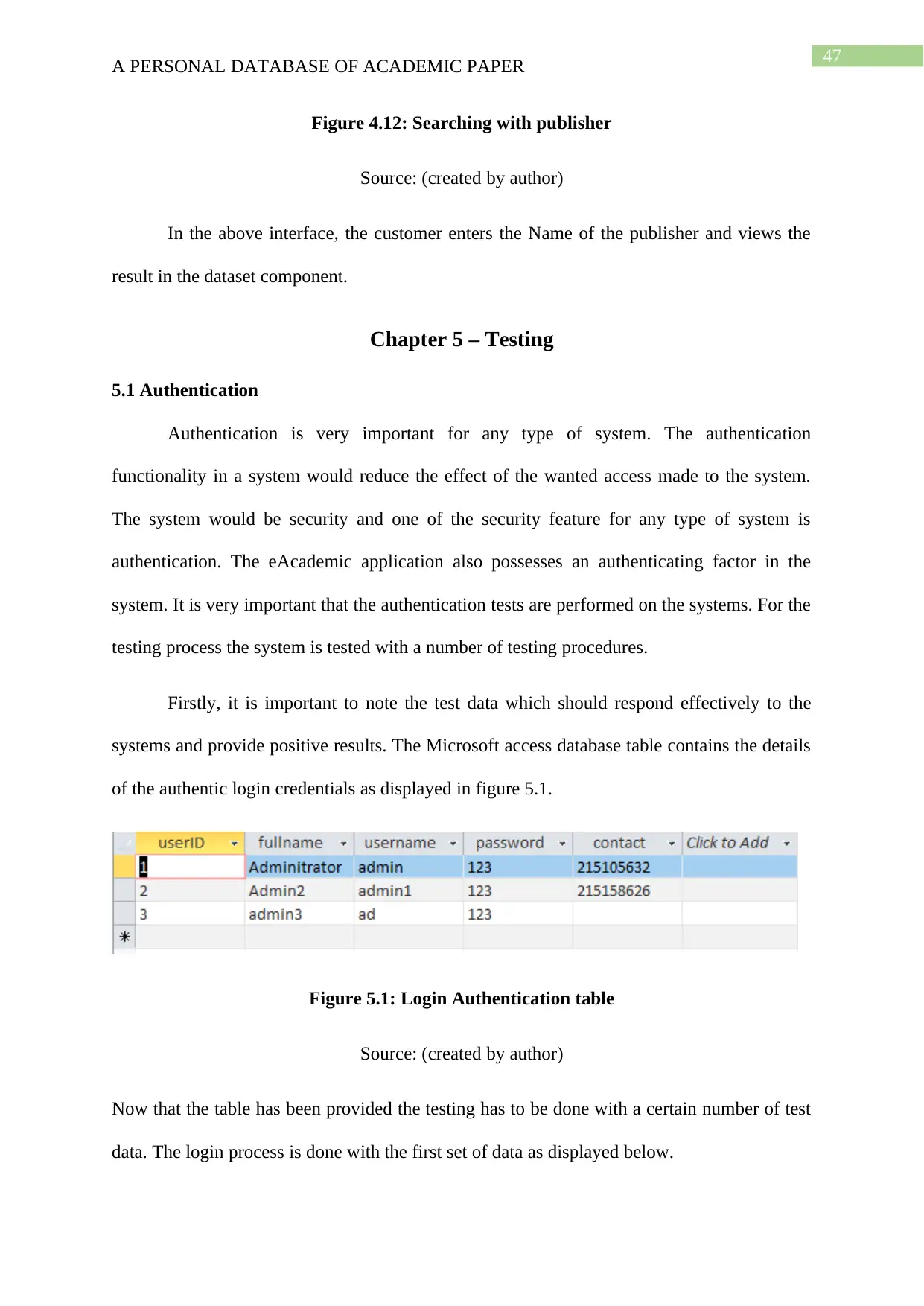
47
A PERSONAL DATABASE OF ACADEMIC PAPER
Figure 4.12: Searching with publisher
Source: (created by author)
In the above interface, the customer enters the Name of the publisher and views the
result in the dataset component.
Chapter 5 – Testing
5.1 Authentication
Authentication is very important for any type of system. The authentication
functionality in a system would reduce the effect of the wanted access made to the system.
The system would be security and one of the security feature for any type of system is
authentication. The eAcademic application also possesses an authenticating factor in the
system. It is very important that the authentication tests are performed on the systems. For the
testing process the system is tested with a number of testing procedures.
Firstly, it is important to note the test data which should respond effectively to the
systems and provide positive results. The Microsoft access database table contains the details
of the authentic login credentials as displayed in figure 5.1.
Figure 5.1: Login Authentication table
Source: (created by author)
Now that the table has been provided the testing has to be done with a certain number of test
data. The login process is done with the first set of data as displayed below.
A PERSONAL DATABASE OF ACADEMIC PAPER
Figure 4.12: Searching with publisher
Source: (created by author)
In the above interface, the customer enters the Name of the publisher and views the
result in the dataset component.
Chapter 5 – Testing
5.1 Authentication
Authentication is very important for any type of system. The authentication
functionality in a system would reduce the effect of the wanted access made to the system.
The system would be security and one of the security feature for any type of system is
authentication. The eAcademic application also possesses an authenticating factor in the
system. It is very important that the authentication tests are performed on the systems. For the
testing process the system is tested with a number of testing procedures.
Firstly, it is important to note the test data which should respond effectively to the
systems and provide positive results. The Microsoft access database table contains the details
of the authentic login credentials as displayed in figure 5.1.
Figure 5.1: Login Authentication table
Source: (created by author)
Now that the table has been provided the testing has to be done with a certain number of test
data. The login process is done with the first set of data as displayed below.
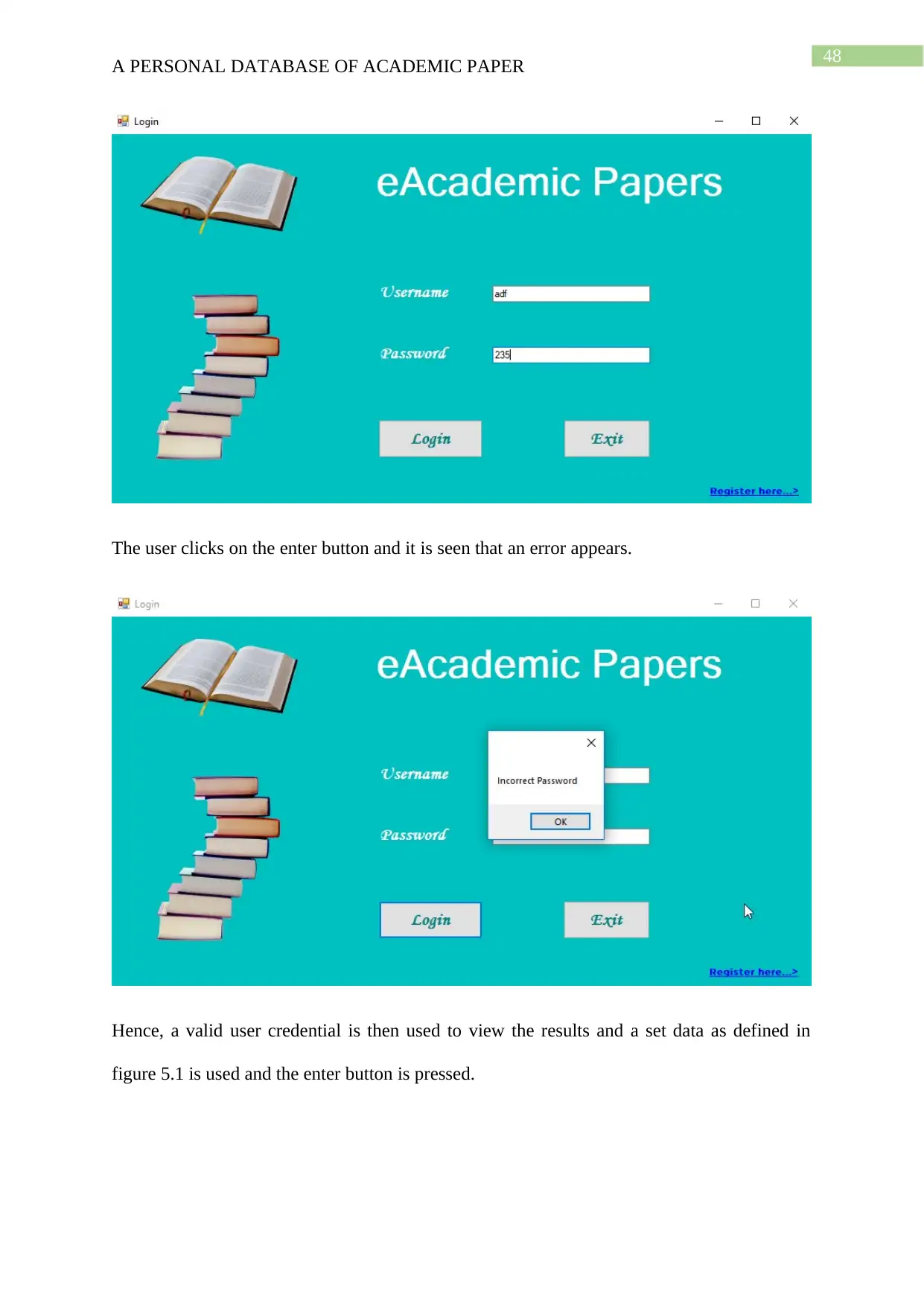
48
A PERSONAL DATABASE OF ACADEMIC PAPER
The user clicks on the enter button and it is seen that an error appears.
Hence, a valid user credential is then used to view the results and a set data as defined in
figure 5.1 is used and the enter button is pressed.
A PERSONAL DATABASE OF ACADEMIC PAPER
The user clicks on the enter button and it is seen that an error appears.
Hence, a valid user credential is then used to view the results and a set data as defined in
figure 5.1 is used and the enter button is pressed.
Paraphrase This Document
Need a fresh take? Get an instant paraphrase of this document with our AI Paraphraser
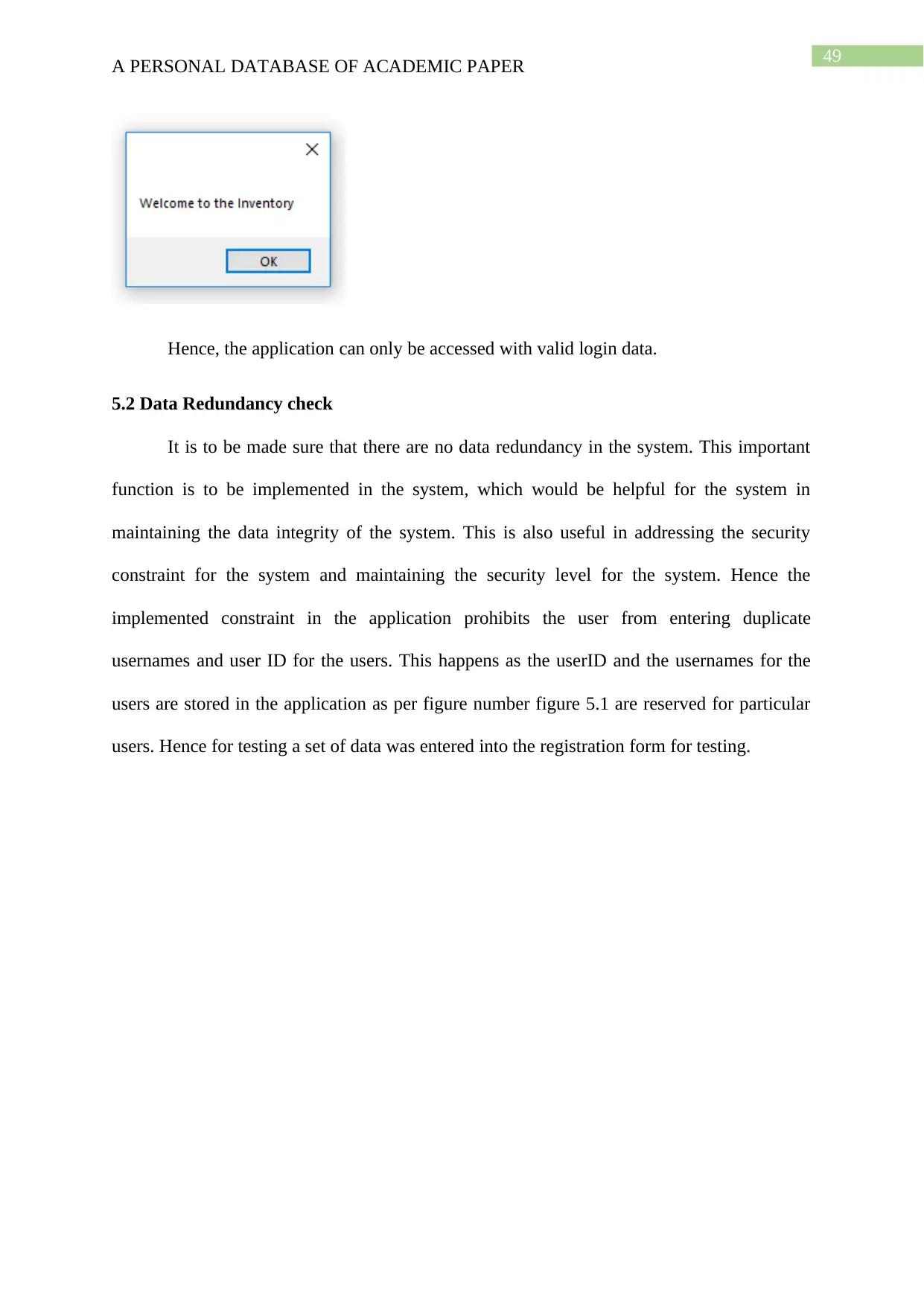
49
A PERSONAL DATABASE OF ACADEMIC PAPER
Hence, the application can only be accessed with valid login data.
5.2 Data Redundancy check
It is to be made sure that there are no data redundancy in the system. This important
function is to be implemented in the system, which would be helpful for the system in
maintaining the data integrity of the system. This is also useful in addressing the security
constraint for the system and maintaining the security level for the system. Hence the
implemented constraint in the application prohibits the user from entering duplicate
usernames and user ID for the users. This happens as the userID and the usernames for the
users are stored in the application as per figure number figure 5.1 are reserved for particular
users. Hence for testing a set of data was entered into the registration form for testing.
A PERSONAL DATABASE OF ACADEMIC PAPER
Hence, the application can only be accessed with valid login data.
5.2 Data Redundancy check
It is to be made sure that there are no data redundancy in the system. This important
function is to be implemented in the system, which would be helpful for the system in
maintaining the data integrity of the system. This is also useful in addressing the security
constraint for the system and maintaining the security level for the system. Hence the
implemented constraint in the application prohibits the user from entering duplicate
usernames and user ID for the users. This happens as the userID and the usernames for the
users are stored in the application as per figure number figure 5.1 are reserved for particular
users. Hence for testing a set of data was entered into the registration form for testing.
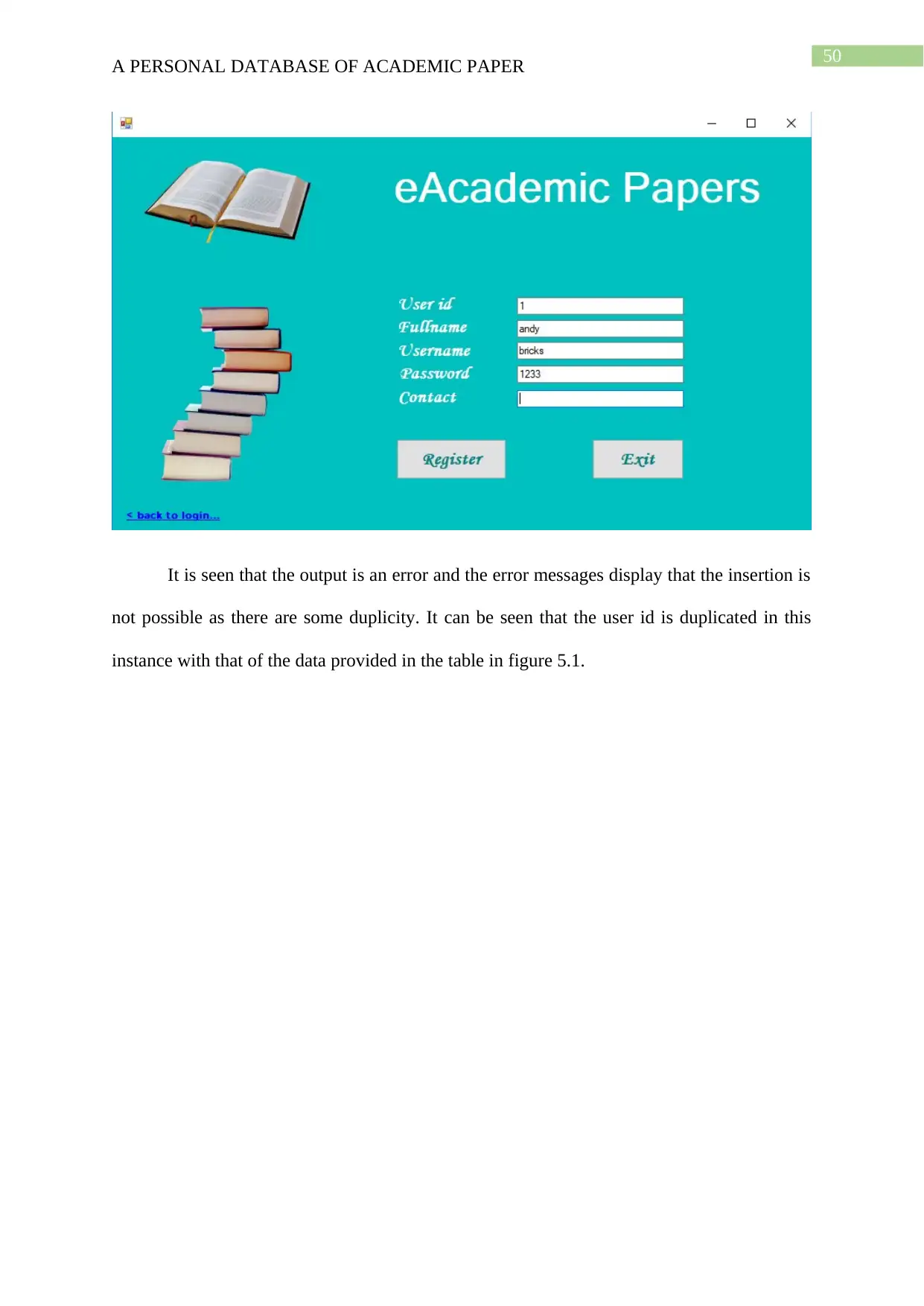
50
A PERSONAL DATABASE OF ACADEMIC PAPER
It is seen that the output is an error and the error messages display that the insertion is
not possible as there are some duplicity. It can be seen that the user id is duplicated in this
instance with that of the data provided in the table in figure 5.1.
A PERSONAL DATABASE OF ACADEMIC PAPER
It is seen that the output is an error and the error messages display that the insertion is
not possible as there are some duplicity. It can be seen that the user id is duplicated in this
instance with that of the data provided in the table in figure 5.1.
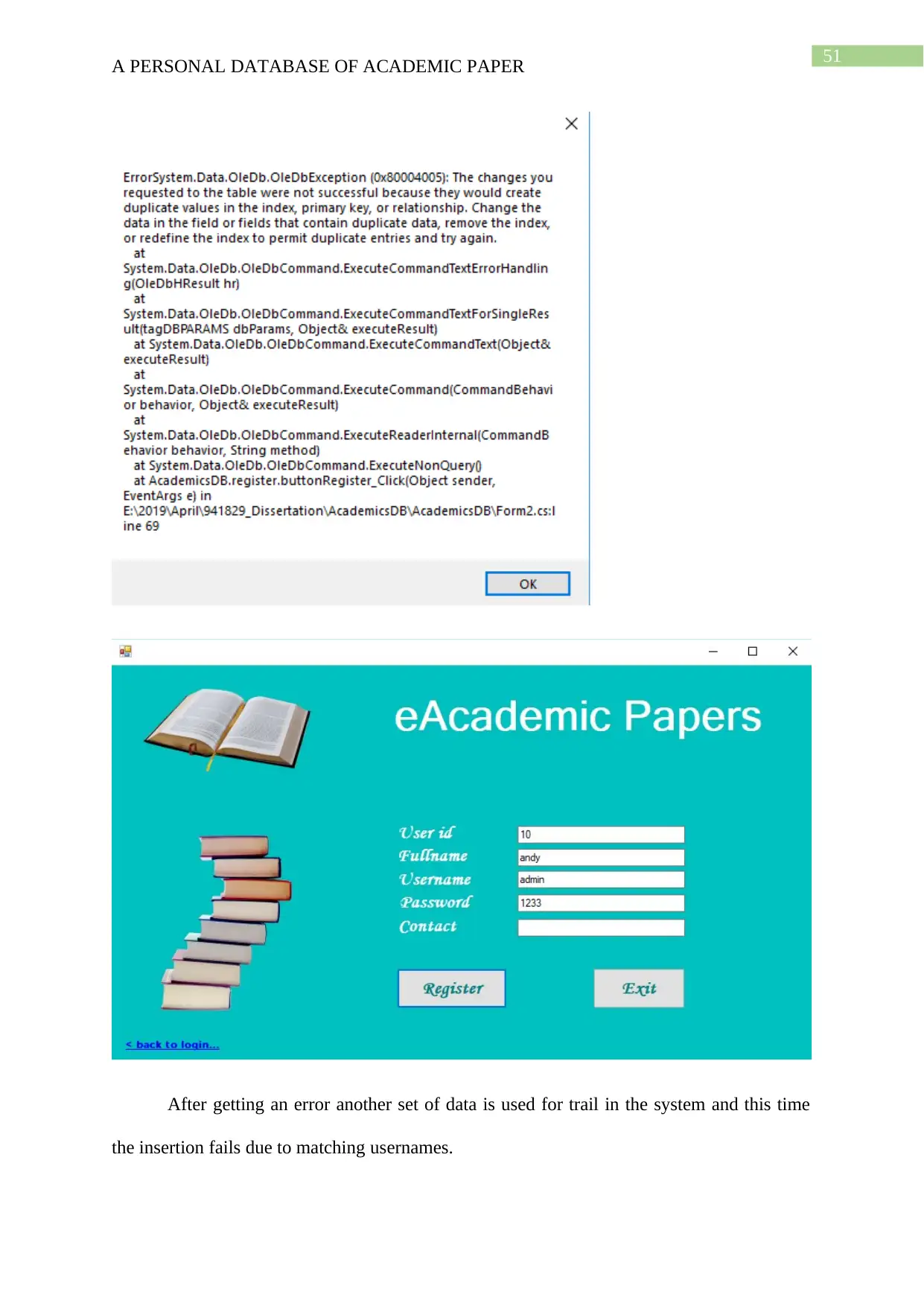
51
A PERSONAL DATABASE OF ACADEMIC PAPER
After getting an error another set of data is used for trail in the system and this time
the insertion fails due to matching usernames.
A PERSONAL DATABASE OF ACADEMIC PAPER
After getting an error another set of data is used for trail in the system and this time
the insertion fails due to matching usernames.
Secure Best Marks with AI Grader
Need help grading? Try our AI Grader for instant feedback on your assignments.
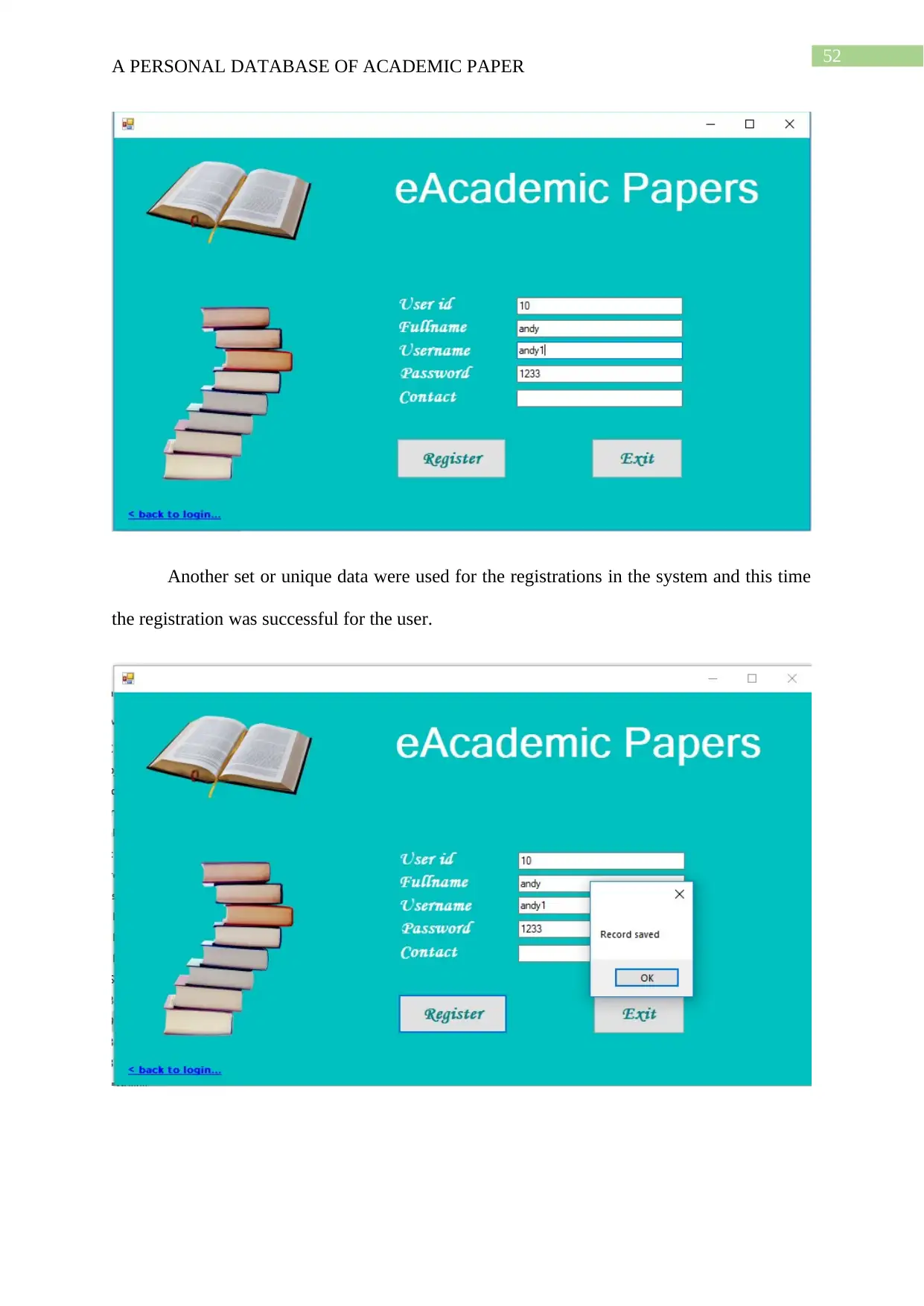
52
A PERSONAL DATABASE OF ACADEMIC PAPER
Another set or unique data were used for the registrations in the system and this time
the registration was successful for the user.
A PERSONAL DATABASE OF ACADEMIC PAPER
Another set or unique data were used for the registrations in the system and this time
the registration was successful for the user.
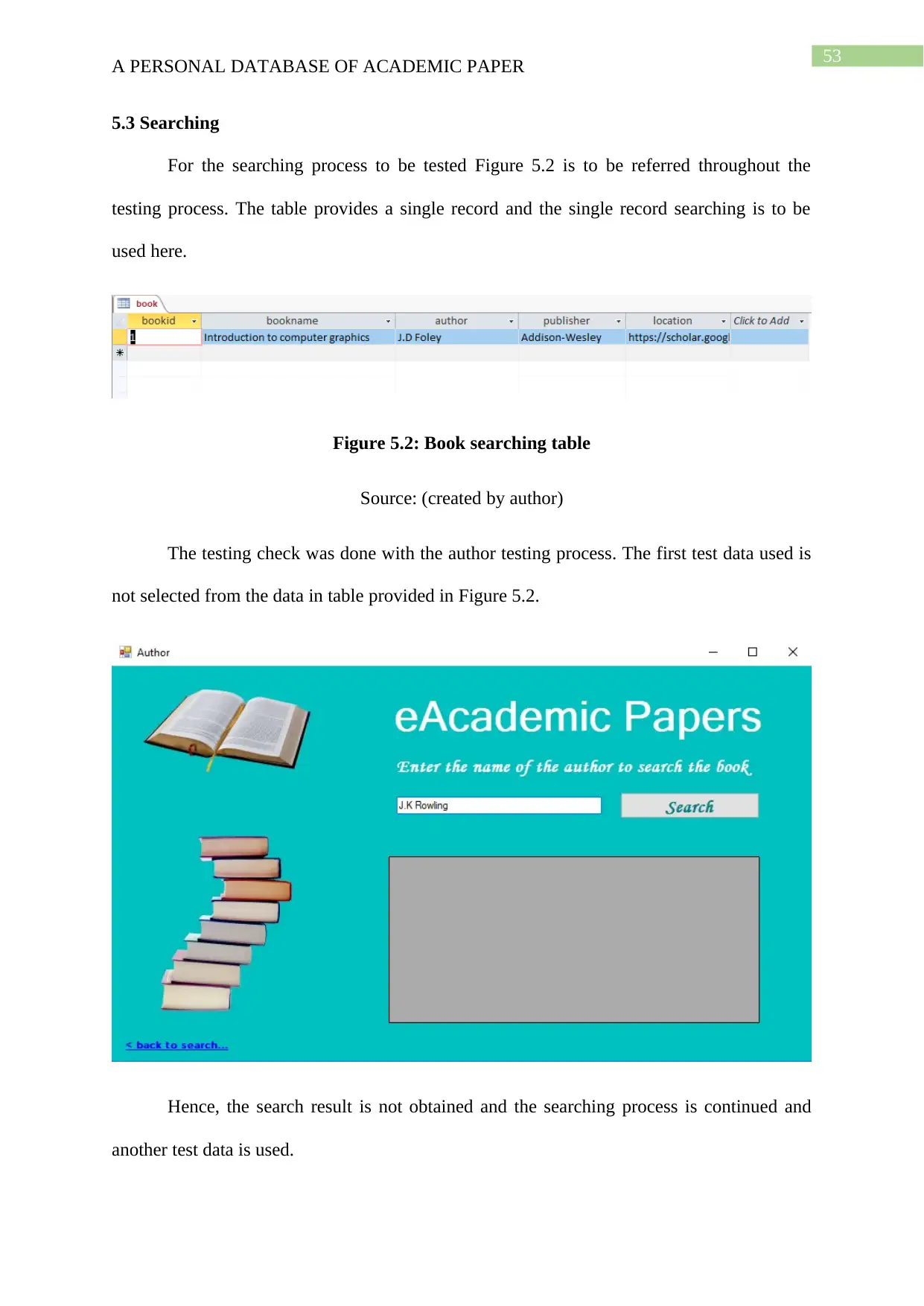
53
A PERSONAL DATABASE OF ACADEMIC PAPER
5.3 Searching
For the searching process to be tested Figure 5.2 is to be referred throughout the
testing process. The table provides a single record and the single record searching is to be
used here.
Figure 5.2: Book searching table
Source: (created by author)
The testing check was done with the author testing process. The first test data used is
not selected from the data in table provided in Figure 5.2.
Hence, the search result is not obtained and the searching process is continued and
another test data is used.
A PERSONAL DATABASE OF ACADEMIC PAPER
5.3 Searching
For the searching process to be tested Figure 5.2 is to be referred throughout the
testing process. The table provides a single record and the single record searching is to be
used here.
Figure 5.2: Book searching table
Source: (created by author)
The testing check was done with the author testing process. The first test data used is
not selected from the data in table provided in Figure 5.2.
Hence, the search result is not obtained and the searching process is continued and
another test data is used.
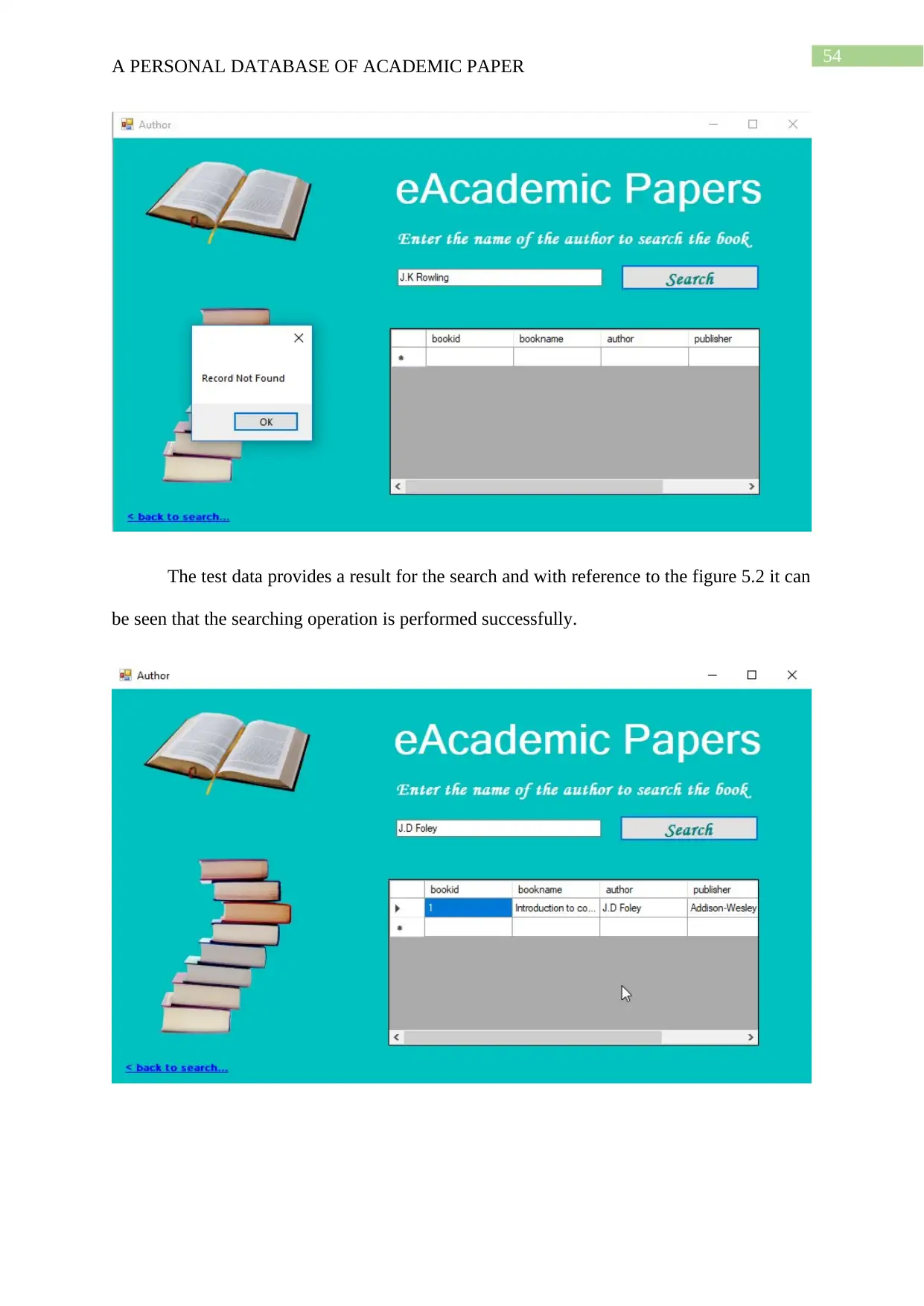
54
A PERSONAL DATABASE OF ACADEMIC PAPER
The test data provides a result for the search and with reference to the figure 5.2 it can
be seen that the searching operation is performed successfully.
A PERSONAL DATABASE OF ACADEMIC PAPER
The test data provides a result for the search and with reference to the figure 5.2 it can
be seen that the searching operation is performed successfully.
Paraphrase This Document
Need a fresh take? Get an instant paraphrase of this document with our AI Paraphraser

55
A PERSONAL DATABASE OF ACADEMIC PAPER
5.4 Insertion
For insertion testing a sample data as displayed below is used.
A PERSONAL DATABASE OF ACADEMIC PAPER
5.4 Insertion
For insertion testing a sample data as displayed below is used.

56
A PERSONAL DATABASE OF ACADEMIC PAPER
However, an error is faced in the system as the primary key constraint is failed by the
application. After the set of the data receives an error another test data is tried as displayed
below:
The record does not match the id as displayed in Figure 5.1 and hence the record is
saved successfully.
5.5 Deletion
For the deletion at first the search for the ID is done as displayed below.
A PERSONAL DATABASE OF ACADEMIC PAPER
However, an error is faced in the system as the primary key constraint is failed by the
application. After the set of the data receives an error another test data is tried as displayed
below:
The record does not match the id as displayed in Figure 5.1 and hence the record is
saved successfully.
5.5 Deletion
For the deletion at first the search for the ID is done as displayed below.
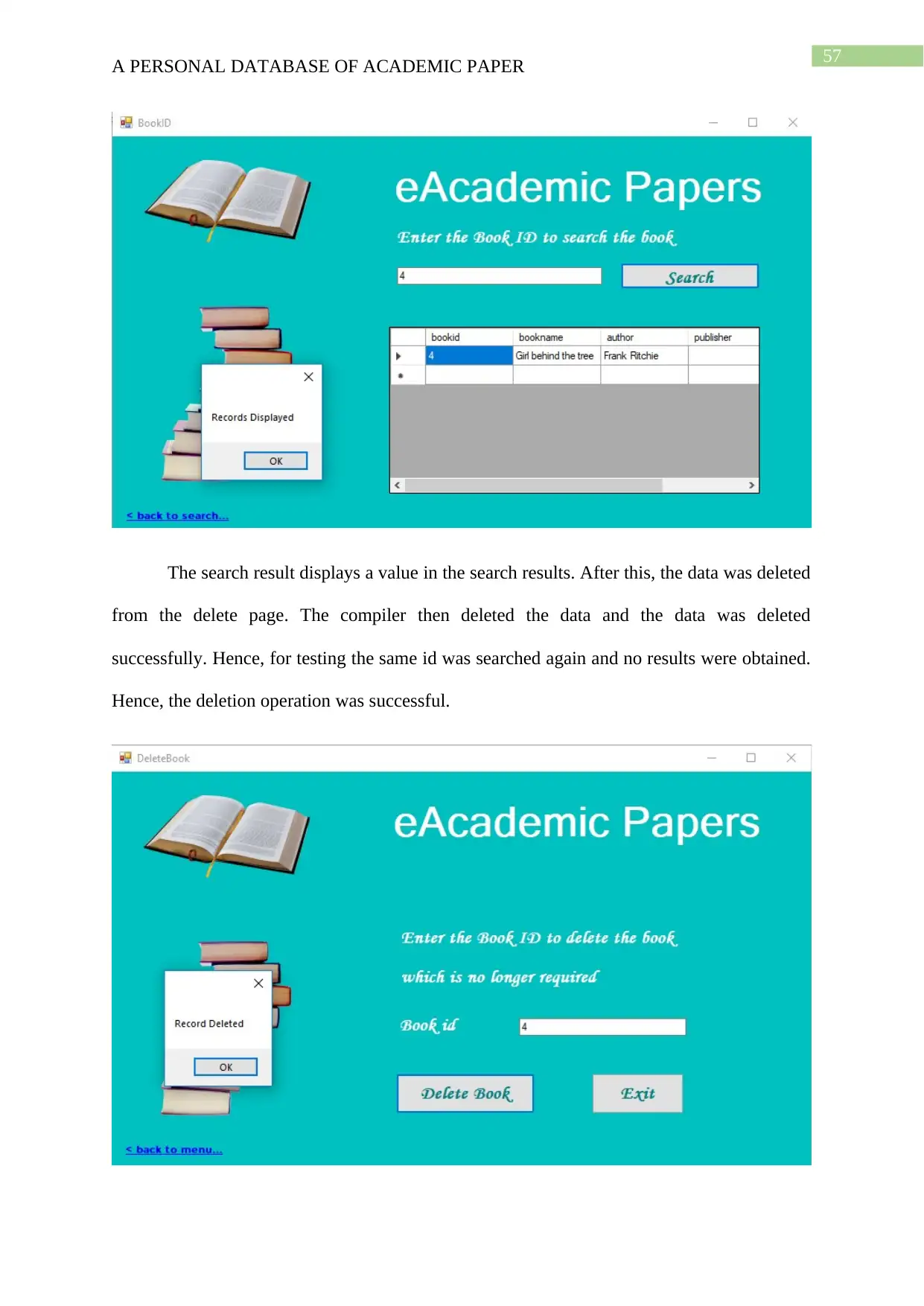
57
A PERSONAL DATABASE OF ACADEMIC PAPER
The search result displays a value in the search results. After this, the data was deleted
from the delete page. The compiler then deleted the data and the data was deleted
successfully. Hence, for testing the same id was searched again and no results were obtained.
Hence, the deletion operation was successful.
A PERSONAL DATABASE OF ACADEMIC PAPER
The search result displays a value in the search results. After this, the data was deleted
from the delete page. The compiler then deleted the data and the data was deleted
successfully. Hence, for testing the same id was searched again and no results were obtained.
Hence, the deletion operation was successful.
Secure Best Marks with AI Grader
Need help grading? Try our AI Grader for instant feedback on your assignments.

58
A PERSONAL DATABASE OF ACADEMIC PAPER
Chapter 6 - Conclusion
A PERSONAL DATABASE OF ACADEMIC PAPER
Chapter 6 - Conclusion
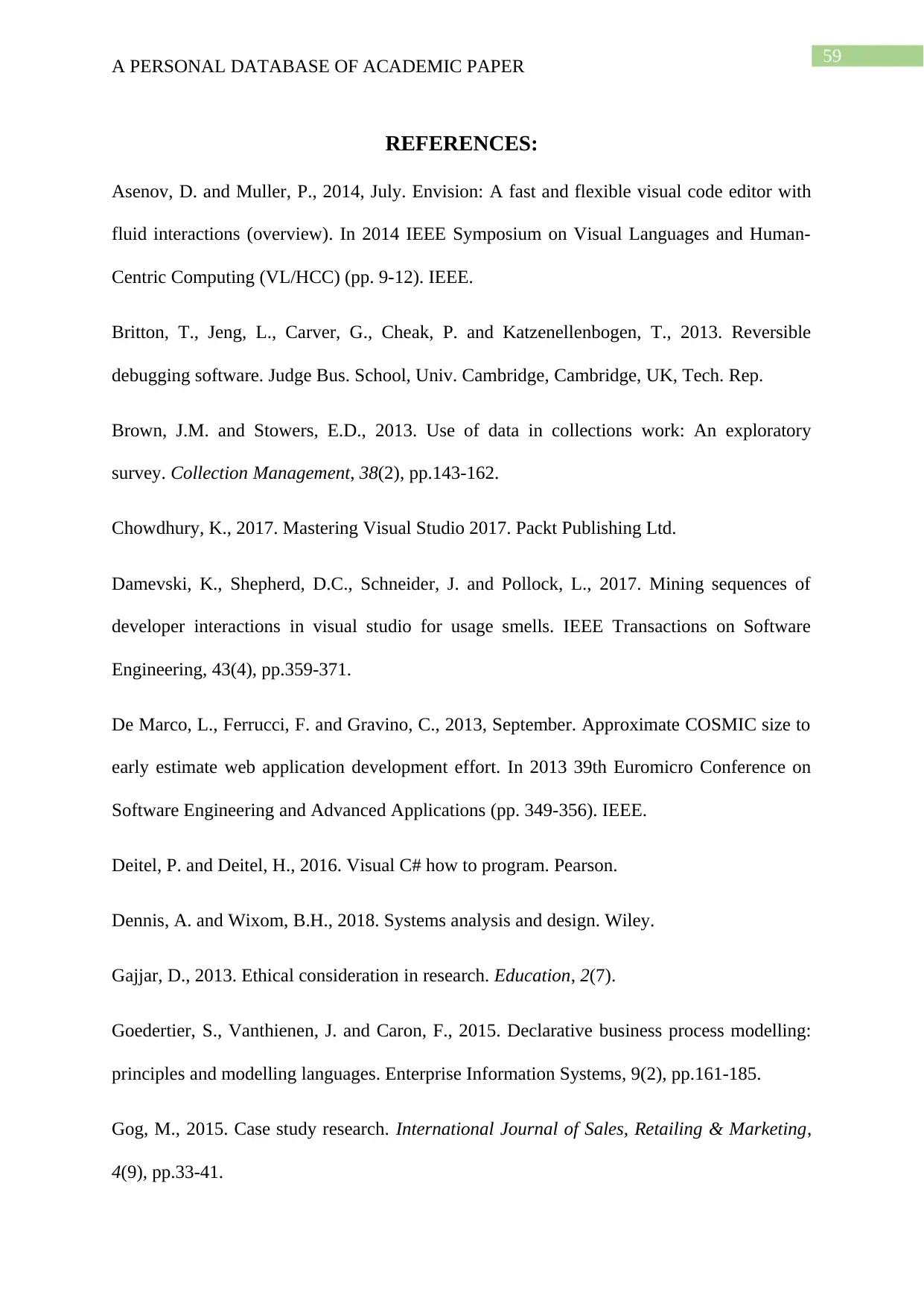
59
A PERSONAL DATABASE OF ACADEMIC PAPER
REFERENCES:
Asenov, D. and Muller, P., 2014, July. Envision: A fast and flexible visual code editor with
fluid interactions (overview). In 2014 IEEE Symposium on Visual Languages and Human-
Centric Computing (VL/HCC) (pp. 9-12). IEEE.
Britton, T., Jeng, L., Carver, G., Cheak, P. and Katzenellenbogen, T., 2013. Reversible
debugging software. Judge Bus. School, Univ. Cambridge, Cambridge, UK, Tech. Rep.
Brown, J.M. and Stowers, E.D., 2013. Use of data in collections work: An exploratory
survey. Collection Management, 38(2), pp.143-162.
Chowdhury, K., 2017. Mastering Visual Studio 2017. Packt Publishing Ltd.
Damevski, K., Shepherd, D.C., Schneider, J. and Pollock, L., 2017. Mining sequences of
developer interactions in visual studio for usage smells. IEEE Transactions on Software
Engineering, 43(4), pp.359-371.
De Marco, L., Ferrucci, F. and Gravino, C., 2013, September. Approximate COSMIC size to
early estimate web application development effort. In 2013 39th Euromicro Conference on
Software Engineering and Advanced Applications (pp. 349-356). IEEE.
Deitel, P. and Deitel, H., 2016. Visual C# how to program. Pearson.
Dennis, A. and Wixom, B.H., 2018. Systems analysis and design. Wiley.
Gajjar, D., 2013. Ethical consideration in research. Education, 2(7).
Goedertier, S., Vanthienen, J. and Caron, F., 2015. Declarative business process modelling:
principles and modelling languages. Enterprise Information Systems, 9(2), pp.161-185.
Gog, M., 2015. Case study research. International Journal of Sales, Retailing & Marketing,
4(9), pp.33-41.
A PERSONAL DATABASE OF ACADEMIC PAPER
REFERENCES:
Asenov, D. and Muller, P., 2014, July. Envision: A fast and flexible visual code editor with
fluid interactions (overview). In 2014 IEEE Symposium on Visual Languages and Human-
Centric Computing (VL/HCC) (pp. 9-12). IEEE.
Britton, T., Jeng, L., Carver, G., Cheak, P. and Katzenellenbogen, T., 2013. Reversible
debugging software. Judge Bus. School, Univ. Cambridge, Cambridge, UK, Tech. Rep.
Brown, J.M. and Stowers, E.D., 2013. Use of data in collections work: An exploratory
survey. Collection Management, 38(2), pp.143-162.
Chowdhury, K., 2017. Mastering Visual Studio 2017. Packt Publishing Ltd.
Damevski, K., Shepherd, D.C., Schneider, J. and Pollock, L., 2017. Mining sequences of
developer interactions in visual studio for usage smells. IEEE Transactions on Software
Engineering, 43(4), pp.359-371.
De Marco, L., Ferrucci, F. and Gravino, C., 2013, September. Approximate COSMIC size to
early estimate web application development effort. In 2013 39th Euromicro Conference on
Software Engineering and Advanced Applications (pp. 349-356). IEEE.
Deitel, P. and Deitel, H., 2016. Visual C# how to program. Pearson.
Dennis, A. and Wixom, B.H., 2018. Systems analysis and design. Wiley.
Gajjar, D., 2013. Ethical consideration in research. Education, 2(7).
Goedertier, S., Vanthienen, J. and Caron, F., 2015. Declarative business process modelling:
principles and modelling languages. Enterprise Information Systems, 9(2), pp.161-185.
Gog, M., 2015. Case study research. International Journal of Sales, Retailing & Marketing,
4(9), pp.33-41.
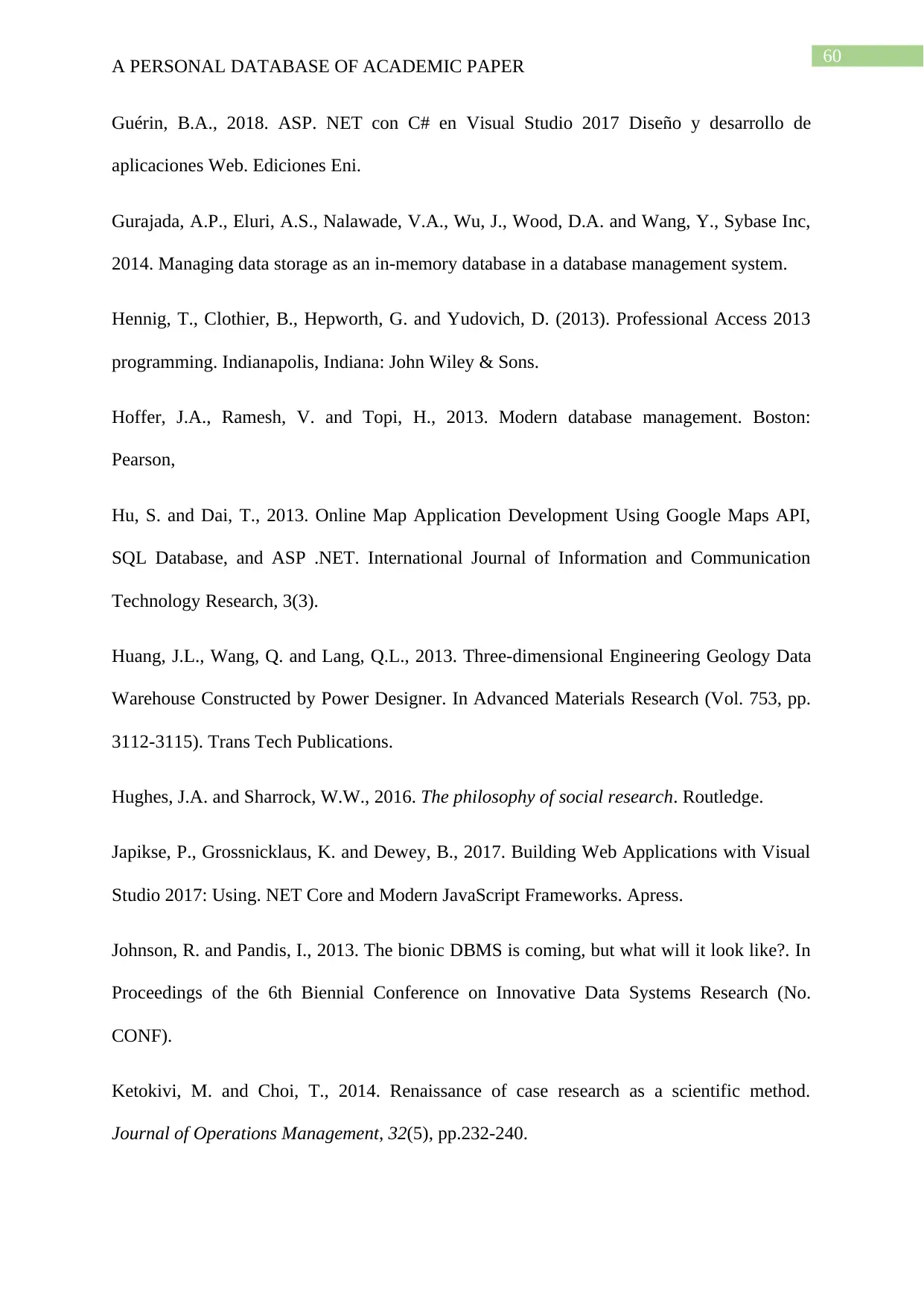
60
A PERSONAL DATABASE OF ACADEMIC PAPER
Guérin, B.A., 2018. ASP. NET con C# en Visual Studio 2017 Diseño y desarrollo de
aplicaciones Web. Ediciones Eni.
Gurajada, A.P., Eluri, A.S., Nalawade, V.A., Wu, J., Wood, D.A. and Wang, Y., Sybase Inc,
2014. Managing data storage as an in-memory database in a database management system.
Hennig, T., Clothier, B., Hepworth, G. and Yudovich, D. (2013). Professional Access 2013
programming. Indianapolis, Indiana: John Wiley & Sons.
Hoffer, J.A., Ramesh, V. and Topi, H., 2013. Modern database management. Boston:
Pearson,
Hu, S. and Dai, T., 2013. Online Map Application Development Using Google Maps API,
SQL Database, and ASP .NET. International Journal of Information and Communication
Technology Research, 3(3).
Huang, J.L., Wang, Q. and Lang, Q.L., 2013. Three-dimensional Engineering Geology Data
Warehouse Constructed by Power Designer. In Advanced Materials Research (Vol. 753, pp.
3112-3115). Trans Tech Publications.
Hughes, J.A. and Sharrock, W.W., 2016. The philosophy of social research. Routledge.
Japikse, P., Grossnicklaus, K. and Dewey, B., 2017. Building Web Applications with Visual
Studio 2017: Using. NET Core and Modern JavaScript Frameworks. Apress.
Johnson, R. and Pandis, I., 2013. The bionic DBMS is coming, but what will it look like?. In
Proceedings of the 6th Biennial Conference on Innovative Data Systems Research (No.
CONF).
Ketokivi, M. and Choi, T., 2014. Renaissance of case research as a scientific method.
Journal of Operations Management, 32(5), pp.232-240.
A PERSONAL DATABASE OF ACADEMIC PAPER
Guérin, B.A., 2018. ASP. NET con C# en Visual Studio 2017 Diseño y desarrollo de
aplicaciones Web. Ediciones Eni.
Gurajada, A.P., Eluri, A.S., Nalawade, V.A., Wu, J., Wood, D.A. and Wang, Y., Sybase Inc,
2014. Managing data storage as an in-memory database in a database management system.
Hennig, T., Clothier, B., Hepworth, G. and Yudovich, D. (2013). Professional Access 2013
programming. Indianapolis, Indiana: John Wiley & Sons.
Hoffer, J.A., Ramesh, V. and Topi, H., 2013. Modern database management. Boston:
Pearson,
Hu, S. and Dai, T., 2013. Online Map Application Development Using Google Maps API,
SQL Database, and ASP .NET. International Journal of Information and Communication
Technology Research, 3(3).
Huang, J.L., Wang, Q. and Lang, Q.L., 2013. Three-dimensional Engineering Geology Data
Warehouse Constructed by Power Designer. In Advanced Materials Research (Vol. 753, pp.
3112-3115). Trans Tech Publications.
Hughes, J.A. and Sharrock, W.W., 2016. The philosophy of social research. Routledge.
Japikse, P., Grossnicklaus, K. and Dewey, B., 2017. Building Web Applications with Visual
Studio 2017: Using. NET Core and Modern JavaScript Frameworks. Apress.
Johnson, R. and Pandis, I., 2013. The bionic DBMS is coming, but what will it look like?. In
Proceedings of the 6th Biennial Conference on Innovative Data Systems Research (No.
CONF).
Ketokivi, M. and Choi, T., 2014. Renaissance of case research as a scientific method.
Journal of Operations Management, 32(5), pp.232-240.
Paraphrase This Document
Need a fresh take? Get an instant paraphrase of this document with our AI Paraphraser
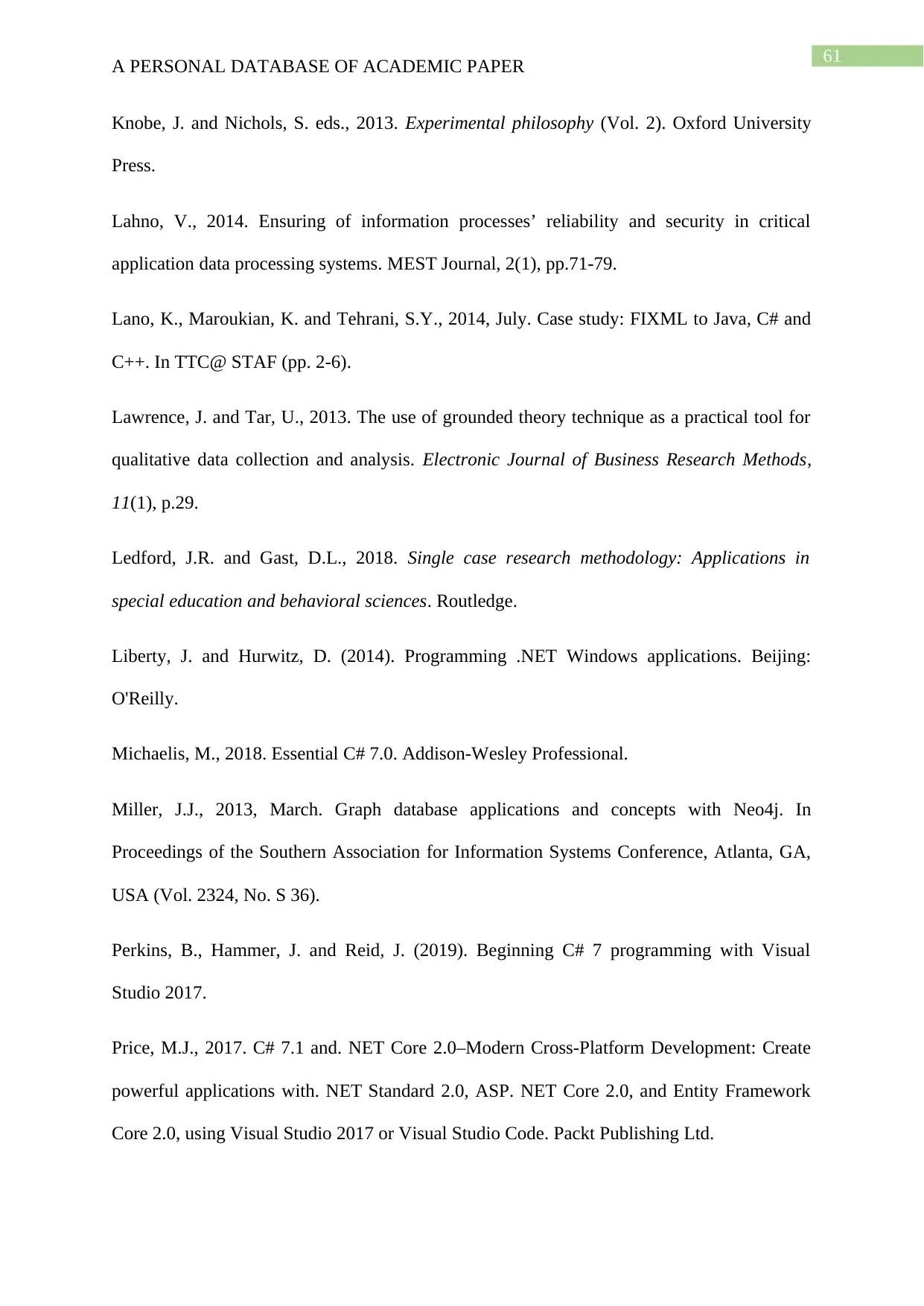
61
A PERSONAL DATABASE OF ACADEMIC PAPER
Knobe, J. and Nichols, S. eds., 2013. Experimental philosophy (Vol. 2). Oxford University
Press.
Lahno, V., 2014. Ensuring of information processes’ reliability and security in critical
application data processing systems. MEST Journal, 2(1), pp.71-79.
Lano, K., Maroukian, K. and Tehrani, S.Y., 2014, July. Case study: FIXML to Java, C# and
C++. In TTC@ STAF (pp. 2-6).
Lawrence, J. and Tar, U., 2013. The use of grounded theory technique as a practical tool for
qualitative data collection and analysis. Electronic Journal of Business Research Methods,
11(1), p.29.
Ledford, J.R. and Gast, D.L., 2018. Single case research methodology: Applications in
special education and behavioral sciences. Routledge.
Liberty, J. and Hurwitz, D. (2014). Programming .NET Windows applications. Beijing:
O'Reilly.
Michaelis, M., 2018. Essential C# 7.0. Addison-Wesley Professional.
Miller, J.J., 2013, March. Graph database applications and concepts with Neo4j. In
Proceedings of the Southern Association for Information Systems Conference, Atlanta, GA,
USA (Vol. 2324, No. S 36).
Perkins, B., Hammer, J. and Reid, J. (2019). Beginning C# 7 programming with Visual
Studio 2017.
Price, M.J., 2017. C# 7.1 and. NET Core 2.0–Modern Cross-Platform Development: Create
powerful applications with. NET Standard 2.0, ASP. NET Core 2.0, and Entity Framework
Core 2.0, using Visual Studio 2017 or Visual Studio Code. Packt Publishing Ltd.
A PERSONAL DATABASE OF ACADEMIC PAPER
Knobe, J. and Nichols, S. eds., 2013. Experimental philosophy (Vol. 2). Oxford University
Press.
Lahno, V., 2014. Ensuring of information processes’ reliability and security in critical
application data processing systems. MEST Journal, 2(1), pp.71-79.
Lano, K., Maroukian, K. and Tehrani, S.Y., 2014, July. Case study: FIXML to Java, C# and
C++. In TTC@ STAF (pp. 2-6).
Lawrence, J. and Tar, U., 2013. The use of grounded theory technique as a practical tool for
qualitative data collection and analysis. Electronic Journal of Business Research Methods,
11(1), p.29.
Ledford, J.R. and Gast, D.L., 2018. Single case research methodology: Applications in
special education and behavioral sciences. Routledge.
Liberty, J. and Hurwitz, D. (2014). Programming .NET Windows applications. Beijing:
O'Reilly.
Michaelis, M., 2018. Essential C# 7.0. Addison-Wesley Professional.
Miller, J.J., 2013, March. Graph database applications and concepts with Neo4j. In
Proceedings of the Southern Association for Information Systems Conference, Atlanta, GA,
USA (Vol. 2324, No. S 36).
Perkins, B., Hammer, J. and Reid, J. (2019). Beginning C# 7 programming with Visual
Studio 2017.
Price, M.J., 2017. C# 7.1 and. NET Core 2.0–Modern Cross-Platform Development: Create
powerful applications with. NET Standard 2.0, ASP. NET Core 2.0, and Entity Framework
Core 2.0, using Visual Studio 2017 or Visual Studio Code. Packt Publishing Ltd.
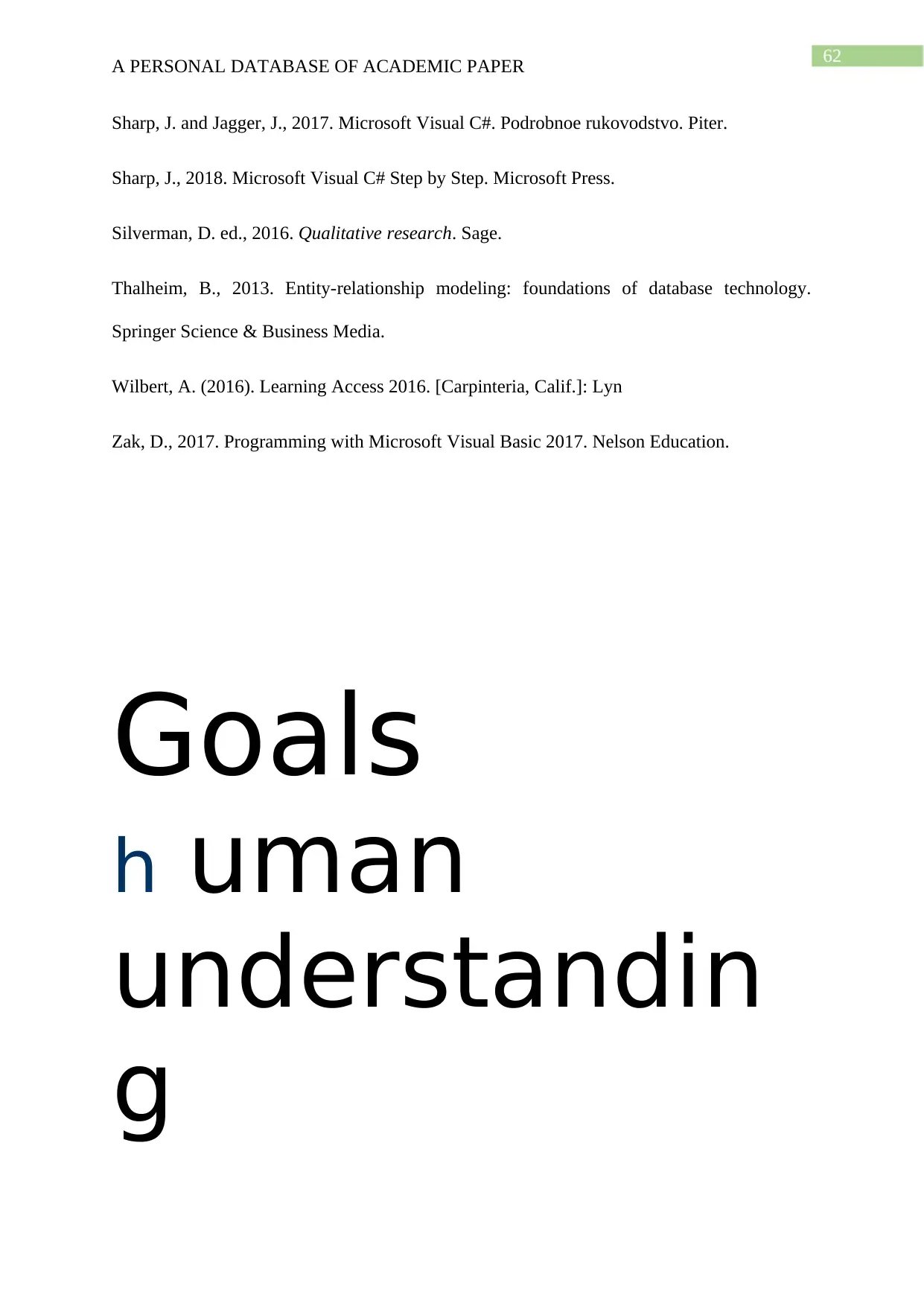
62
A PERSONAL DATABASE OF ACADEMIC PAPER
Sharp, J. and Jagger, J., 2017. Microsoft Visual C#. Podrobnoe rukovodstvo. Piter.
Sharp, J., 2018. Microsoft Visual C# Step by Step. Microsoft Press.
Silverman, D. ed., 2016. Qualitative research. Sage.
Thalheim, B., 2013. Entity-relationship modeling: foundations of database technology.
Springer Science & Business Media.
Wilbert, A. (2016). Learning Access 2016. [Carpinteria, Calif.]: Lyn
Zak, D., 2017. Programming with Microsoft Visual Basic 2017. Nelson Education.
Goals
h uman
understandin
g
A PERSONAL DATABASE OF ACADEMIC PAPER
Sharp, J. and Jagger, J., 2017. Microsoft Visual C#. Podrobnoe rukovodstvo. Piter.
Sharp, J., 2018. Microsoft Visual C# Step by Step. Microsoft Press.
Silverman, D. ed., 2016. Qualitative research. Sage.
Thalheim, B., 2013. Entity-relationship modeling: foundations of database technology.
Springer Science & Business Media.
Wilbert, A. (2016). Learning Access 2016. [Carpinteria, Calif.]: Lyn
Zak, D., 2017. Programming with Microsoft Visual Basic 2017. Nelson Education.
Goals
h uman
understandin
g
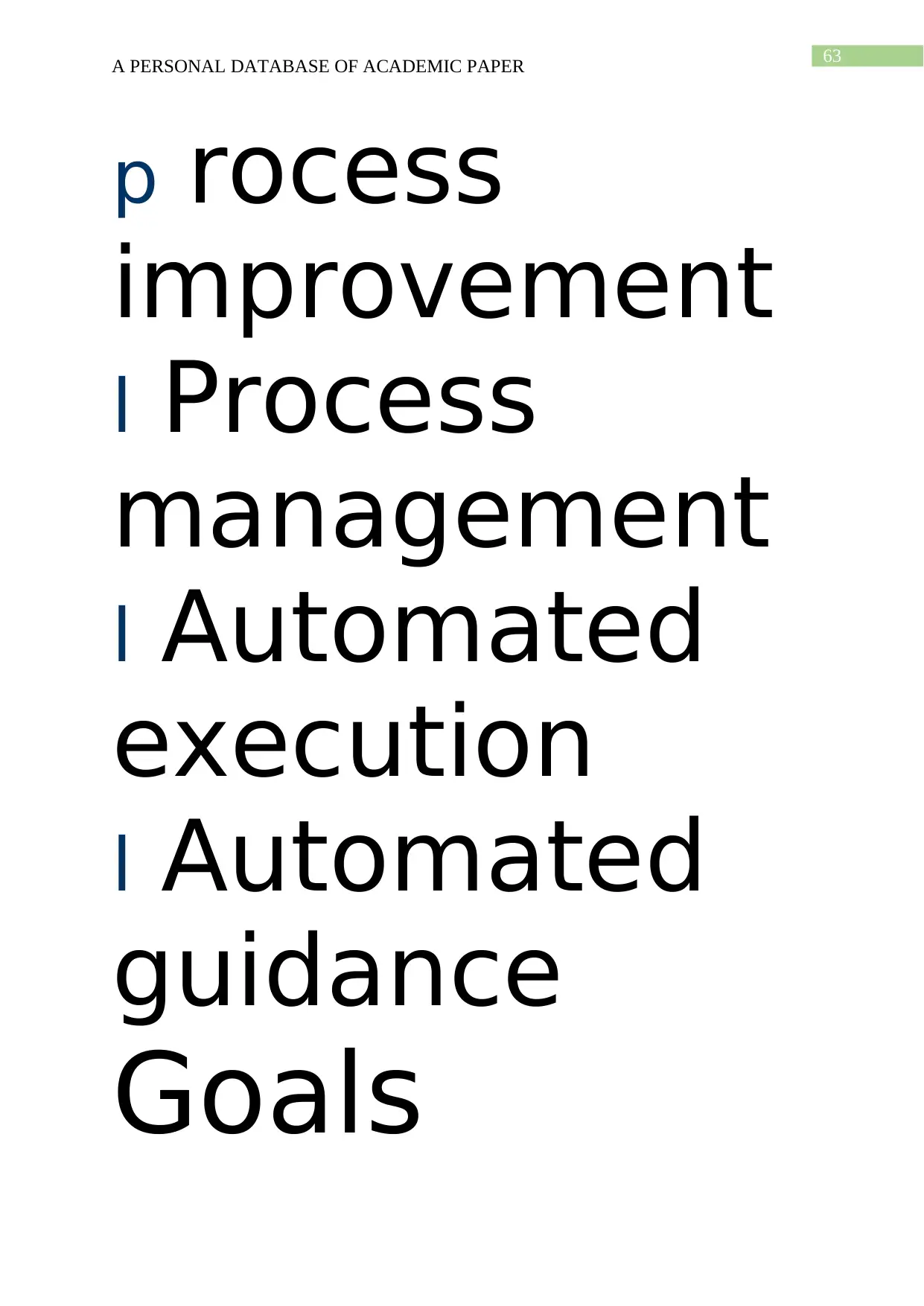
63
A PERSONAL DATABASE OF ACADEMIC PAPER
p rocess
improvement
l Process
management
l Automated
execution
l Automated
guidance
Goals
A PERSONAL DATABASE OF ACADEMIC PAPER
p rocess
improvement
l Process
management
l Automated
execution
l Automated
guidance
Goals
Secure Best Marks with AI Grader
Need help grading? Try our AI Grader for instant feedback on your assignments.
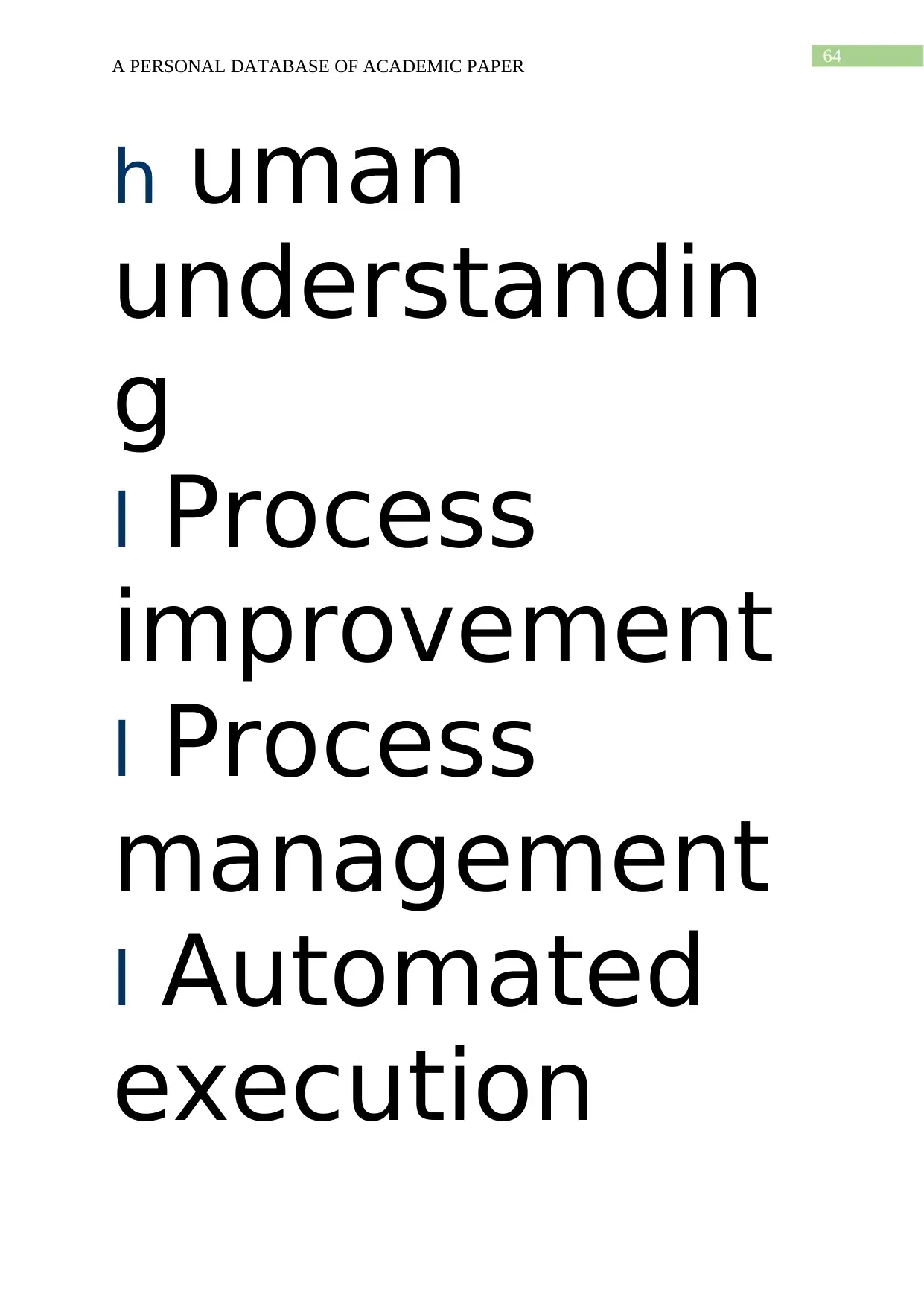
64
A PERSONAL DATABASE OF ACADEMIC PAPER
h uman
understandin
g
l Process
improvement
l Process
management
l Automated
execution
A PERSONAL DATABASE OF ACADEMIC PAPER
h uman
understandin
g
l Process
improvement
l Process
management
l Automated
execution
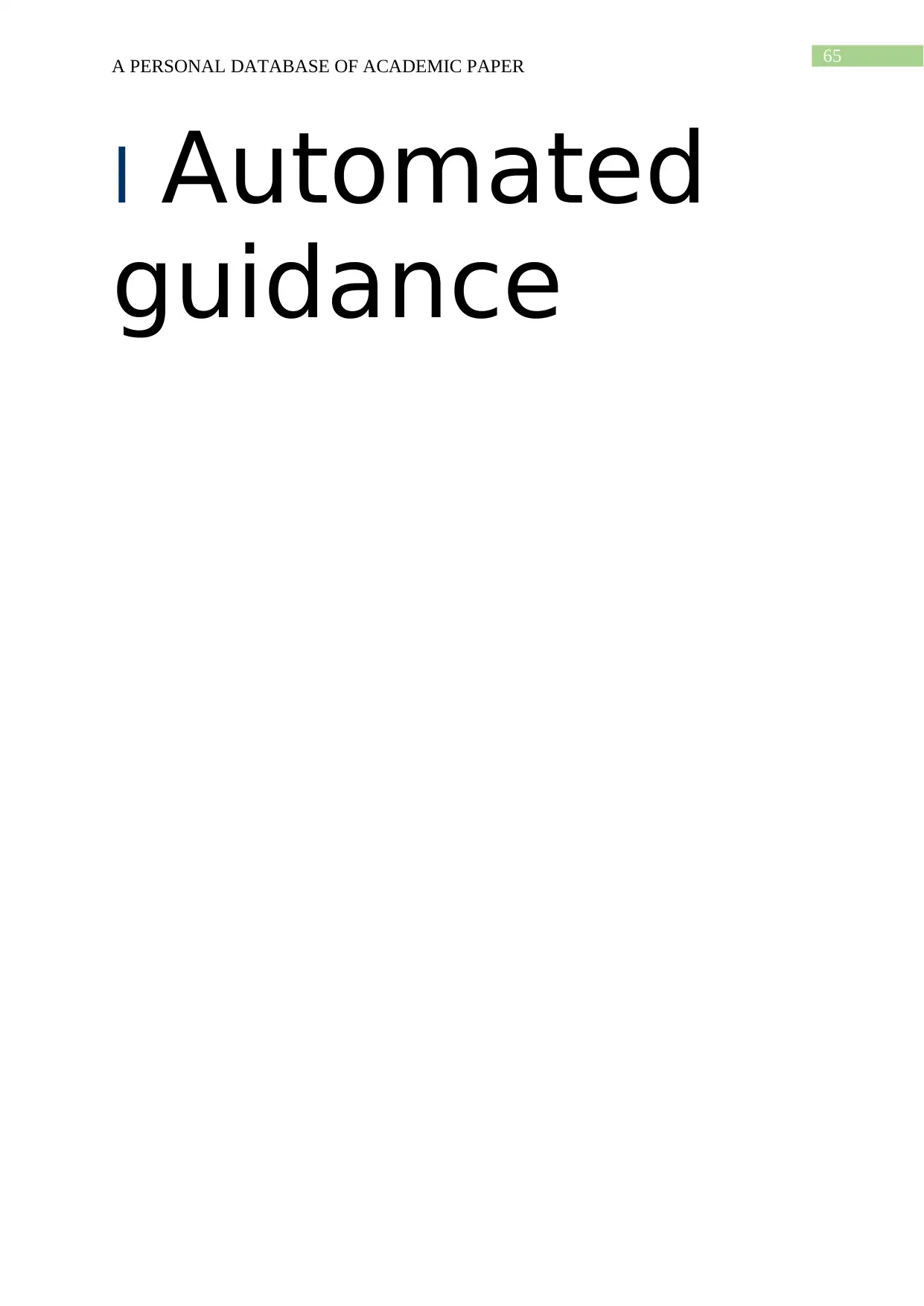
65
A PERSONAL DATABASE OF ACADEMIC PAPER
l Automated
guidance
A PERSONAL DATABASE OF ACADEMIC PAPER
l Automated
guidance
1 out of 66
Related Documents
Your All-in-One AI-Powered Toolkit for Academic Success.
+13062052269
info@desklib.com
Available 24*7 on WhatsApp / Email
![[object Object]](/_next/static/media/star-bottom.7253800d.svg)
Unlock your academic potential
© 2024 | Zucol Services PVT LTD | All rights reserved.





